This Is Our Attempt To Help You Find The Perfect Bushcraft Knife For Your Budget in 2024.
There’s surviving and then there’s thriving, and a good bushcraft knife is mostly about the latter. Whether you’d like to sit around the campfire whittling a spoon or want to make small game traps or a strong shelter, the bushcraft knife is the more specialized tool to pack along.
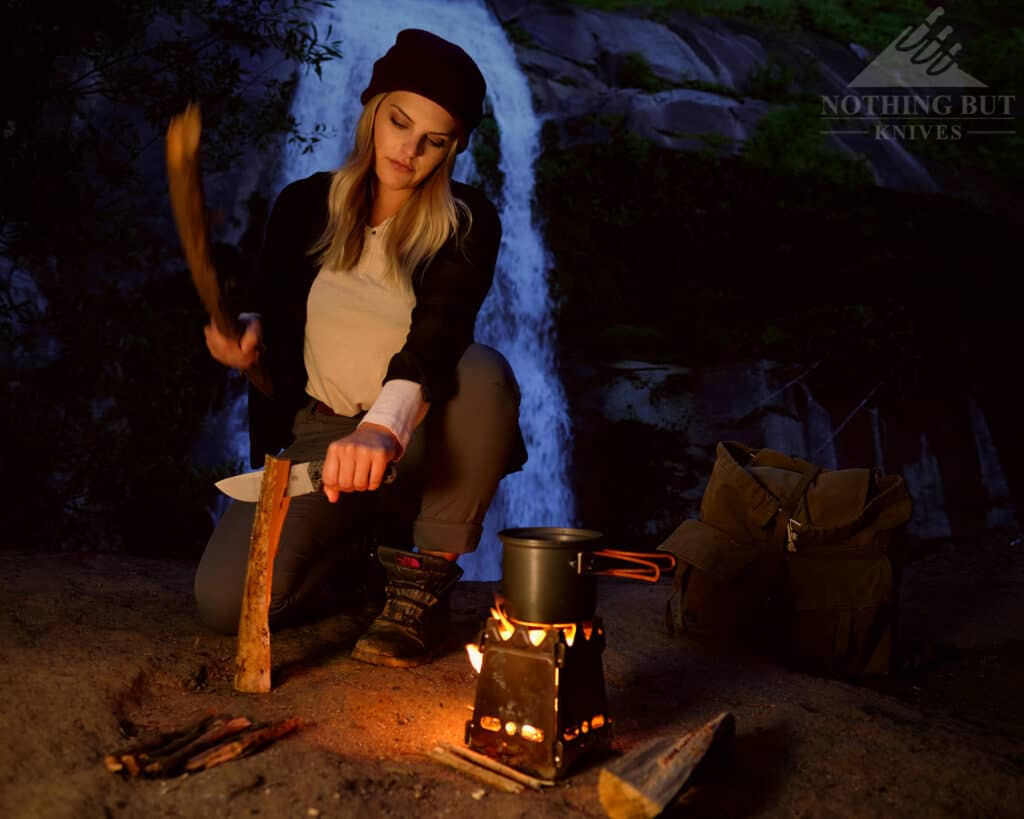
Our Top Bushcraft Knife Picks At Every Price Point.
Best Fixed Blade Bushcraft Knives Under $50
Mora is king here, but there’s a surprising variety of options in this price range. It’s tempting to think of knives this cheap as disposable up to a point, and that would be fair, maybe, but many of our picks here we’ve owned, used, and abused for years, and we still pack them all out.
Schrade Frontier SCHF52 (Toughest Budget Bushcraft Knife)
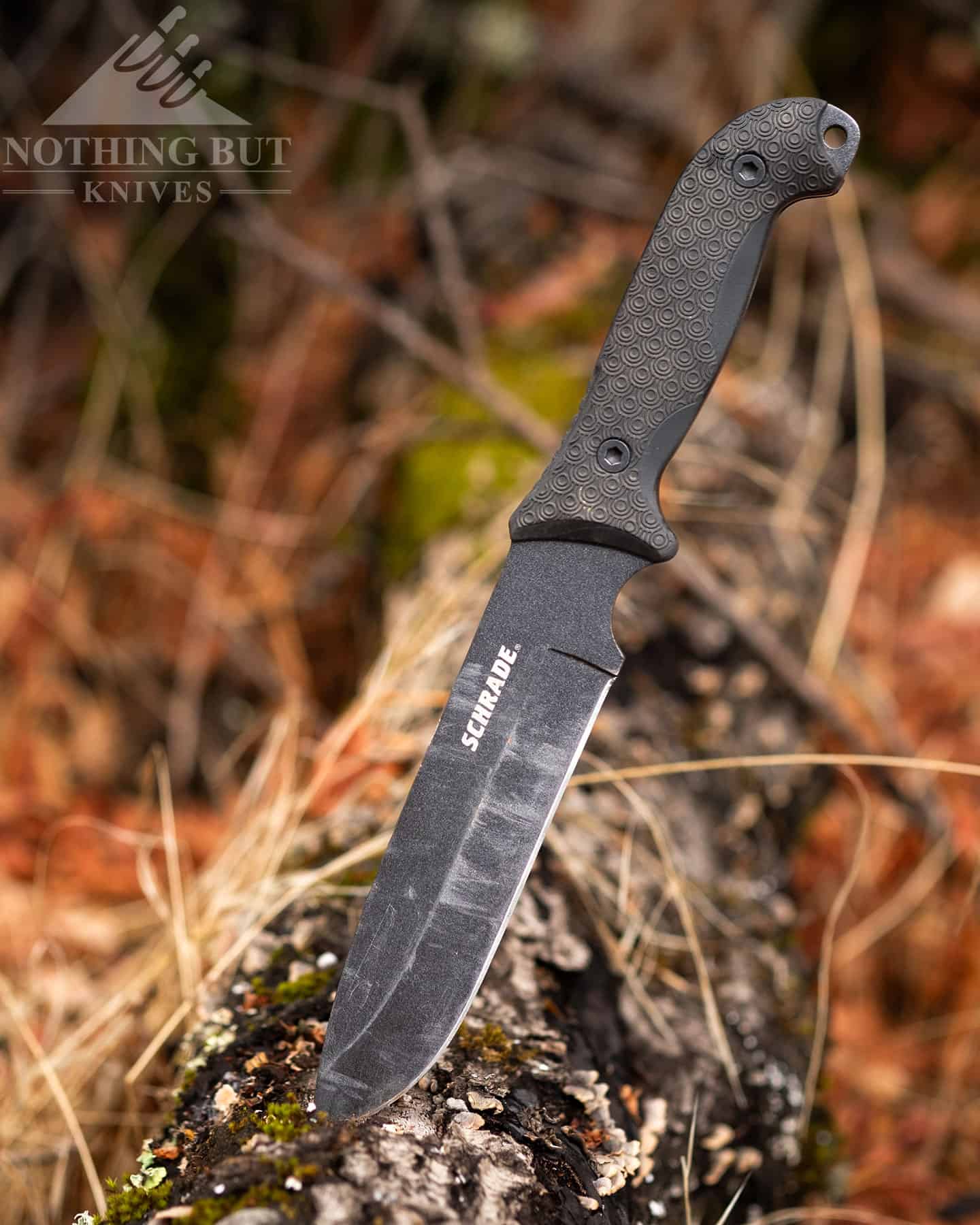
| Overall Length: | 13.0” |
| Blade Length: | 7.0” |
| Blade Steel: | 1095 |
| Blade Style: | Drop point |
| Blade Grind: | Hollow |
| Handle Material: | Rubber |
| Sheath: | Nylon |
| Made in: | China |
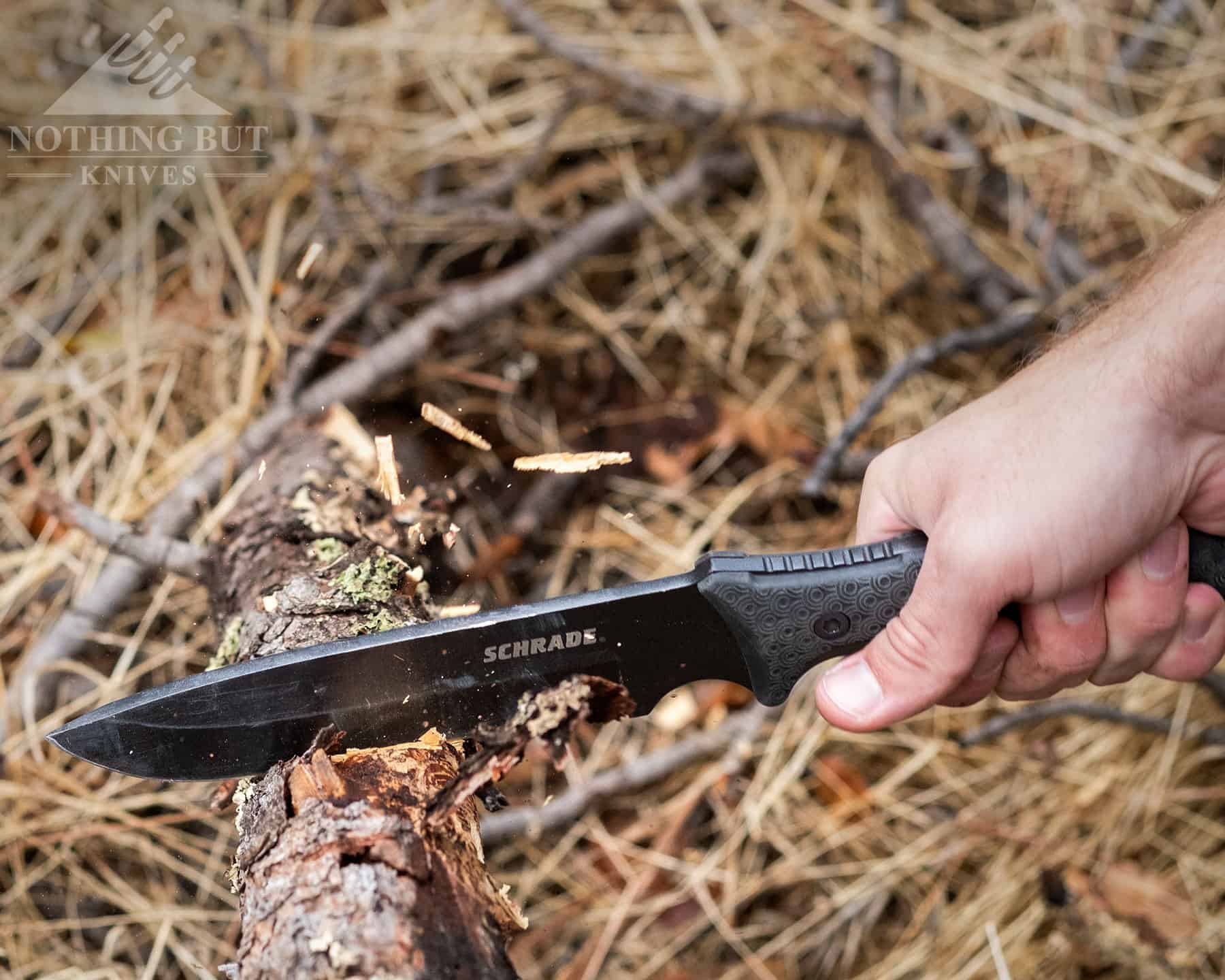
When you just need a big chunk of cheap steel to hack the brush and scare off the bears, the Schrade Frontier is about as cheap and chunky as you can reasonably get. That chunkiness has a hollow grind, though, so it actually has a bit of a bite and it’s reasonably easy to sharpen at the right angle in the field, especially since this ships with a nylon sheath that has a front pouch containing a sharpening stone and a ferro rod.
All in all, it’s a handy kit, and the pouch itself is pretty large if you want to make your own kit, although it can be a bit of a pain to sheath the knife because the plastic sleeve inside the nylon isn’t very well fitted.
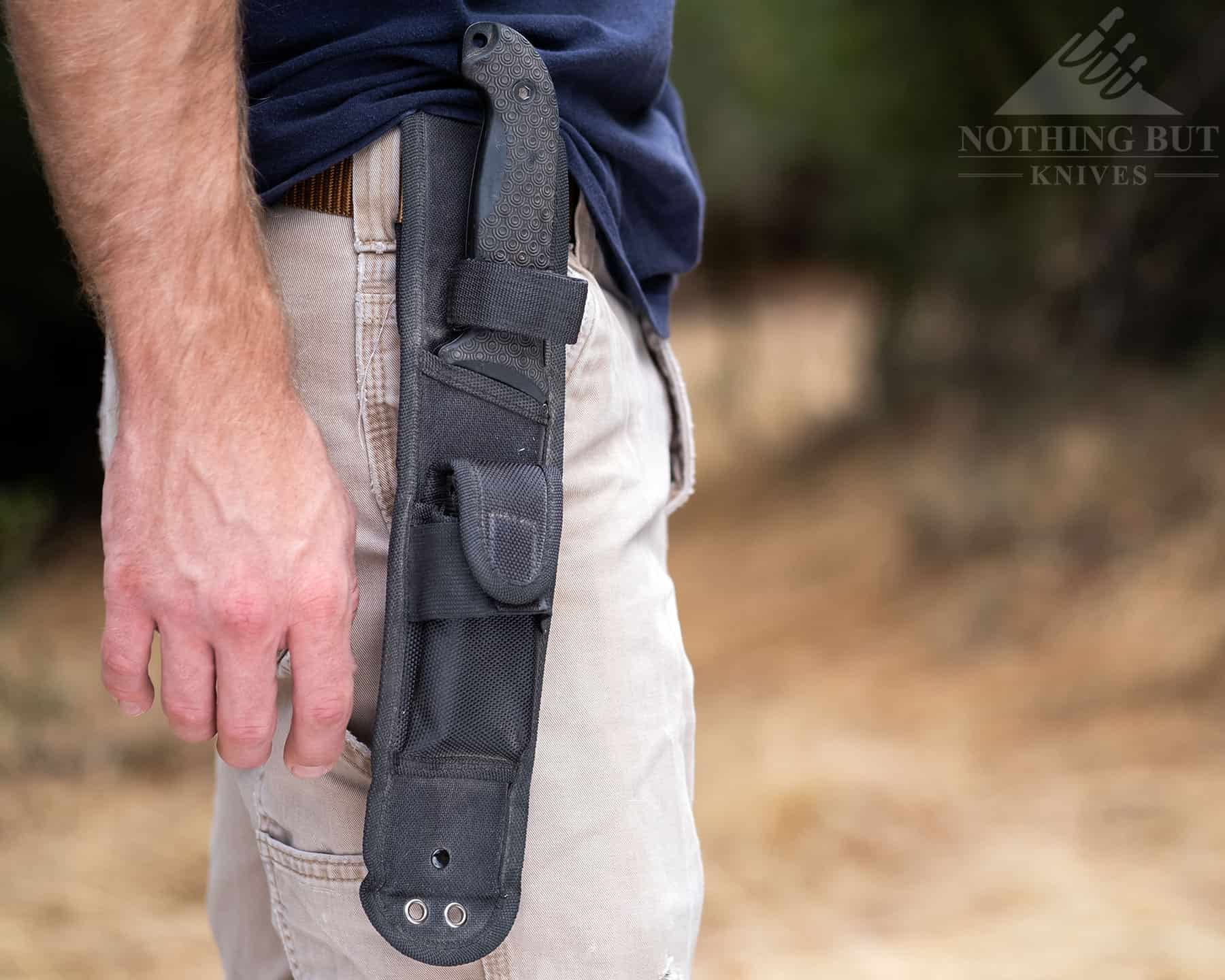
The handle is what makes the Frontier an effective tool with a lot of different uses. The hook shape at the pommel provides a good lock-in grip for chopping at one end, and the big finger choil on the blade makes it comfortable to choke up on. The overall size might be a bit big for proper carving, but the Frontier can chomp through rough work fairly easily.
Morakniv Bushcraft BlackBlade (Best Budget Bushcraft Knife)
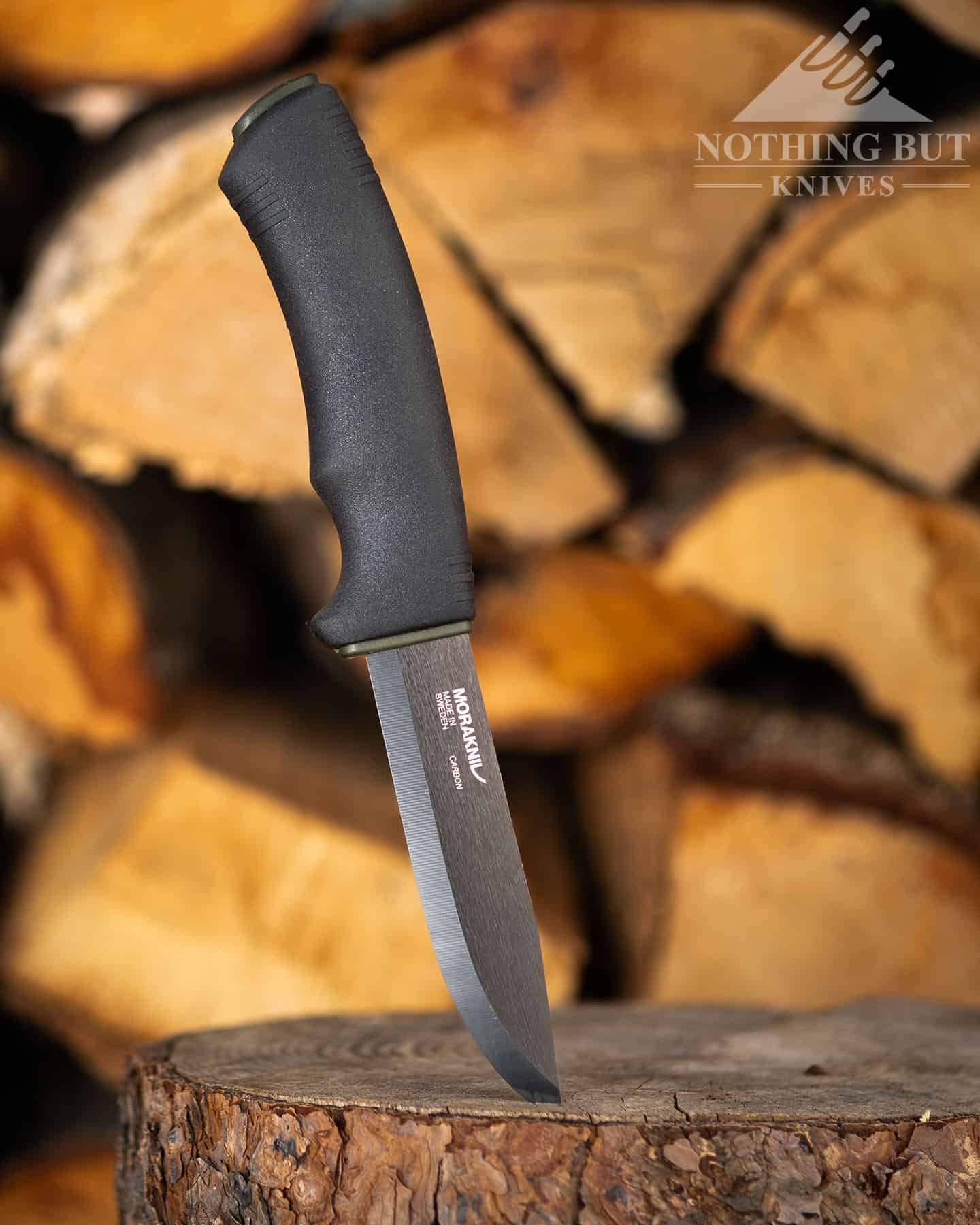
| Overall Length: | 9.15” |
| Blade Length: | 4.3” |
| Blade Steel: | High carbon |
| Blade Style: | Clip point |
| Blade Grind: | Scanid |
| Handle Material: | Rubber |
| Sheath: | Plastic |
| Made in: | Sweden |
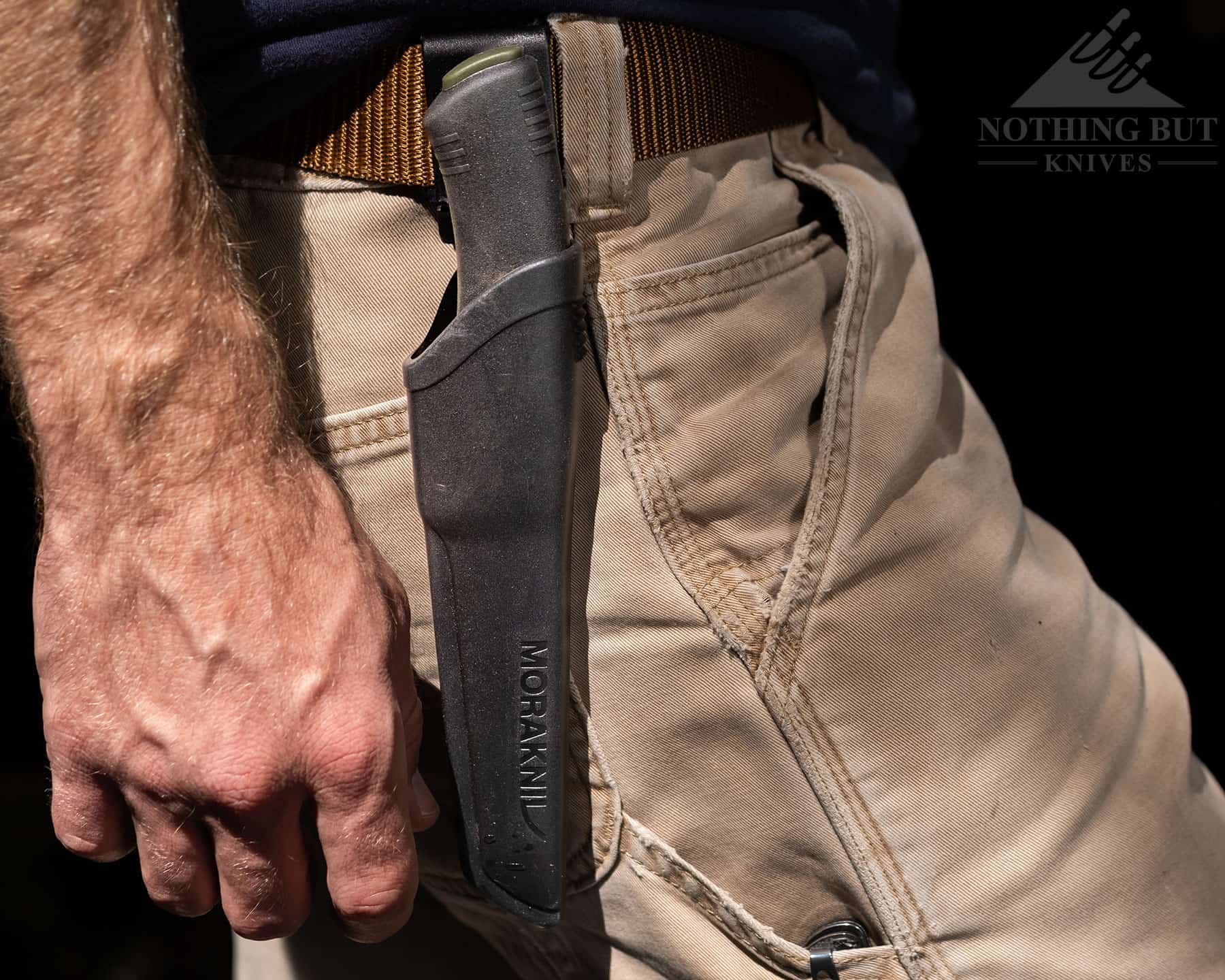
Honestly the whole category should just be this Mora Bushcraft, because it checks all the important boxes. It’s lightweight with a scandi grind that carves up wood with a hard bite and a smooth action on the follow through. The spine is a sharp 90 degrees so it’s plenty shiny with a ferro rod, and the rubber handle with a hidden tang makes it comfortable through a lot of tight-gripped work, and perfect for cold weather camping.
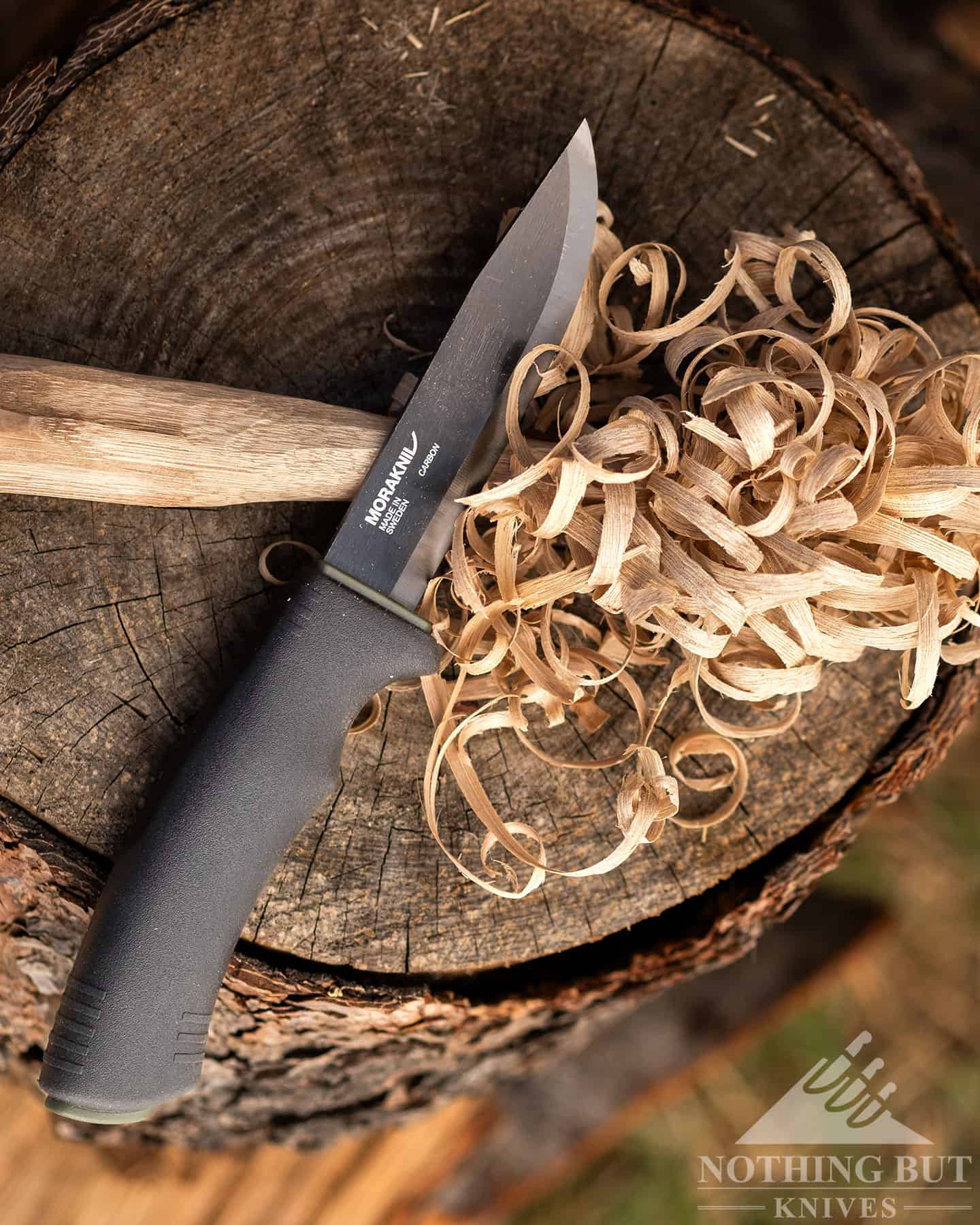
If it has drawbacks, they’re in the small size and light weight which keeps it from doing as well at tasks like chopping, and it has high carbon steel so there’s a higher risk of corrosion, but the finish helps with that quite a bit.
The sheath is also very simple. Possibly too simple for some people because there’s no loop for a ferro rod, and it can’t be modified for left-hand carry. But the rotating, drop-carry clip that comes stock on this is otherwise comfortable and easy to take on and off.
Best Fixed Bushcraft Knives under $100
You can start looking for more interesting grinds in this category. Stuff like convex edges get a little more common as the prices go up, and this seems to be the lower limit for that. The sheaths also tend to be a little fancier beyond this point.
Buck Selkirk
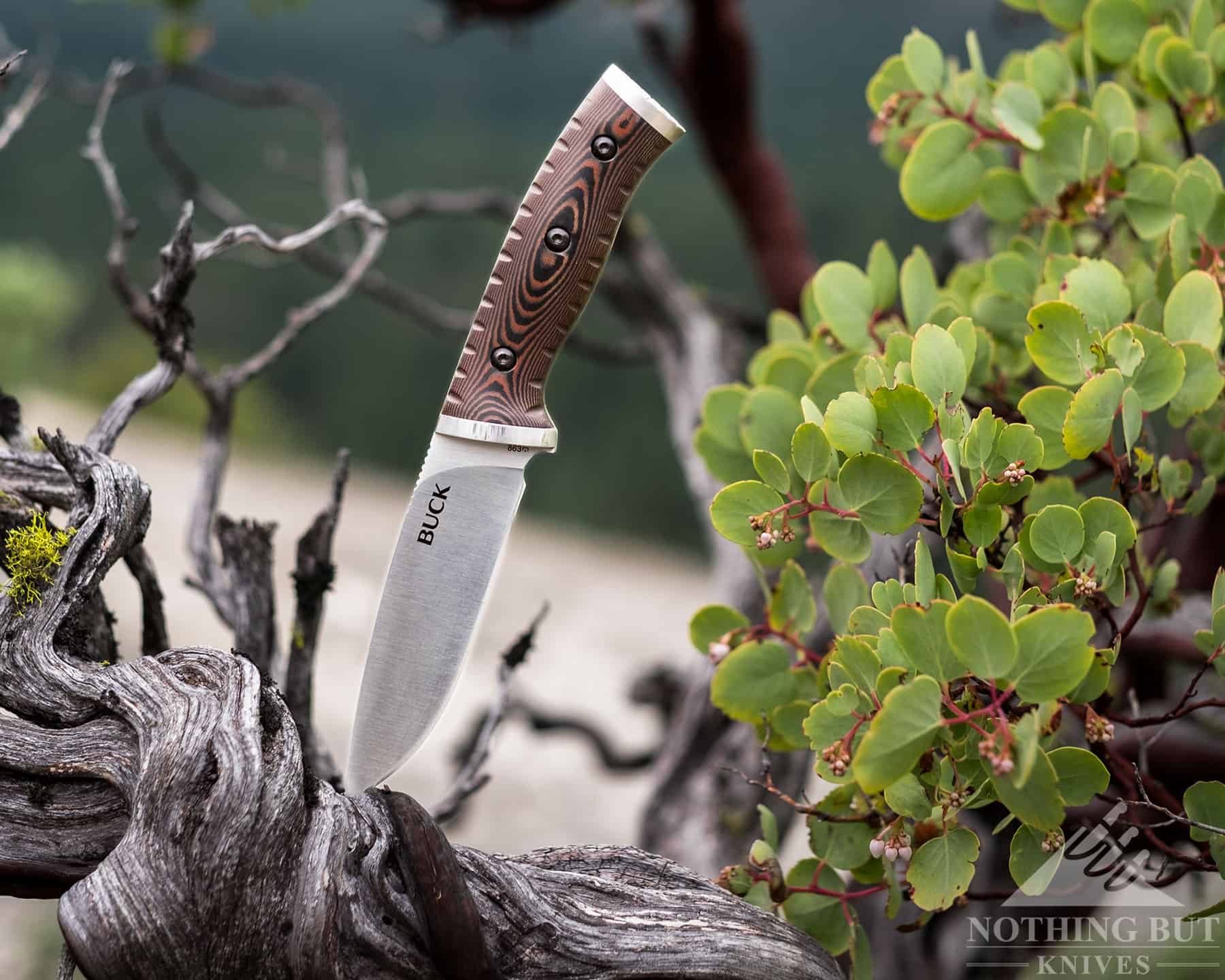
| Overall Length: | 9.25” |
| Blade Length: | 4.625” |
| Blade Steel: | 420HC |
| Blade Style: | Drop point |
| Blade Grind: | Full flat |
| Handle Material: | Micarta |
| Sheath: | Taco-style kydex |
| Made in: | China |
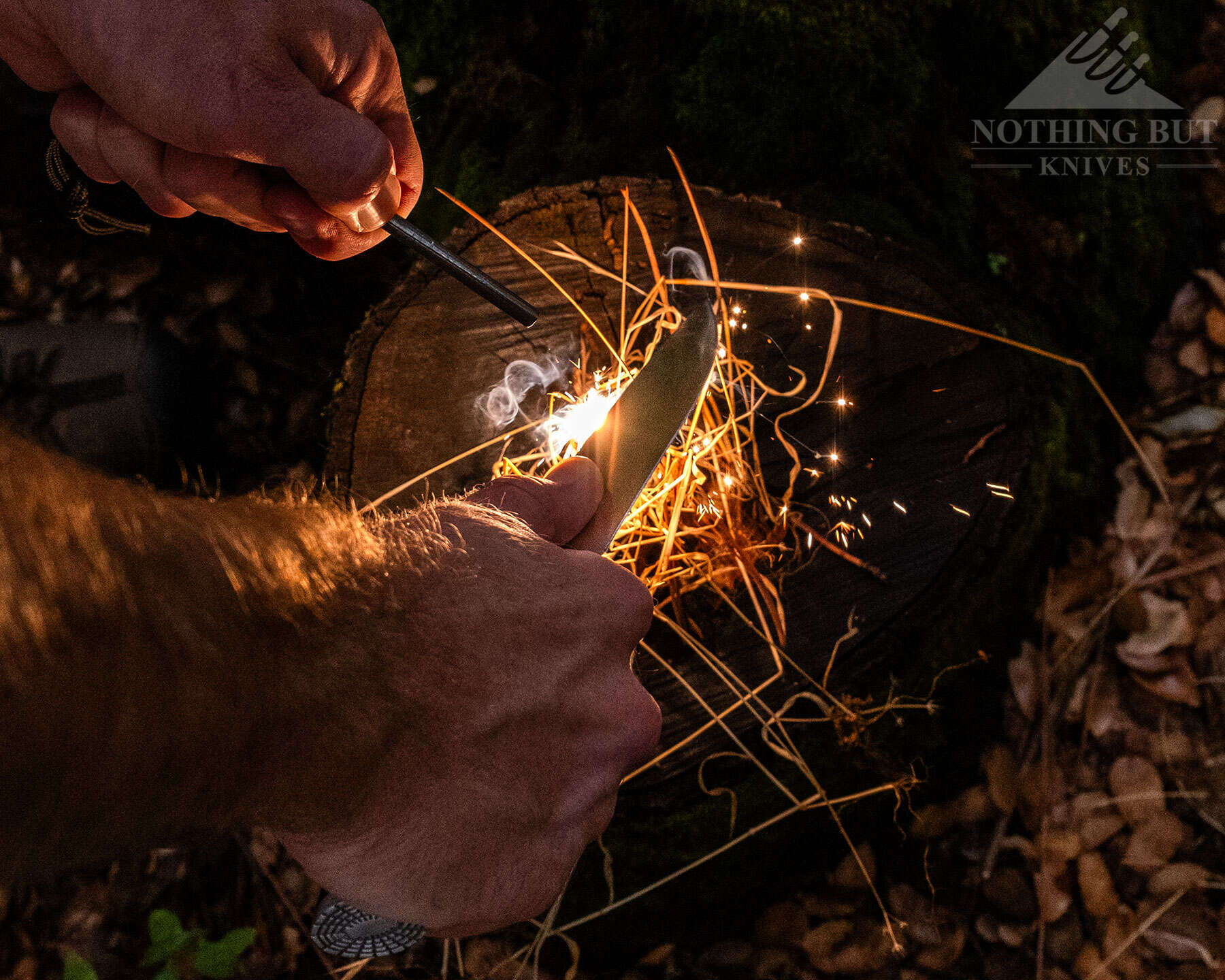
This leans more toward a hunting knife with the drop point blade and a firmly stainless steel. The handle is also pretty easy to clean in spite of being Micarta. It’s densely packed with resin, which makes the grip a little less firm, but it does make the knife highly resistant to the elements and the shape just feels good. It’s slightly contoured with a tall, oval shape that practically melts into the hand.
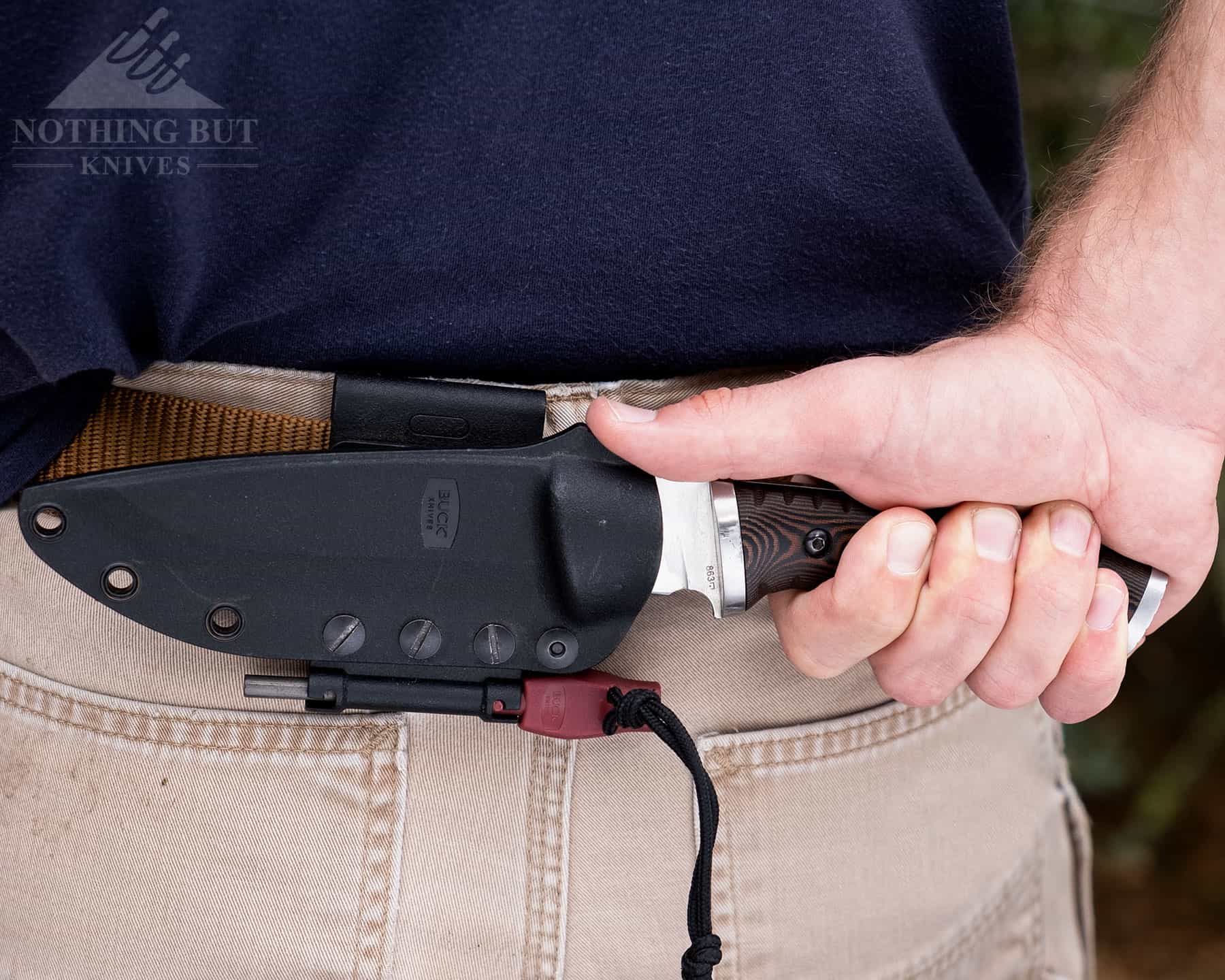
The sheath can be a little finicky at first, but it can be adapted for vertical and horizontal carry, and it rides tight on the belt once you get the thing situated. It’s great on long hikes. It’s not the lightest knife out there, but the full flat grind makes it pretty dang slicey, and if you really want to go lighter there’s a smaller version with a 3.8-inch blade.
Check out our full review of the Buck Selkirk here.
Gerber Principle (Best Small Bushcraft Knife Under $100)
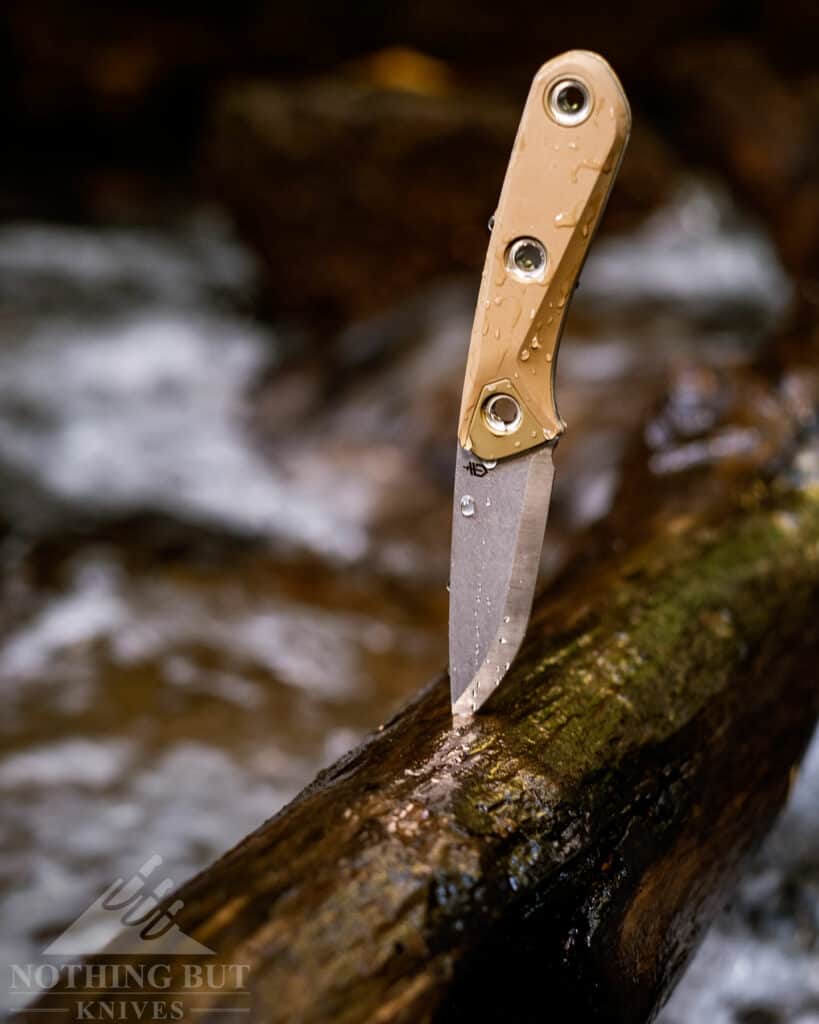
| Overall Length: | 7.5” |
| Blade Length: | 3.1” |
| Blade Steel: | 420HC |
| Blade Style: | Drop point |
| Blade Grind: | Scandi |
| Handle Material: | Rubber w/ polymer inserts |
| Sheath: | Polymer w/ MOLLE back |
| Made in: | USA |
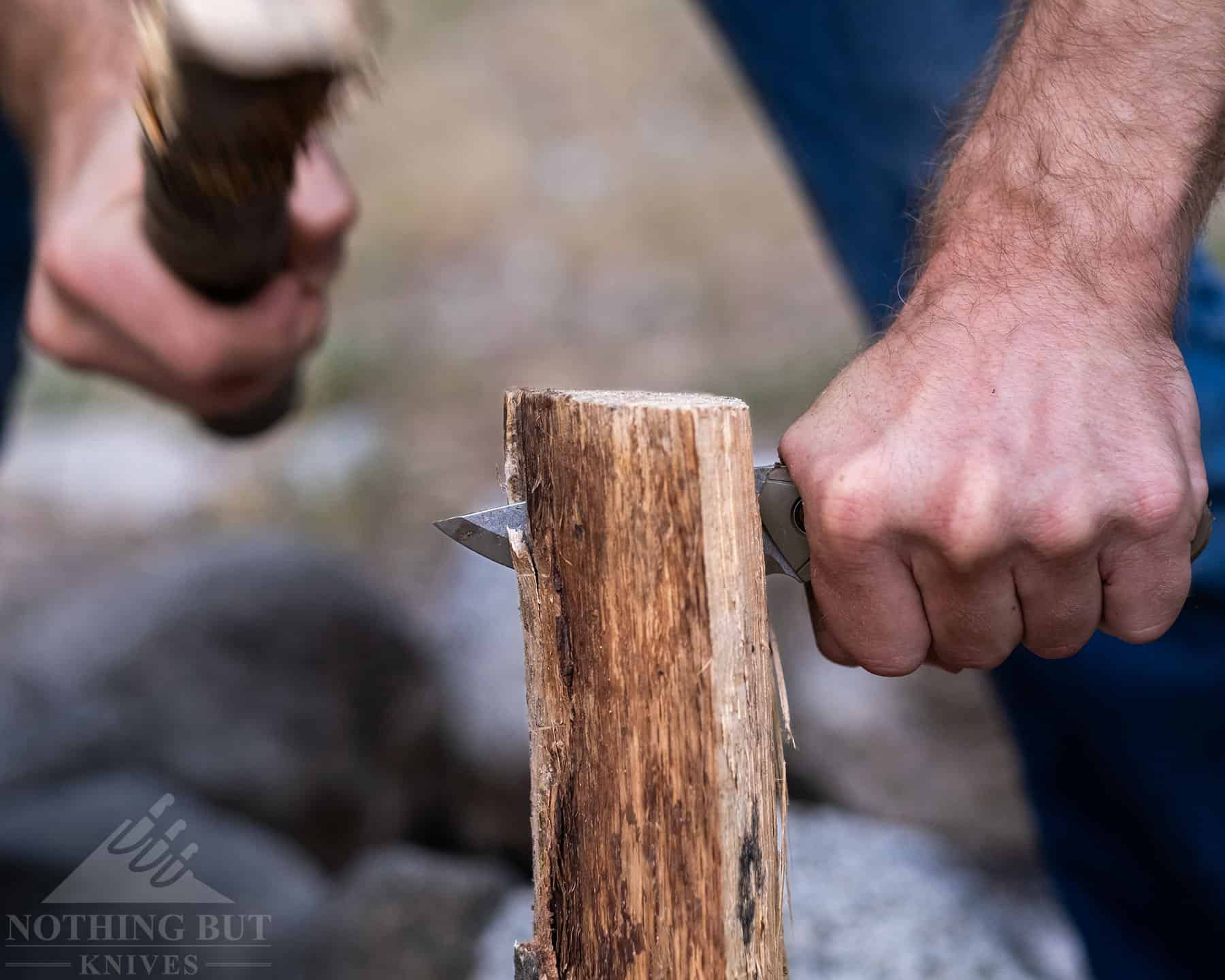
You can kind of think of the Gerber Principle as a US-made Mora that comes stock with a MOLLE-compatible sheath. The exposed full tang does make it heavier and more caustic in a freezing environment, but it’s at least as tough, and I’d say the blade handles wood carving about as well.
It was designed with three grips in mind: Hammer, pinch, and chest lever.
The sloped inserts at the top of the handle also make it a lot more comfortable in a pinch grip while the rest of the handle is mostly neutral with a hint of a coffin shape that angles forward a bit so there aren’t any hotspots in a full grip, and you can get a lot of leverage in a chest lever.
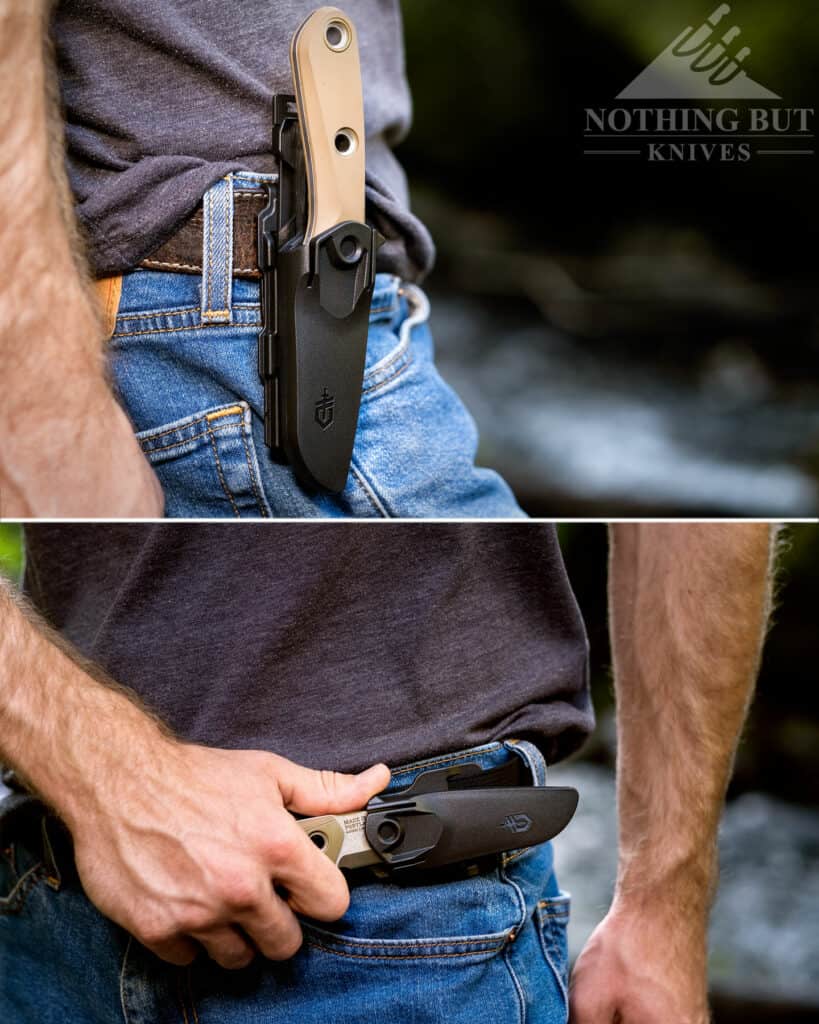
The sheath is a particularly neat innovation. It has a plastic tab system that’s easy to adjust for horizontal and vertical carry quickly. I prefer it as an appendix carry, but it’s one of those knives that plays nicely with whatever nylon or velcro straps are hanging off your pack.
You can check out our full review of the Gerber Principle here.
Condor Swamp Romper
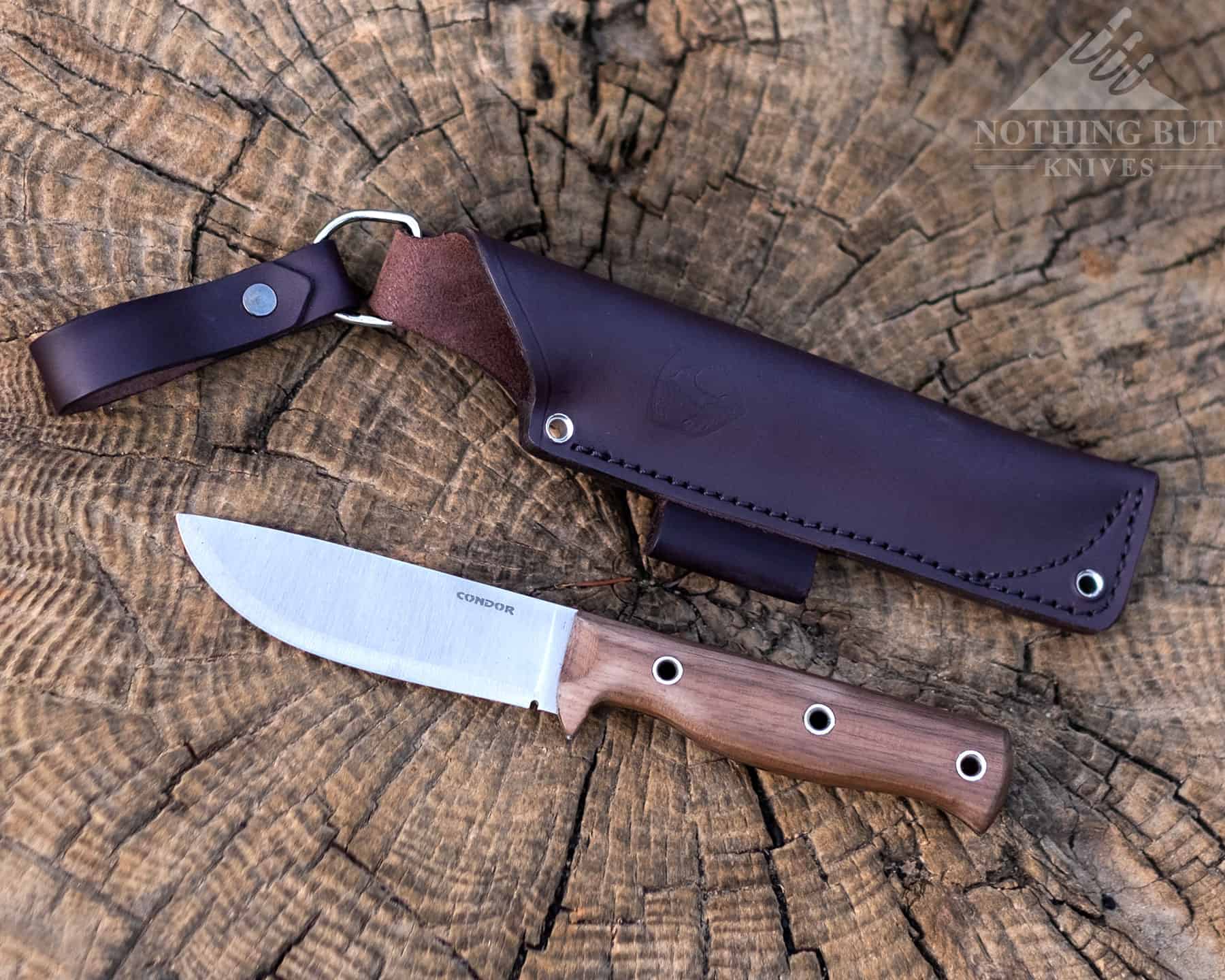
| Overall Length: | 9.5” |
| Blade Length: | 4.5” |
| Blade Steel: | 1075 |
| Blade Style: | Drop point |
| Blade Grind: | Scandi w/ convex edge |
| Handle Material: | Walnut wood |
| Sheath: | Leather |
| Made in: | El Slavador |
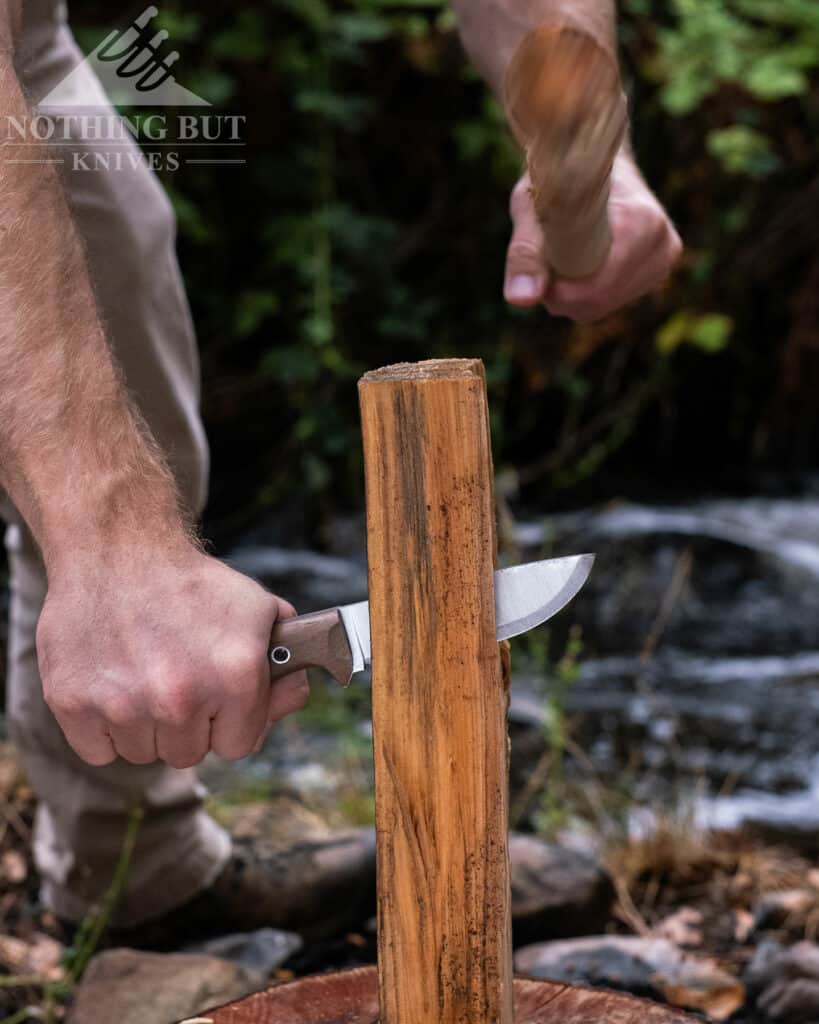
This has a scandi grind but it’s not quite like the Mora Bushcraft. The grind is a little lower, thinner, and overall closer to a standard blade shape so the point sits closer to the spine.
It’s a lot slicier than most knives with a scandi grind. Plus the edge is convex, which makes this really good for making feather sticks. It won’t take chunks out of wood at the same rate as the Mora Bushcraft, but it’s nice for slightly finer carving and cutting. It also does a decent job of batoning if that’s something you are into.
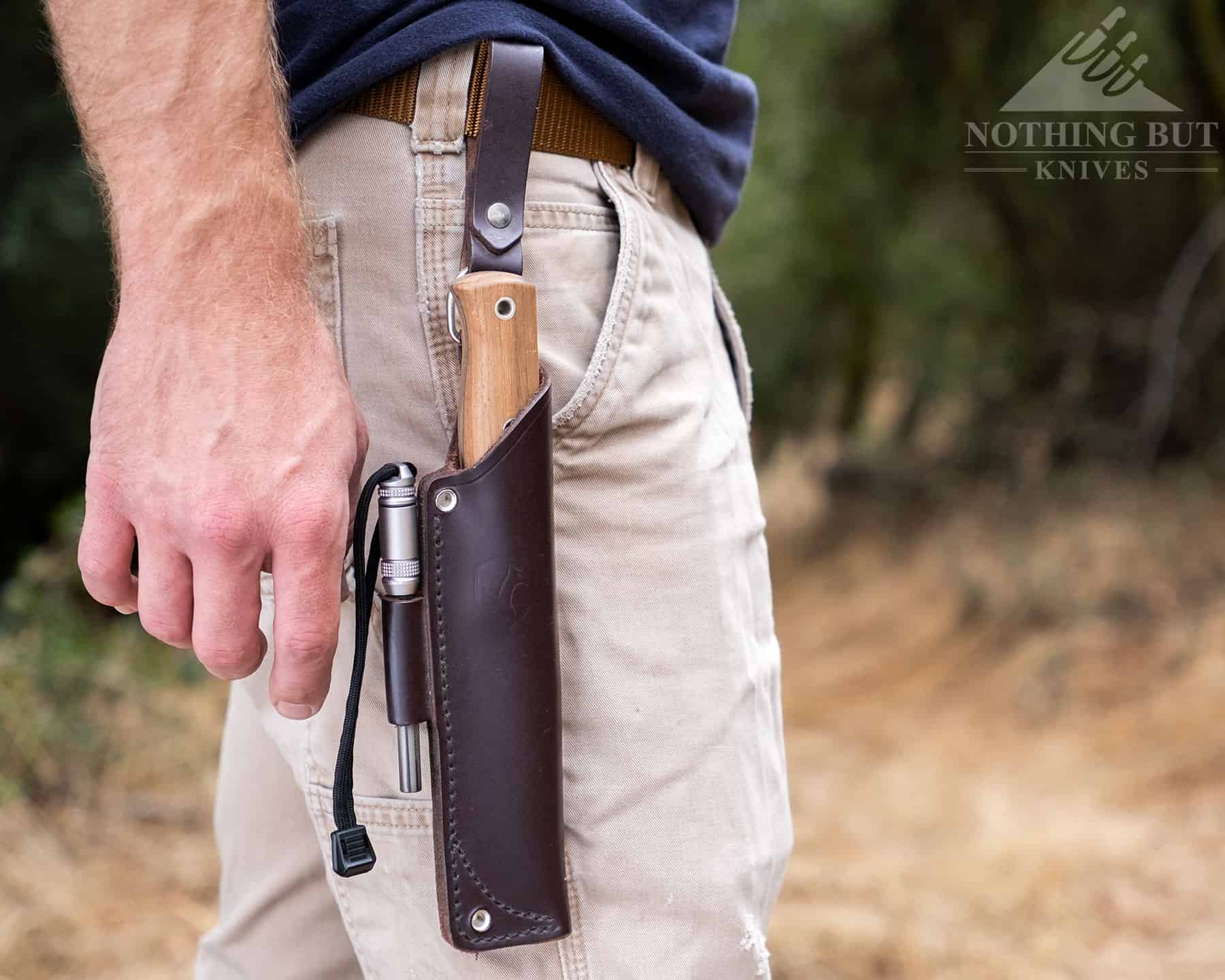
It has a more natural look with its wood handle and leather sheath, and the smooth finish of the wood makes chopping a lot easier on the hand as it builds less friction. It also has some nice scalloping work at the top of the handle to make pinch grips more comfortable, which comes in handy for skinning.
For a bit more detail you can check out our full review of the Condor Swamp Romper.
Off Grid Ridgeback
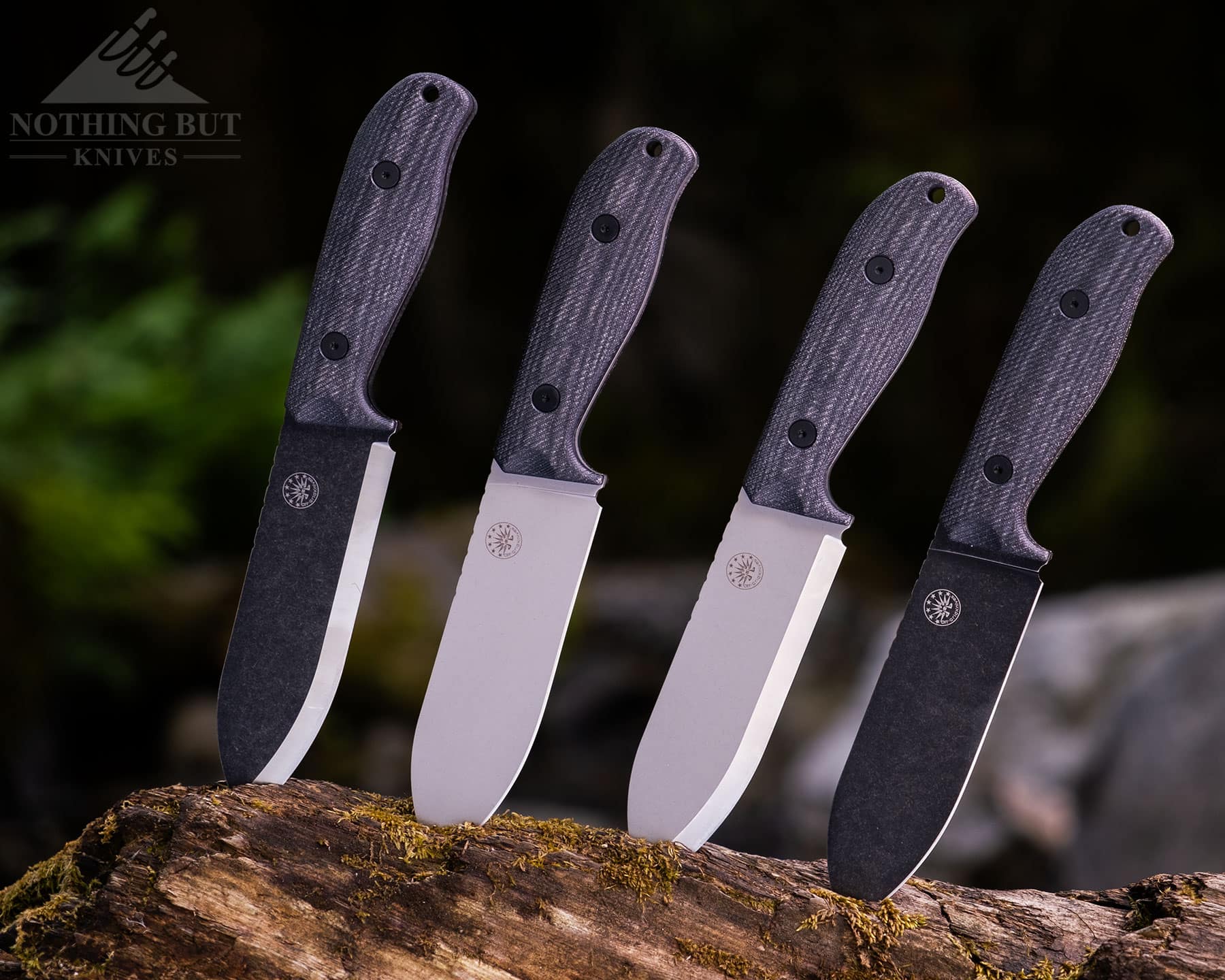
| Overall Length: | 9.7” |
| Blade Length: | 5.2” |
| Blade Steel: | Sandvik 14C28N or Cryo D2 |
| Blade Style: | Spear point |
| Blade Grind: | Scandi or full flat |
| Handle Material: | Micarta |
| Sheath: | Pancake-style Kydex |
| Made in: | Taiwan |
| Designer: | Carey Orefice |
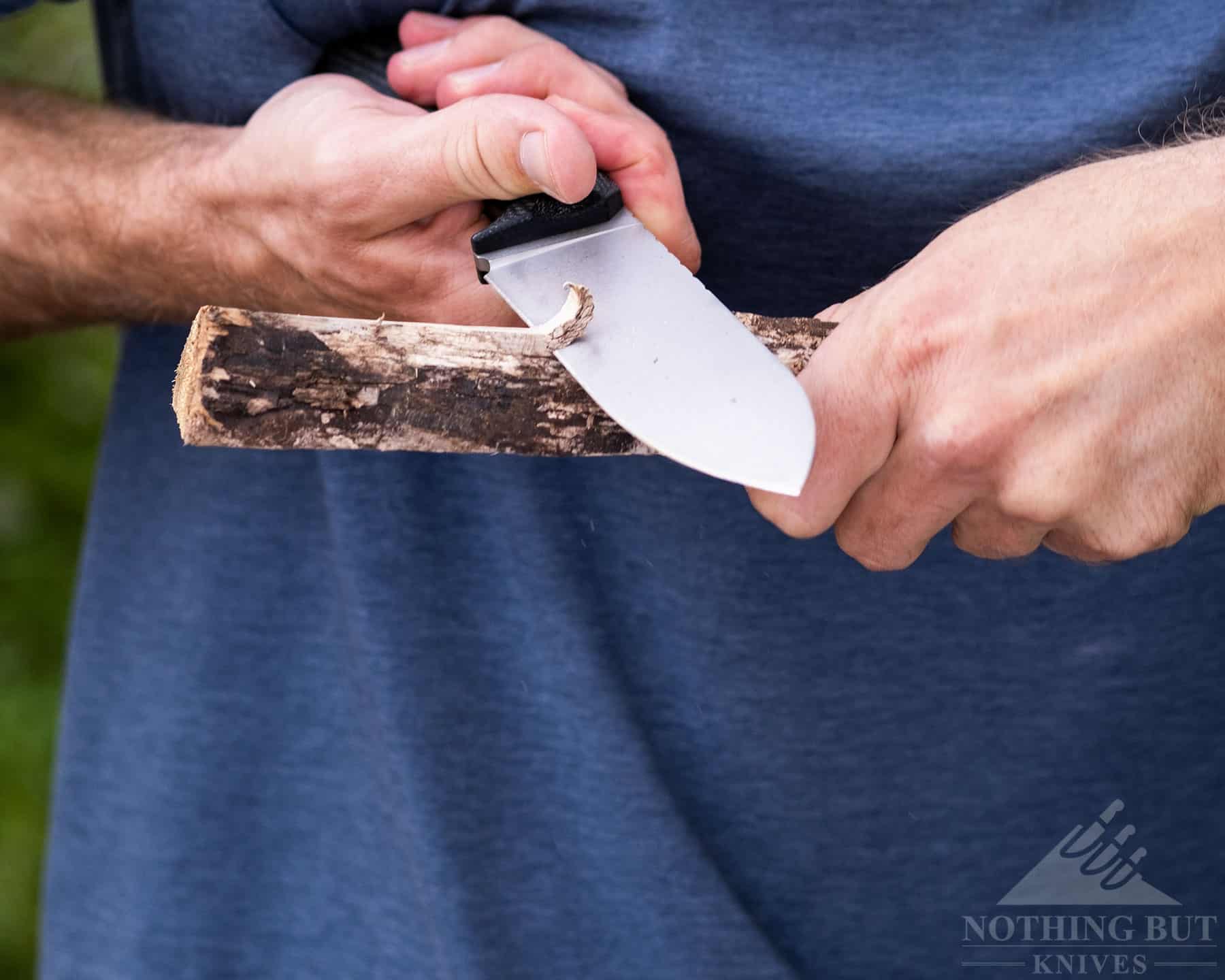
This might be the best carver in the category of big bushcraft knives that we’ve tested. The handle has a very secure grip for chopping and chest levers. I can always keep a rock solid grip on this knife in any conditions (and I have taken it into some messy conditions) thanks to the dry Micarta scales and the minimal contouring.
I always feel like I have a lot of control over the blade even though it’s kind of a meaty thing, and the scandi grind has a hard bite which makes this excellent for processing wood across a broad range (alternatively, the full flat version won’t rip chunks out of wood the same way, but it is a very efficient cutter on pretty much all other materials).
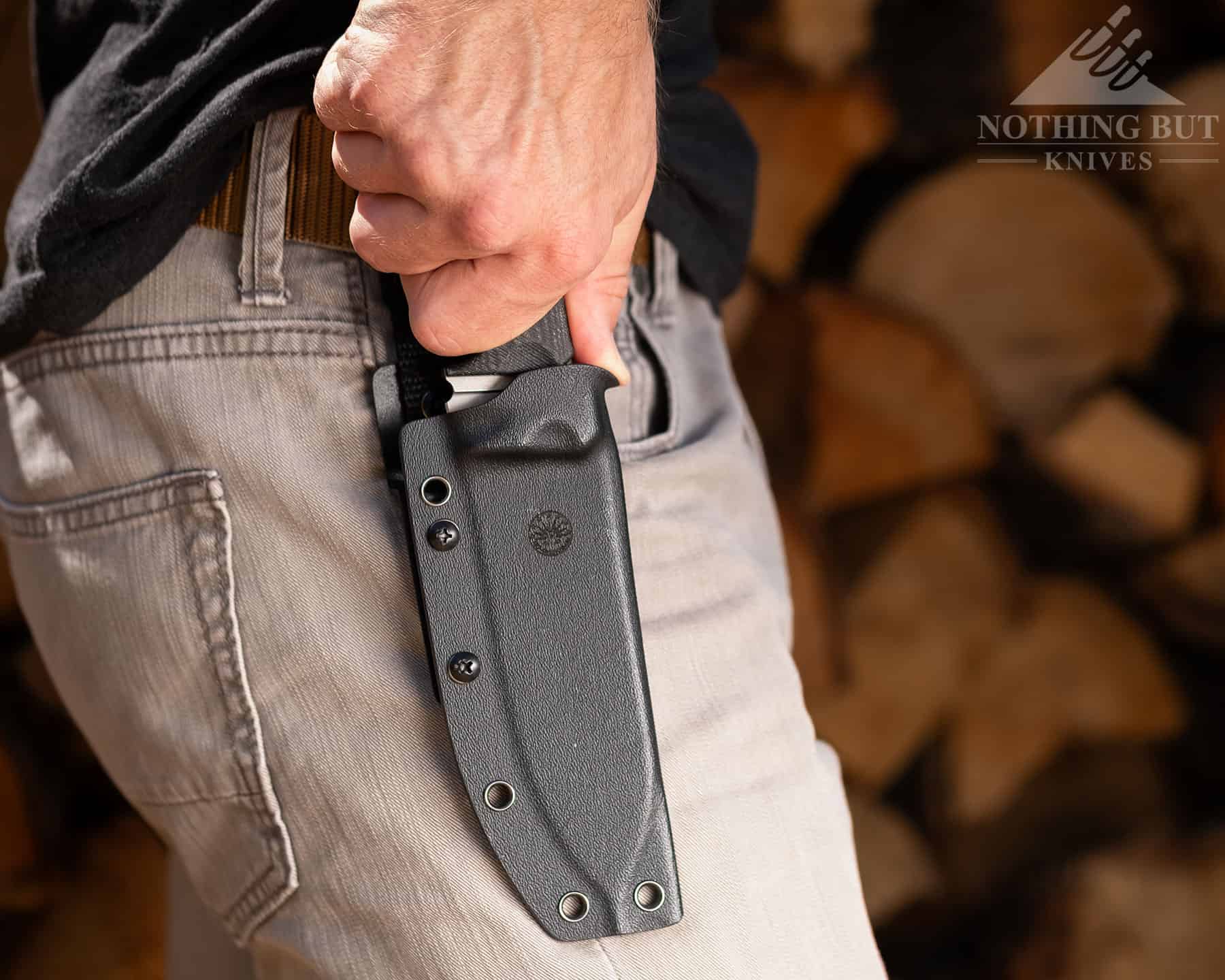
The sheath is only set up for vertical carry, but for a heavy knife this actually rides pretty well. The nylon back keeps the handle at a good height that only kind of hits my ribs sometimes, but feels close at hand, and I don’t feel too much movement when I’m hiking.
Off Grid makes this in a few different variations now (they update their designs pretty regularly). The original that we reviewed was a scandi blade with 14C28N steel, but the newer versions of it have Cryo D2 steel, a full flat grind, and a slightly lighter build.
Check out the full review of the Off Grid Ridgeback here.
Mora Garberg
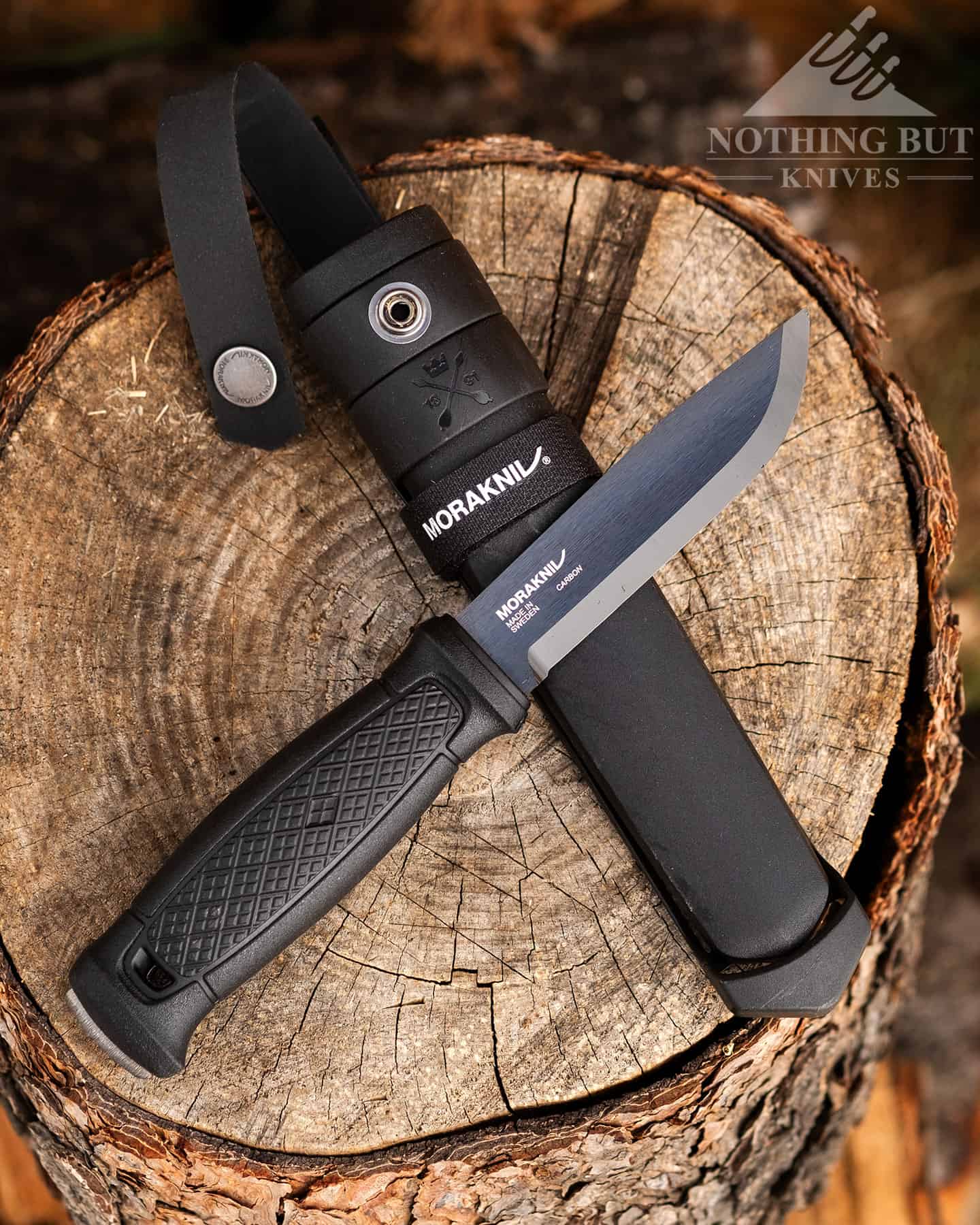
| Overall Length: | 9.0” |
| Blade Length: | 4.25” |
| Blade Steel: | High carbon |
| Blade Style: | Clip point |
| Blade Grind: | Scandi |
| Handle Material: | Polymer |
| Sheath: | Sheath |
| Made in: | Sweden |
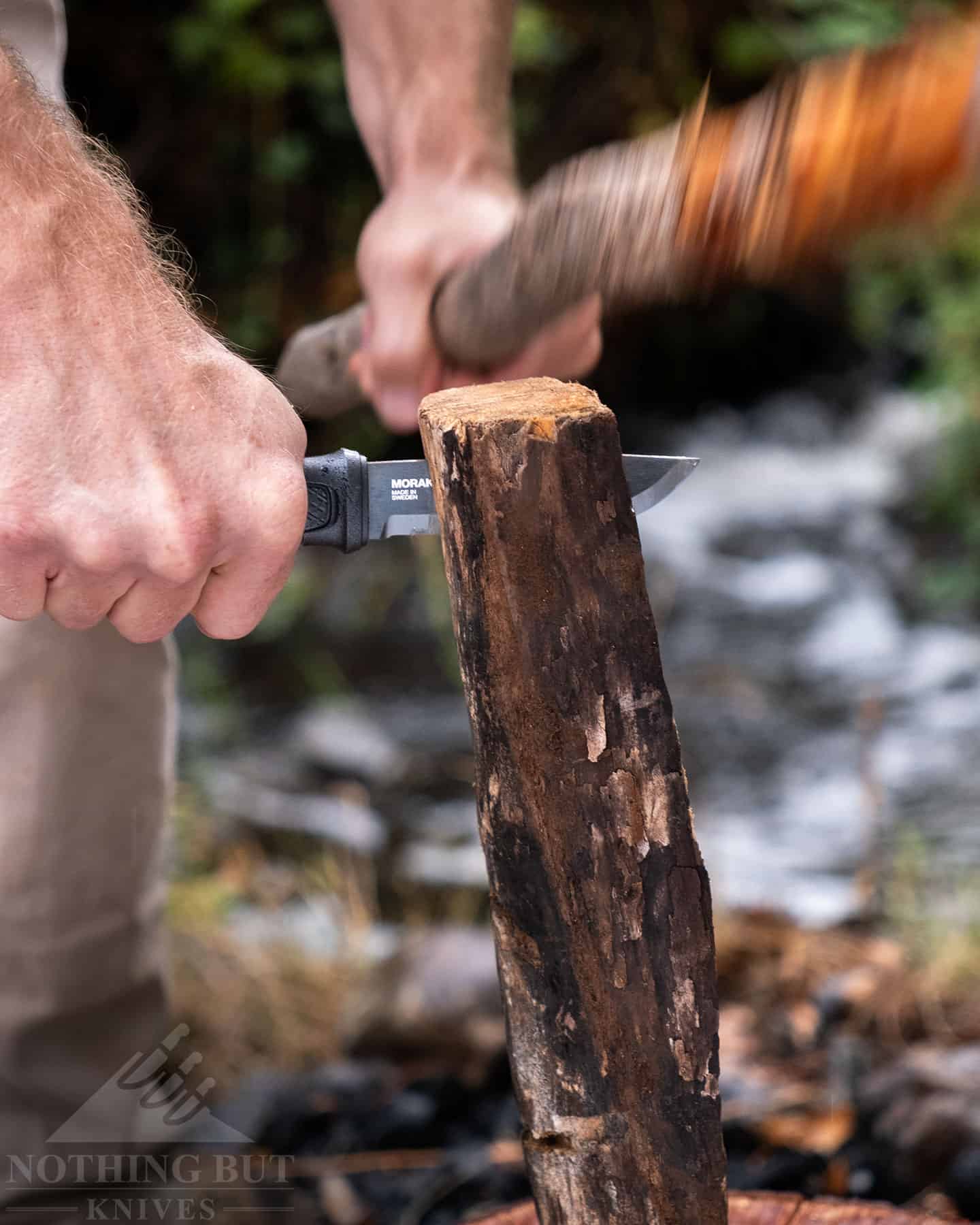
This is the “tough” Mora. Basically it’s like any other Mora knife except it’s full tang and even has a healthy chunk of steel sticking out of the pommel which brings in some added hammering and fire steel functions. The handle is also made from a smoother polymer material that’s easier to clean up. It doesn’t have the same grip security as the Mora Bushcraft, but it’s easy enough to hold.
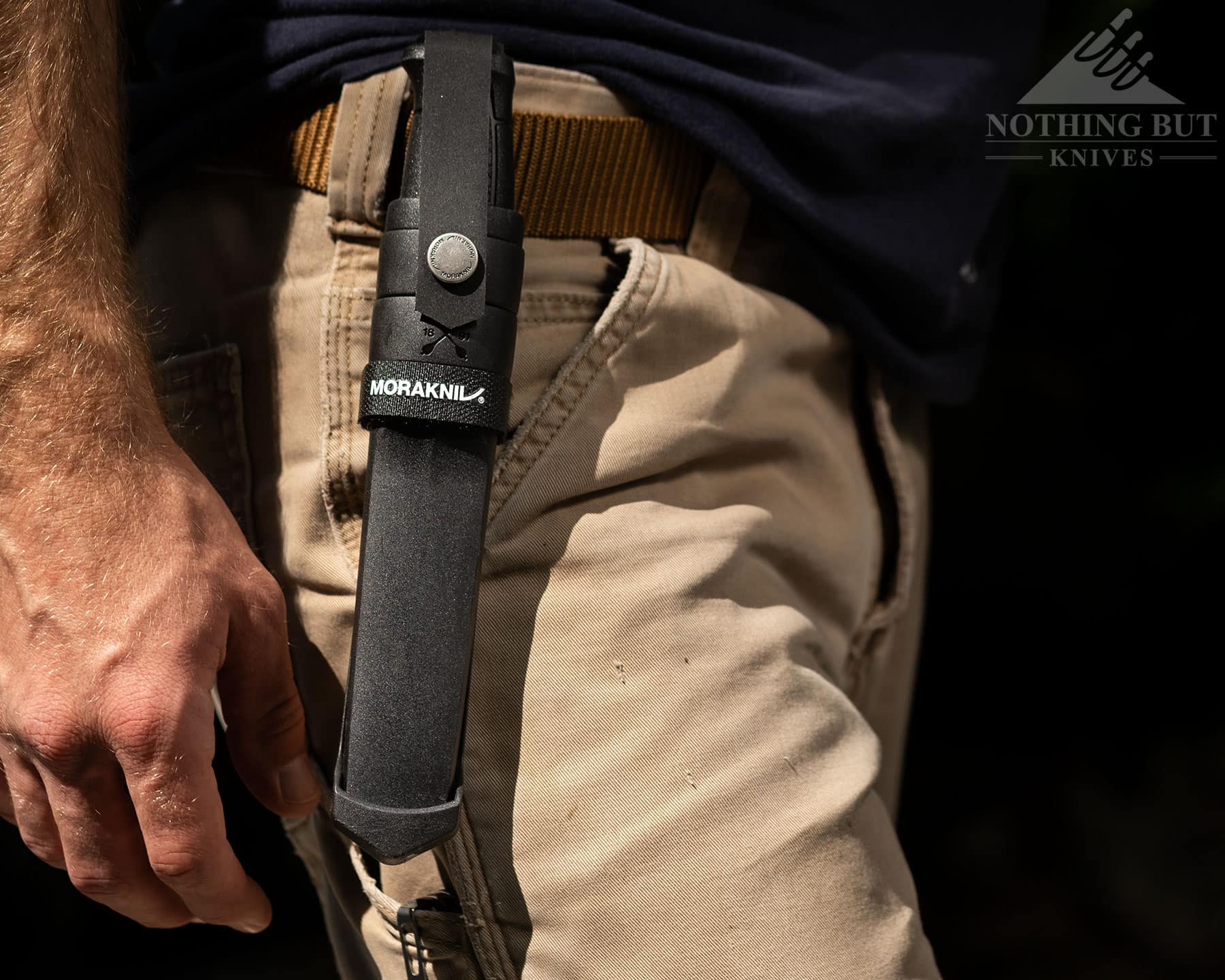
Mora sheaths are usually barebones. I’ve never liked them much personally, but they get the job done, and there’s an add on available that adds a drop-leg carry and a retention strap. Without add ons, you’re stuck with throwing the knife into your pack or pocket.
Their sheaths don’t typically come stock with belt loops, which is why I highly recommend getting this with the multi-mount system. That’ll get you a slotted polymer back that can be mounted to different MOLLE-style systems that have a good amount of thin nylon or velcro straps.
If you think the Garberg may be the knife for you, but you want to learn a bit more about it, check out our Morakniv Garberg Review.
Best Fixed Bushcraft Knives Under $200
This is the price range we’ve sunk our teeth into the most, so this section will be a little long. The steels get nicer, the handles get comfier, and we have to spend a lot more time talking about whether or not a knife is really worth what you’re paying.
Joker Knives Bushcrafter
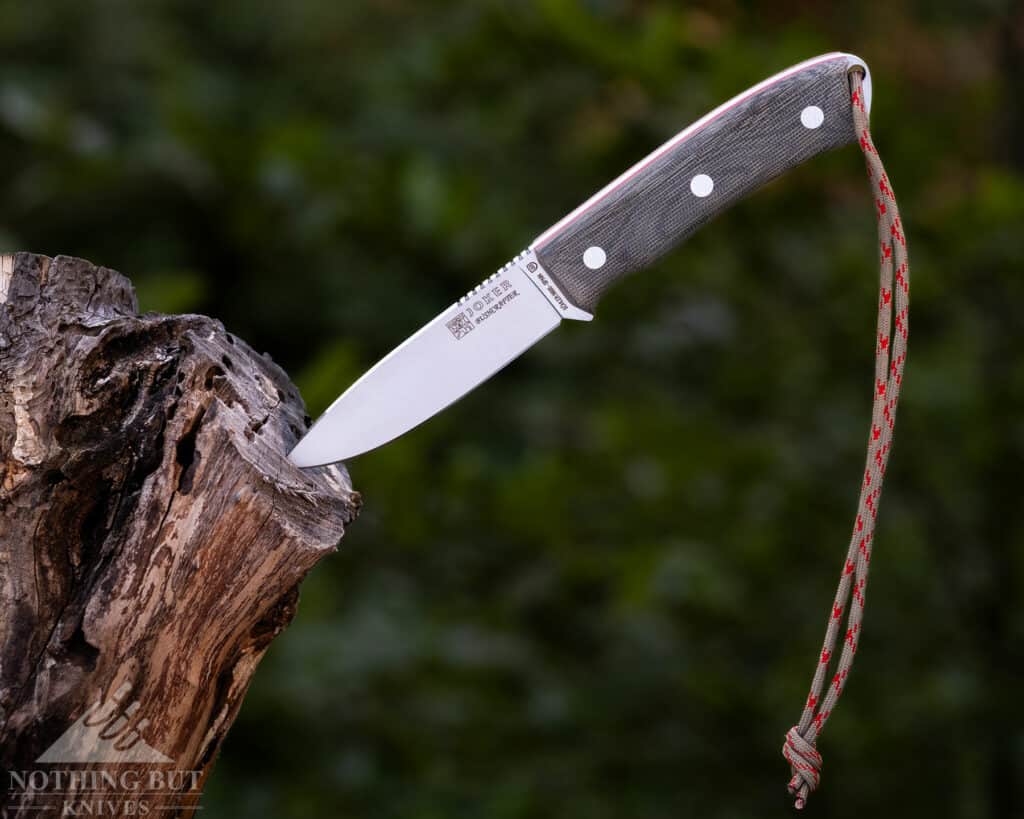
| Overall Length: | 8.6” |
| Blade Length: | 4.1” |
| Blade Steel: | Bohler N695 at 58 HRC |
| Blade Style: | Drop point |
| Blade Grind: | Flat |
| Handle Material: | Micarta |
| Sheath: | Leather |
| Made in: | Spain |
This knife is one of the more comfortable fixed blades we’ve used. The corners of the handle are nicely rounded and the whole shape is wide with subtle curves that feel grippy in all sizes and shapes of hands, although I think it’s wider overall in a way that seems to play happily with larger hands.
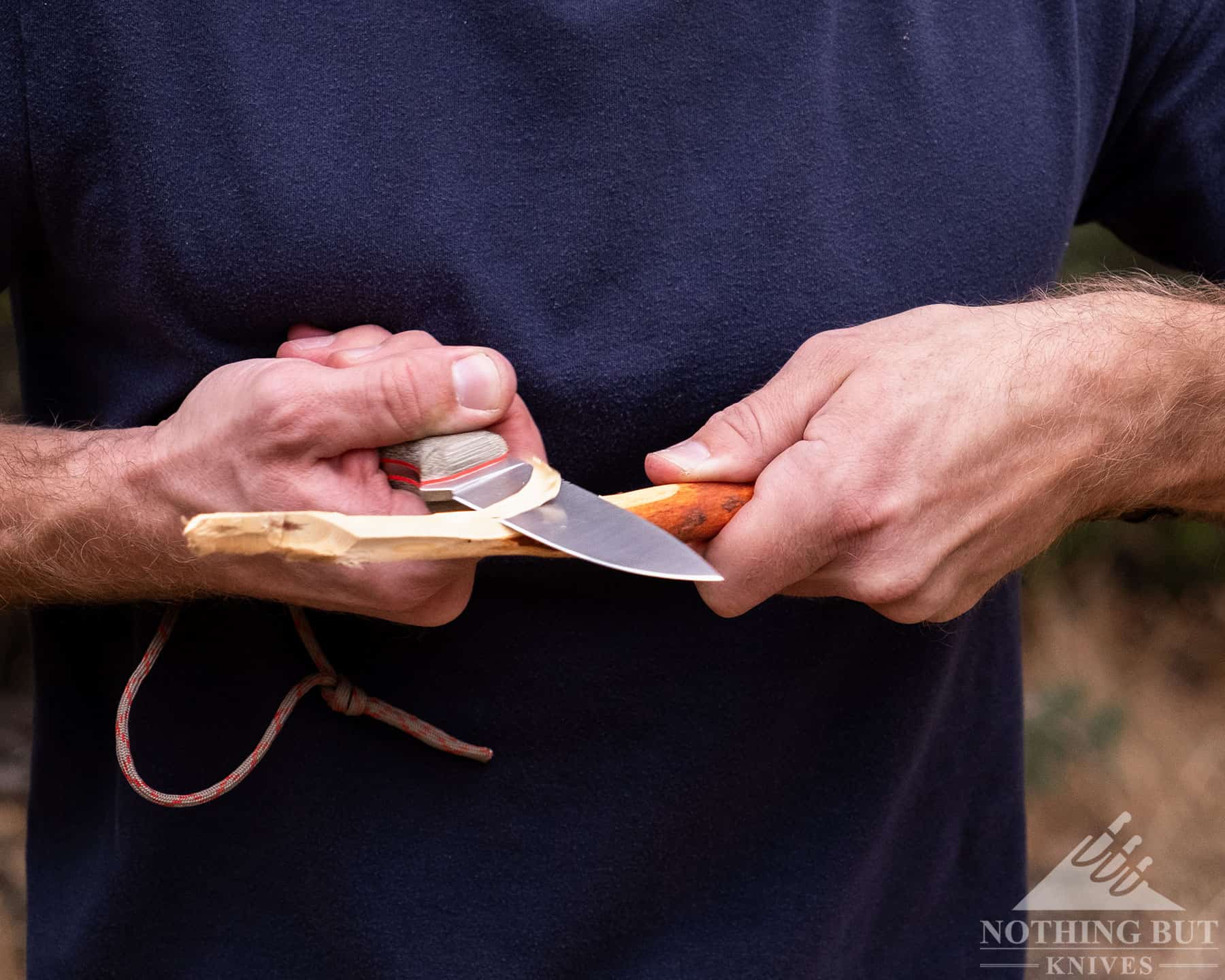
That nice grip is topped with an N695 steel blade that has a beautifully polished edge. This thing comes out of the box making effortless cuts through paper, and the full flat grind on the blade make it fantastic for cutting general material, if not exactly the best woodcarver on the list. I’d put this next to the Buck Selkirk as one of the better options to take on a hunting trip.
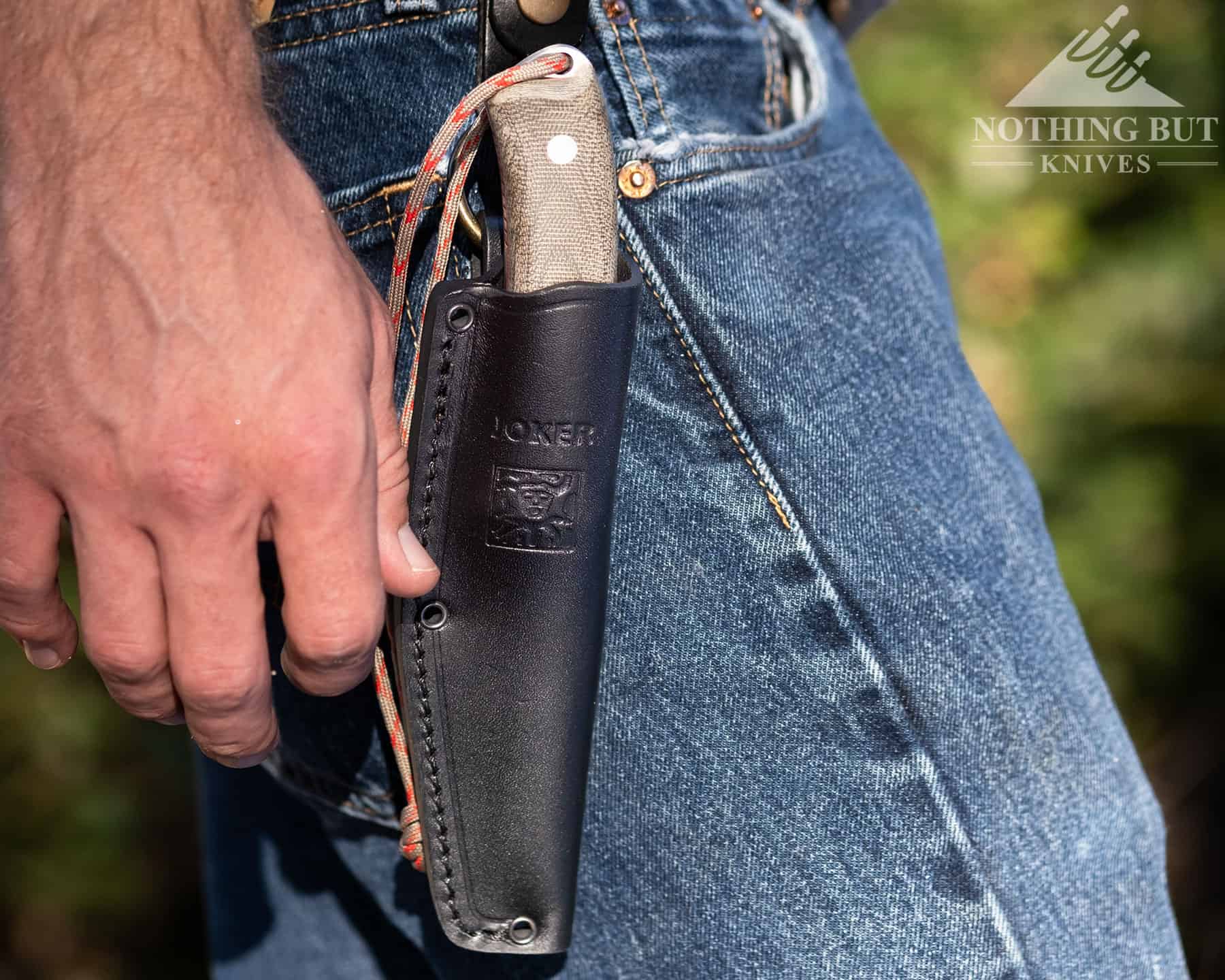
As for the sheath, it’s a pretty standard drop-leg leather affair with a nice grip that isn’t too tight right out of the box. The knife seats in about halfway up the handle so there’s still plenty to grip on when you want to draw it, but it rides fairly low if you choose to forego the drop-leg loop and carry it in a standard vertical position.
It ships with a paracord tied through the handle that I didn’t particularly like, but I will admit it’s nice to have another piece of something to tie things down with. It’s not really long enough to twist around your wrist to secure it while you’re chopping, but it’s fine for slipping your hand through while you’re working over a ledge, or water you really don’t want to lose the knife in.
Victorinox Venture Pro (Best Bushcraft Knife For Backpacking)
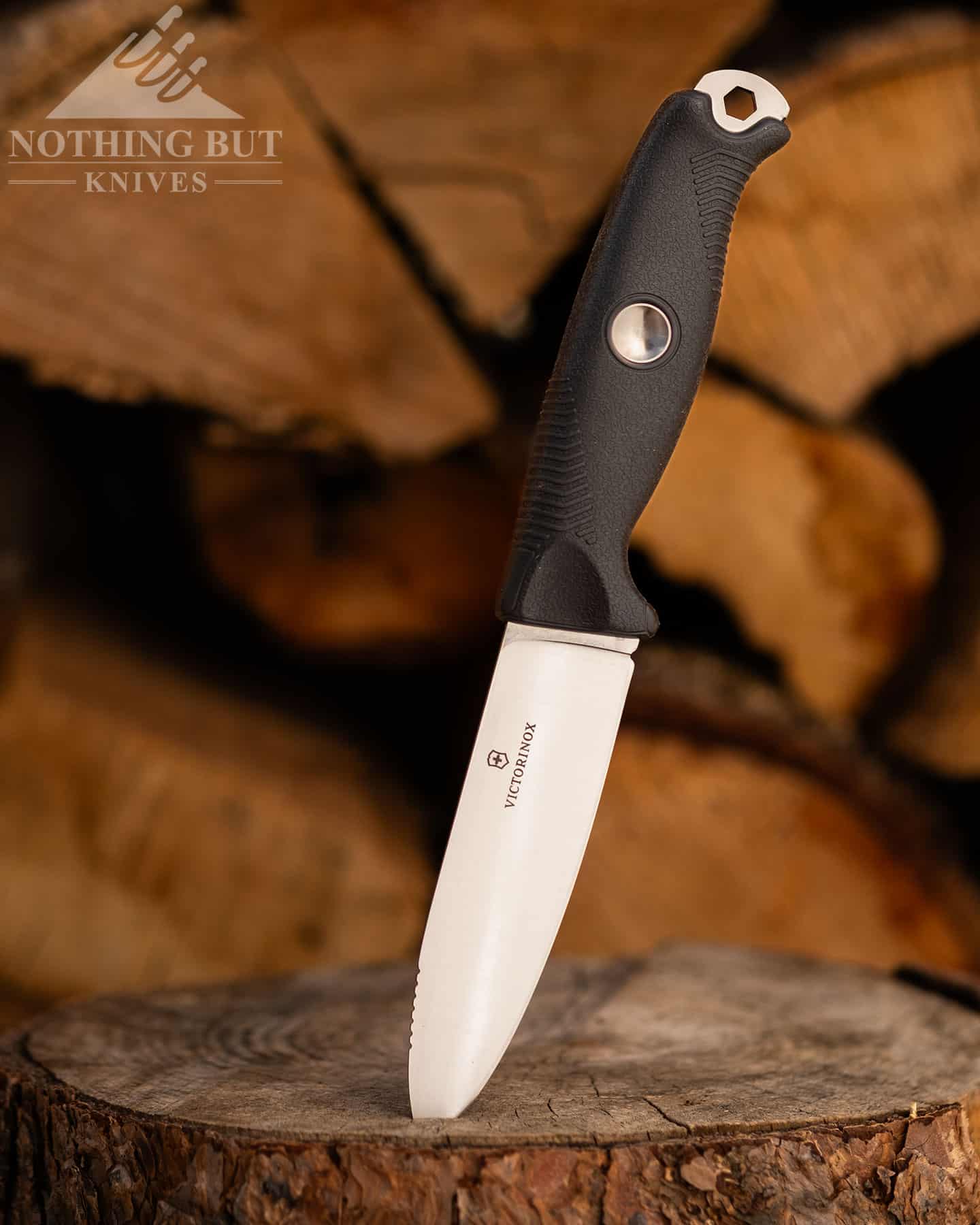
| Overall Length: | 9.0” |
| Blade Length: | 4.25” |
| Blade Steel: | 14C28N |
| Blade Style: | Drop point |
| Blade Grind: | Flat |
| Handle Material: | Polymer |
| Sheath: | Plastic |
| Made in: | Switzerland |
Leave it to Victoirnox to turn a fixed blade into a multitool. The Venture is a tough little knife that’s an excellent slicer packed in a pretty interesting carry system that opens up a lot of uses.
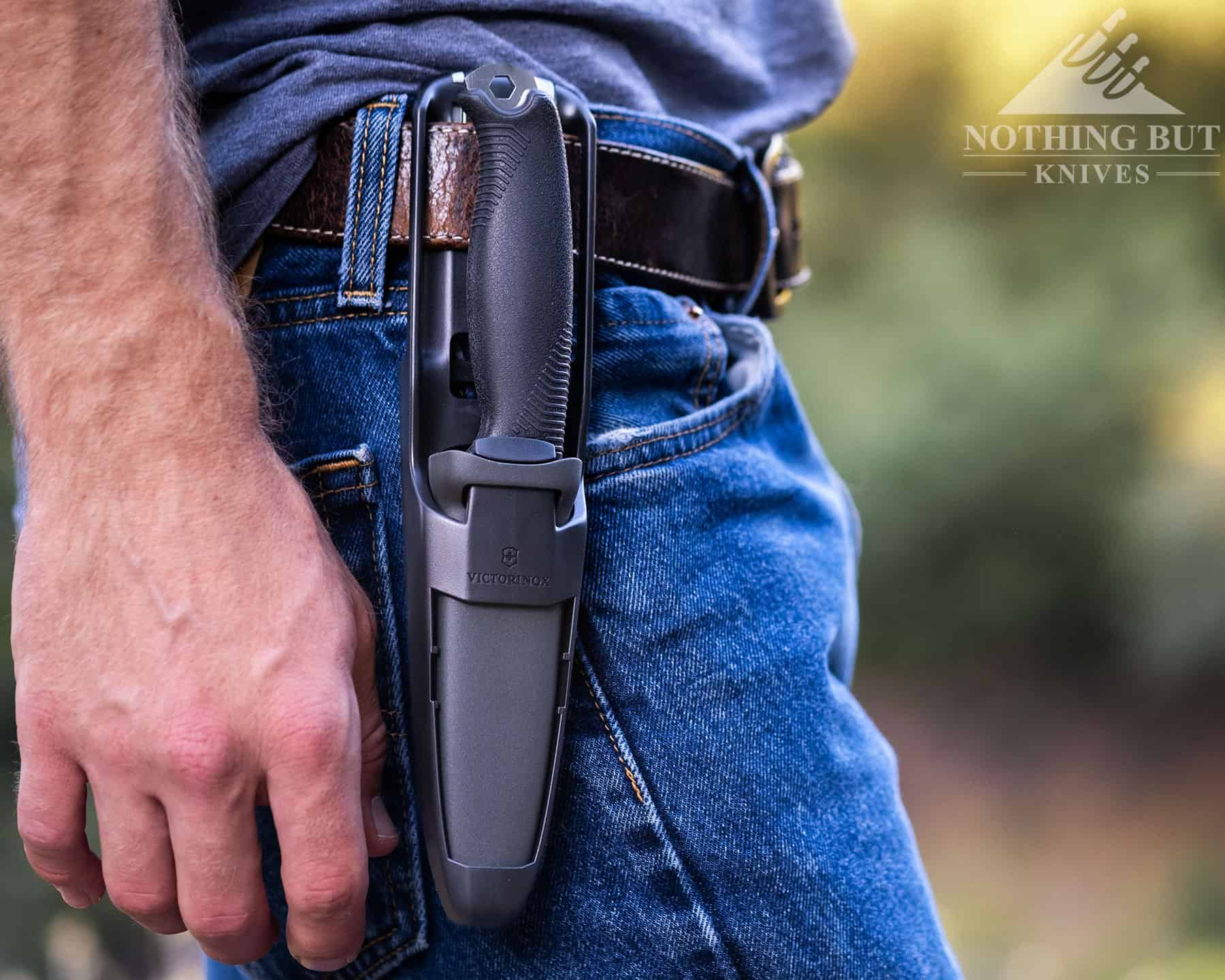
The Venture Pro features a sheath with a ferro rod, tweezers, and a pressurized ballpoint pen.
The actual sheath aspect is a little janky, unfortunately. There’s a lot of rattle, and it’s a little too loose for some people, but there are fixes, and if you really want to upgrade you can get the Venture Pro Kit, which is a nylon pouch for the knife and some auxiliary tools including a flat drill that fits into the hex hole on the knife’s pommel. The only thing missing on this rig is a bottle opener.
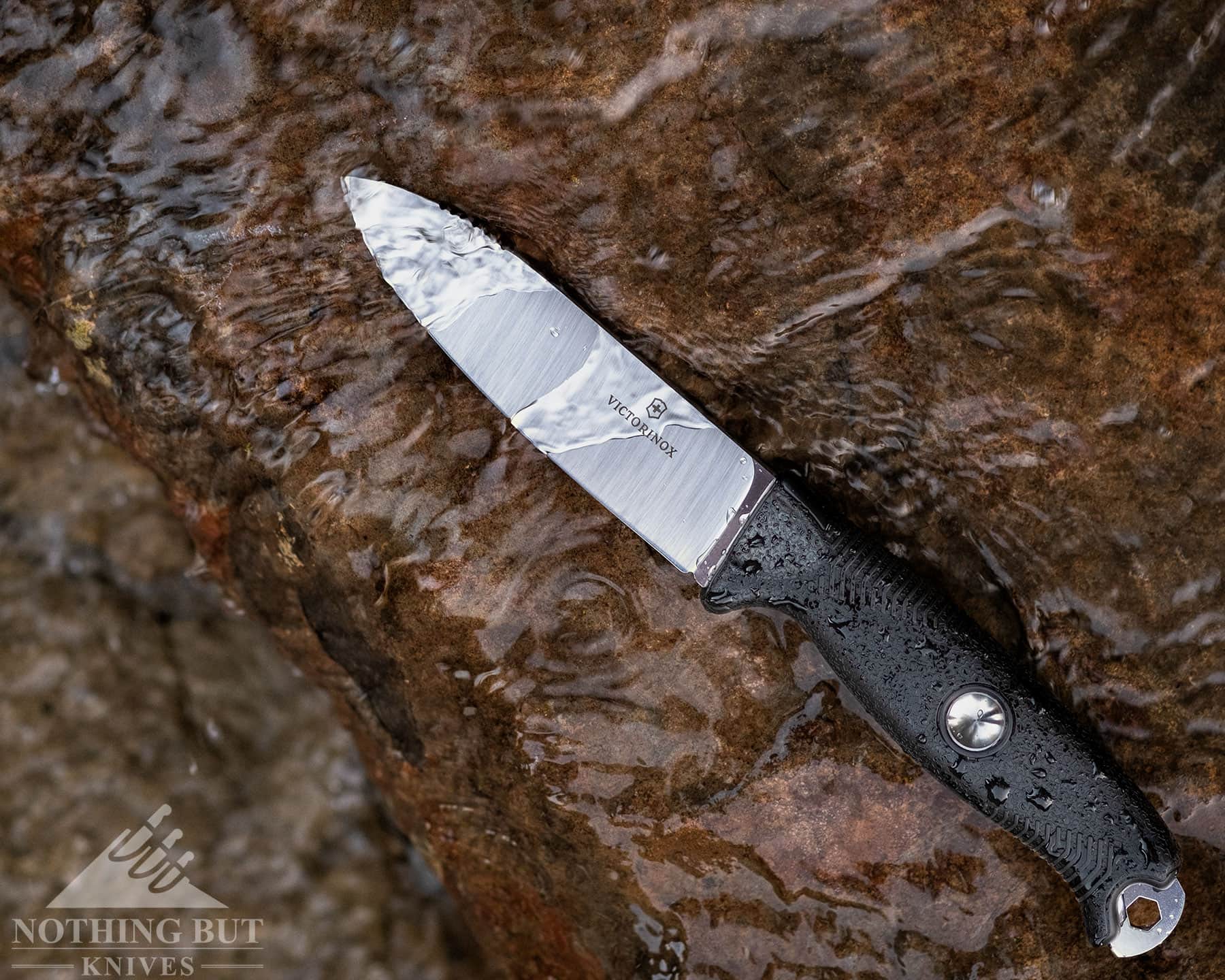
The knife itself has a lightweight, bare-bones-but-functional feeling to it. It’s a thin knife with a full flat grind, so it’s a mean slicer, and there’s quite a bit of durability with the 14C28N steel. Edge retention won’t be mind blowing, but the steel and grind make it pretty easy to touch up in the field.
The handle has pretty good grip even in wet condition thanks to a combination of the jimping they’ve cleverly placed for the pinky and the well of the hand, and the slightly rough texture of the material itself. Some nice contouring and slopes along the bolster section make the knife comfortable in pretty much any grip from a pinch to a hammer.
As for the fire-starting aspect, the spine will give you some nice, hot sparks off a ferro rod. That steel divot in the handle for making friction fires probably works well, too, but we’ve never been good enough at that particular technique to be able to gauge when one steel divot is better than another. It’s there. It doesn’t interfere with the grip, and it probably works in a pinch.
ESEE Camp-Lore RB3 (Best Overall)
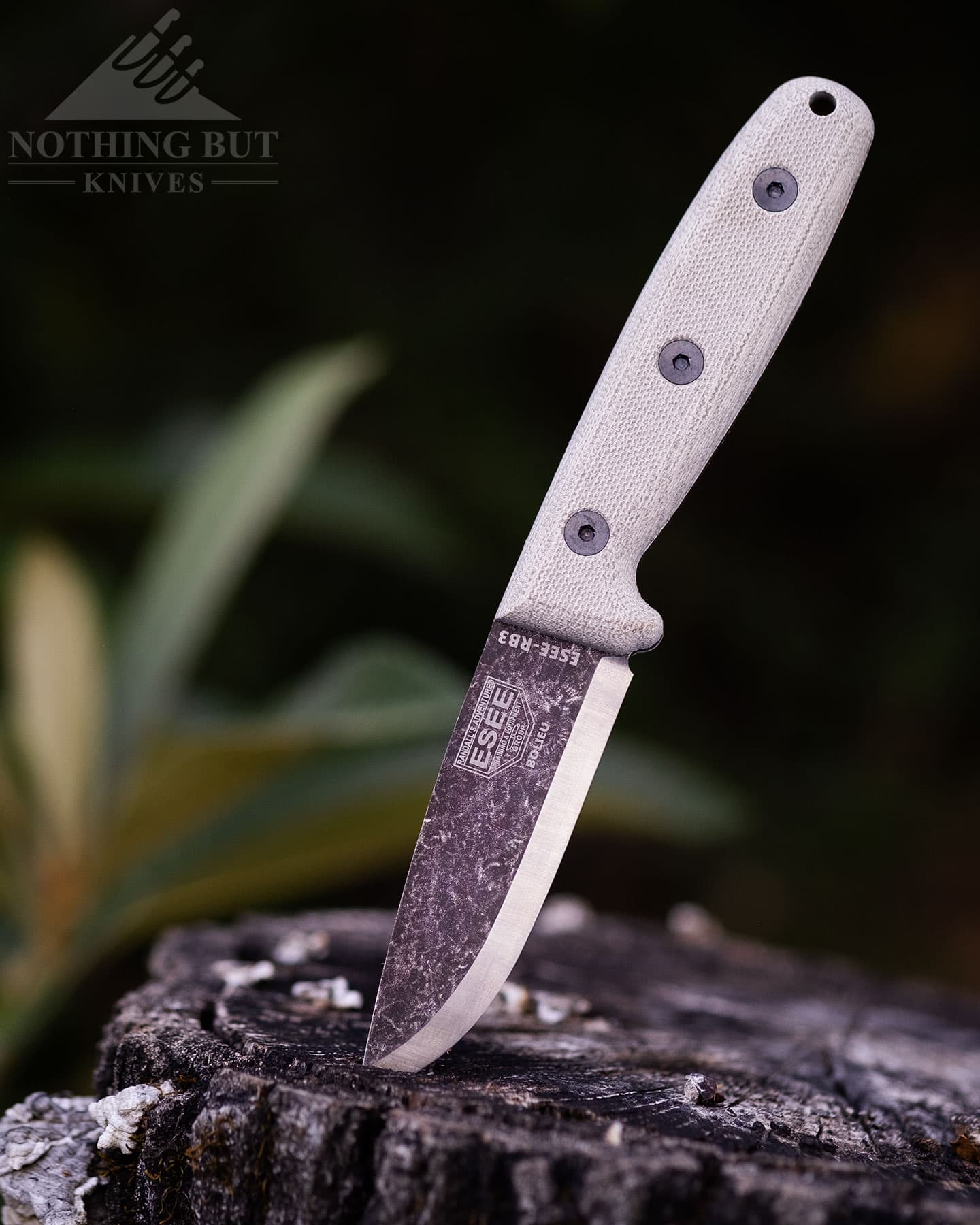
| Overall Length: | 8.125” |
| Blade Length: | 3.5” |
| Blade Steel: | 1095 |
| Blade Style: | Drop point |
| Blade Grind: | Scandi |
| Handle Material: | Micarta |
| Sheath: | Leather |
| Made in: | USA |
| Designer: | Reuben Bolieu |
The designer basically made this knife to have all the things he likes to have on a knife when he’s camping (which is a lot). A pint-sized knife with a scandi ground and a nicely rounded Micarta handle is a great recipe for carving all kinds of nifty tools and traps.
The handle has a great, neutral shape with a bit of a forward angle so this thing fits great into pretty much any hand, and quick leverage is easy to come by.
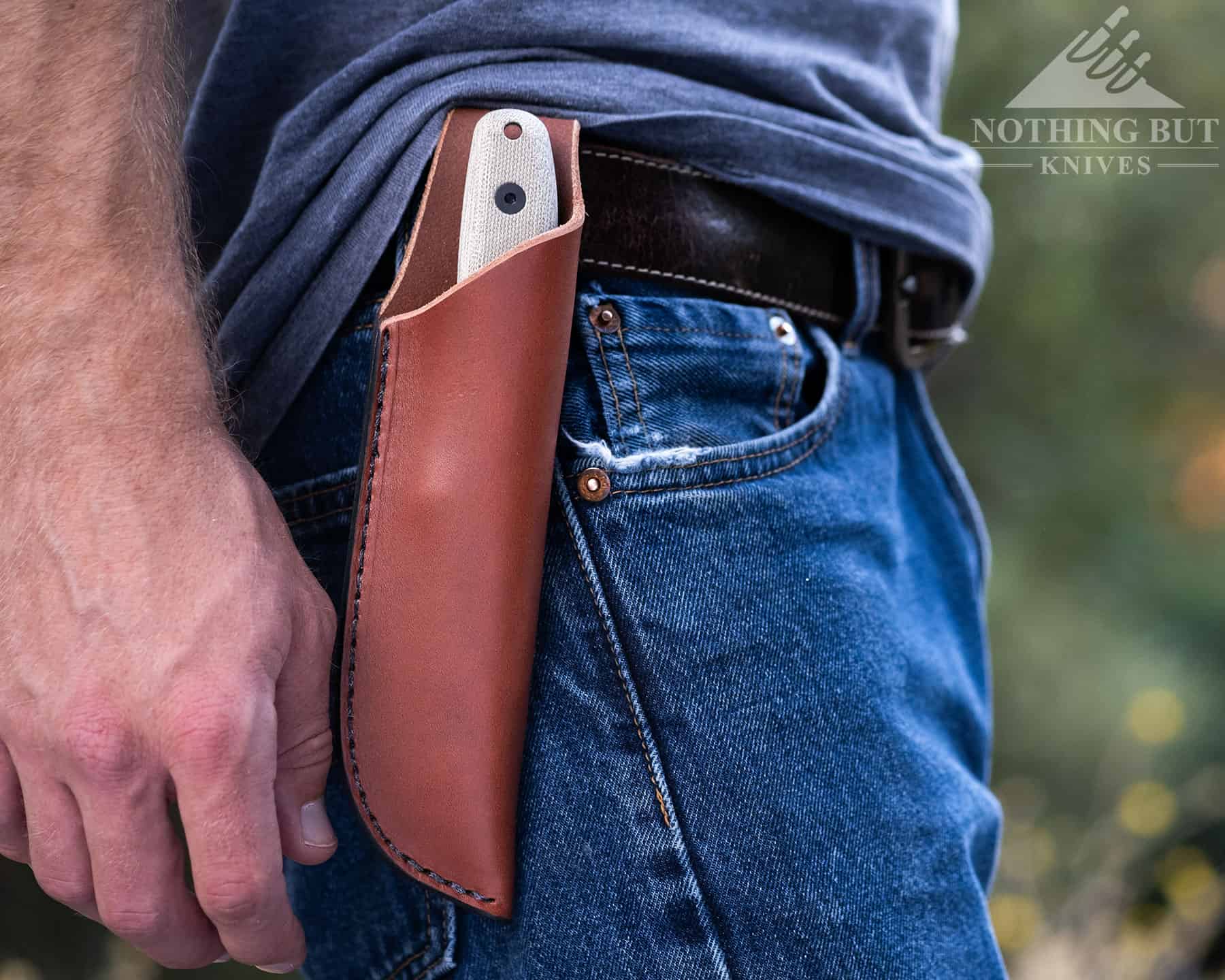
The leather sheath is pretty straight forward. It’s a vertical carry, and the knife seats pretty deep, so you won’t to be doing any flashy draws with it, but it rides well, and has a strong enough grip to keep the knife from slipping out.
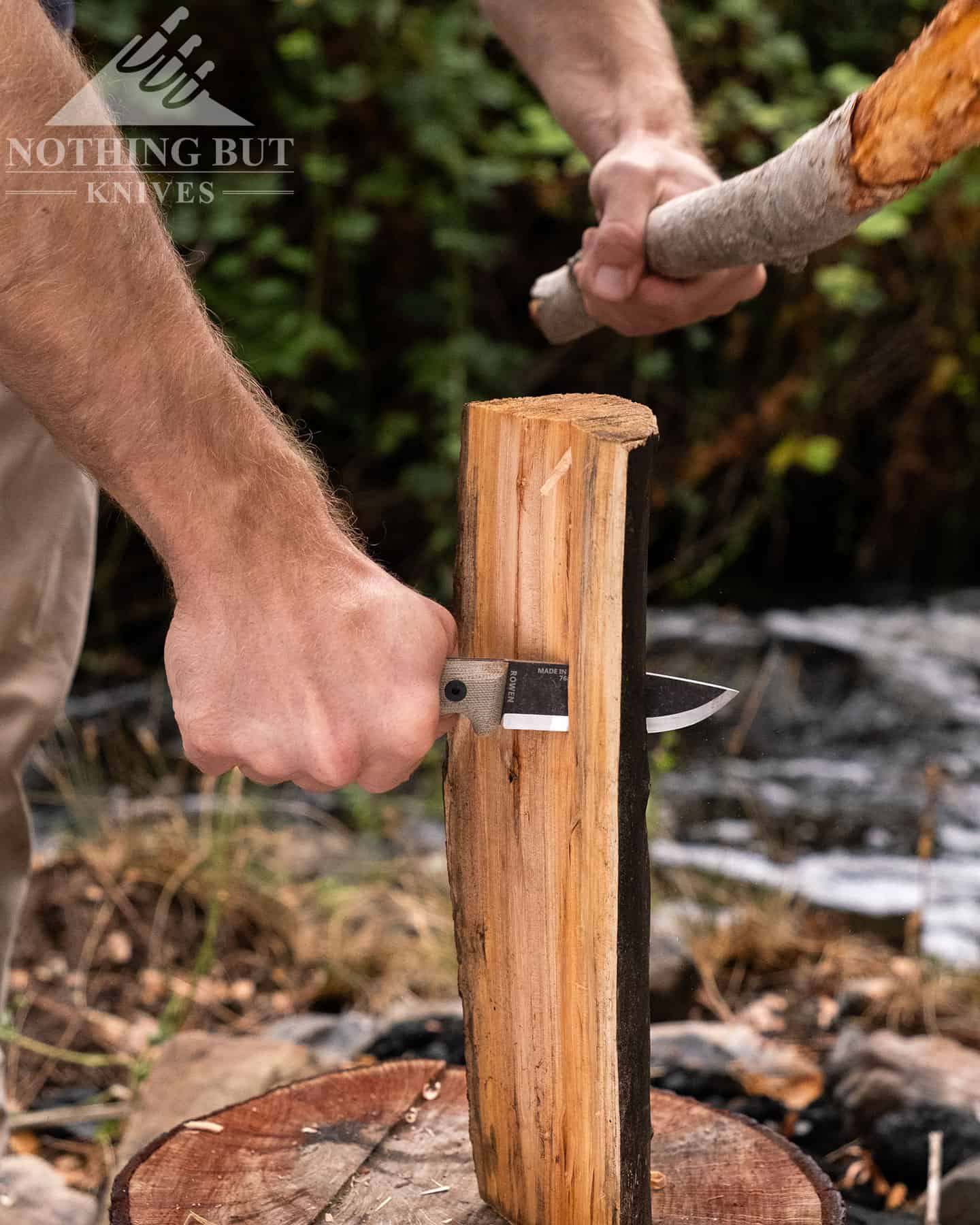
It looks and feels like something Mors Kochanski would have worn around his neck, which is to say it has a lot of similarities to the puuko style of knife, but with shaping attention to providing a bit of a guard for the fingers.
We love it for carving and starting fires. It can clean a branch up in no time because the edge has such a hard bite, and it’s easy to keep a strong grip even at awkward angles. The only possible issue is that the size limits the size of fuel it can break down. If you want to get really big stuff down into manageable sizes, you need to have some grit for chopping, and a creative approach to batoning.
Condor SBK
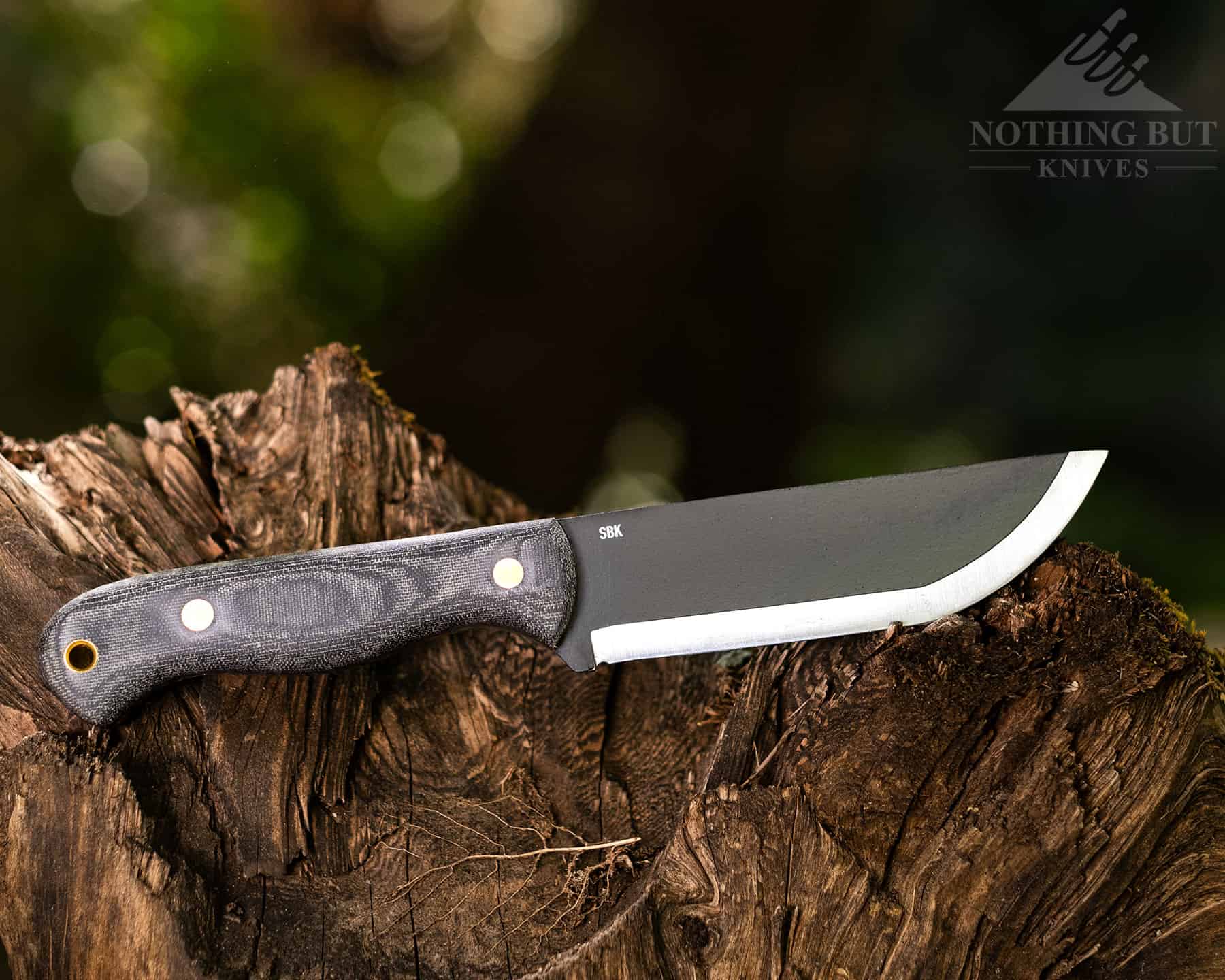
| Overall Length: | 10.5” |
| Blade Length: | 5.28” |
| Blade Steel: | 1075 |
| Blade Style: | Standard |
| Blade Grind: | Scandi |
| Handle Material: | Micarta |
| Sheath: | Kydex w/ leather loop |
| Made in: | El Salvador |
| Designer: | Julio Diez |
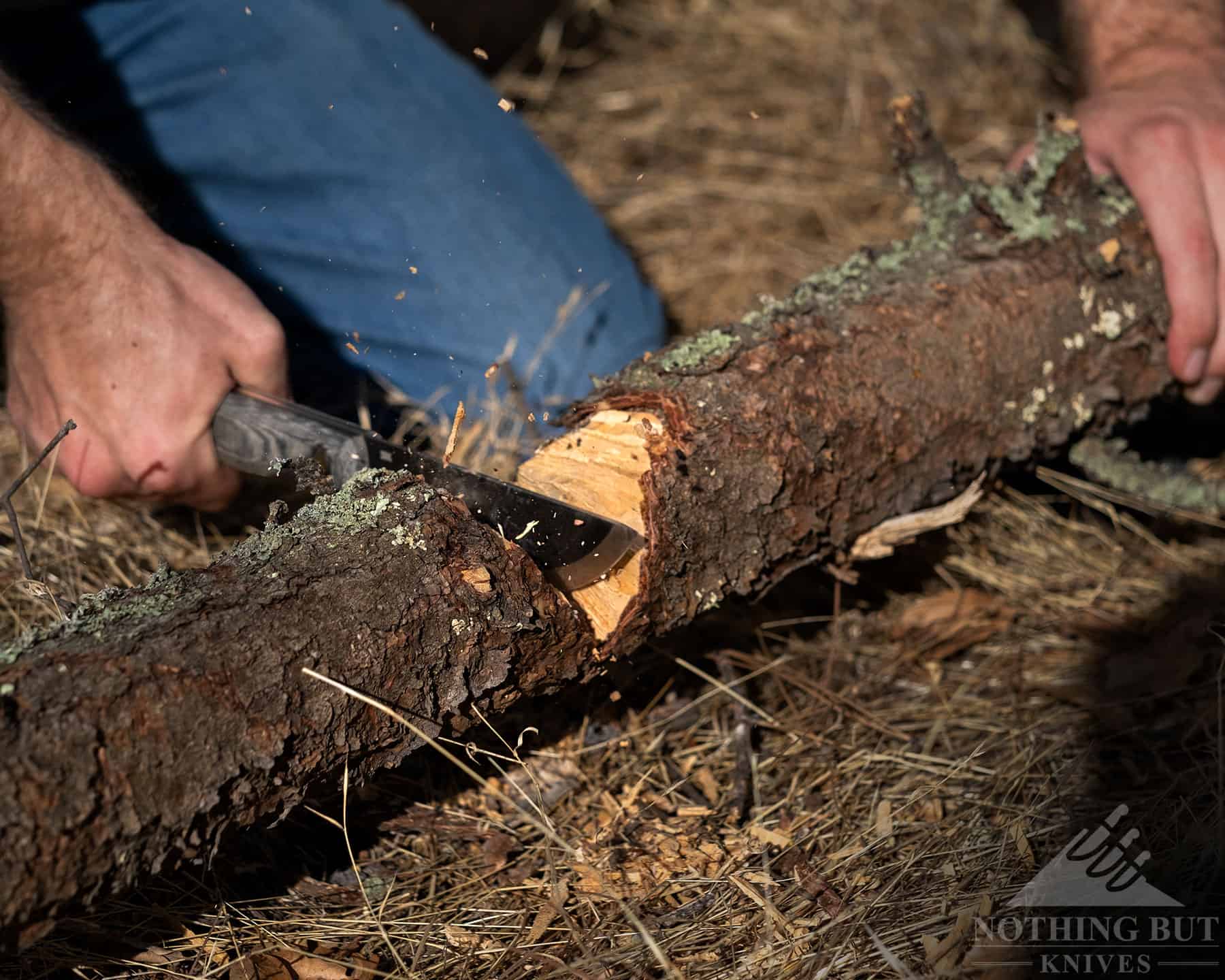
It’s a scandi grind, but the size of this thing makes it a different beast from the other bushcraft knives on this list. It’s a lot nicer for larger wood processing. So chopping is an easy task with the SBK, and it starts splitting most logs within the first few hits when batoning.
That edge grind is still nice for carving up feather sticks, but it’s a heavier knife than your typical optimized wood carver. That’s not ideal for prolonged carving sessions, and obviously the size of the blade makes it a little harder to use for tool making, but it can still get the work done. The edge geometry is good, you just have to work around the length sometimes.
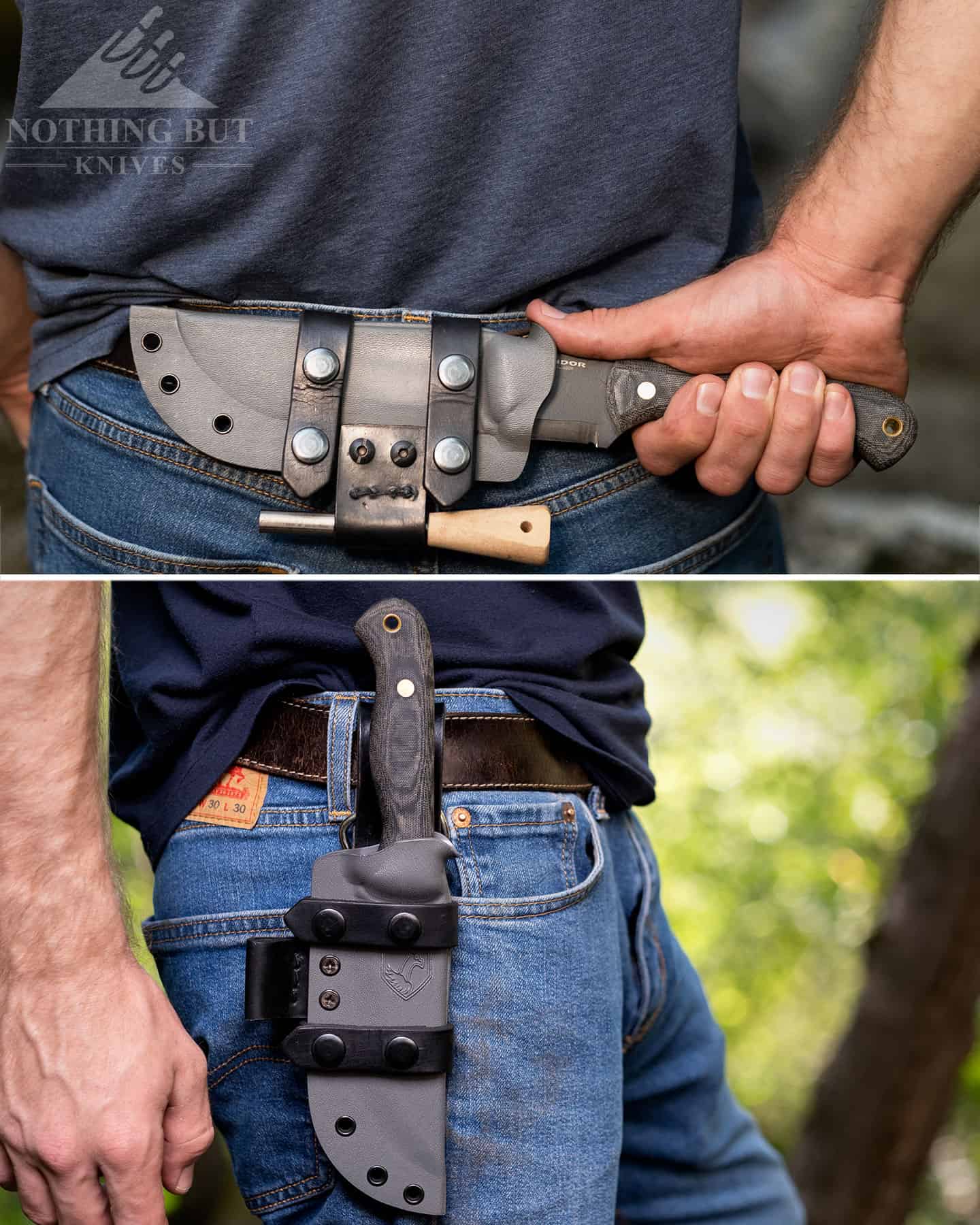
Another big upside is the sheath. Diez sheaths are always pretty stellar, and this one is a heavy-duty, taco-style kydex with leather straps set on to create options for vertical and horizontal carry, and a loop for a ferro rod (which, by the way, will shower sparks no problem on the SBK’s spine).
The Micarta handle has that kind of shape the seems to help your grip no matter where or how you hold it. The contouring is simple, but exaggerated with fairly deep wells, so there’s also something to help keep the knife from flying out of your hand. It’s not really optimized for choking up on the blade, unfortunately, but like we said, it’s great for working on larger scale things.
It’s also worth considering the SBK’s wider brother, the Bush Slicer. It’s not really a bushcraft knife, but if we’re talking about taking knives for leisure, that thing is entertainment and chef’s knife wrapped into one.
Anyway, you can read our full review of the Condor SBK here.
LionSteel M4 (Most Comforatable Handle)
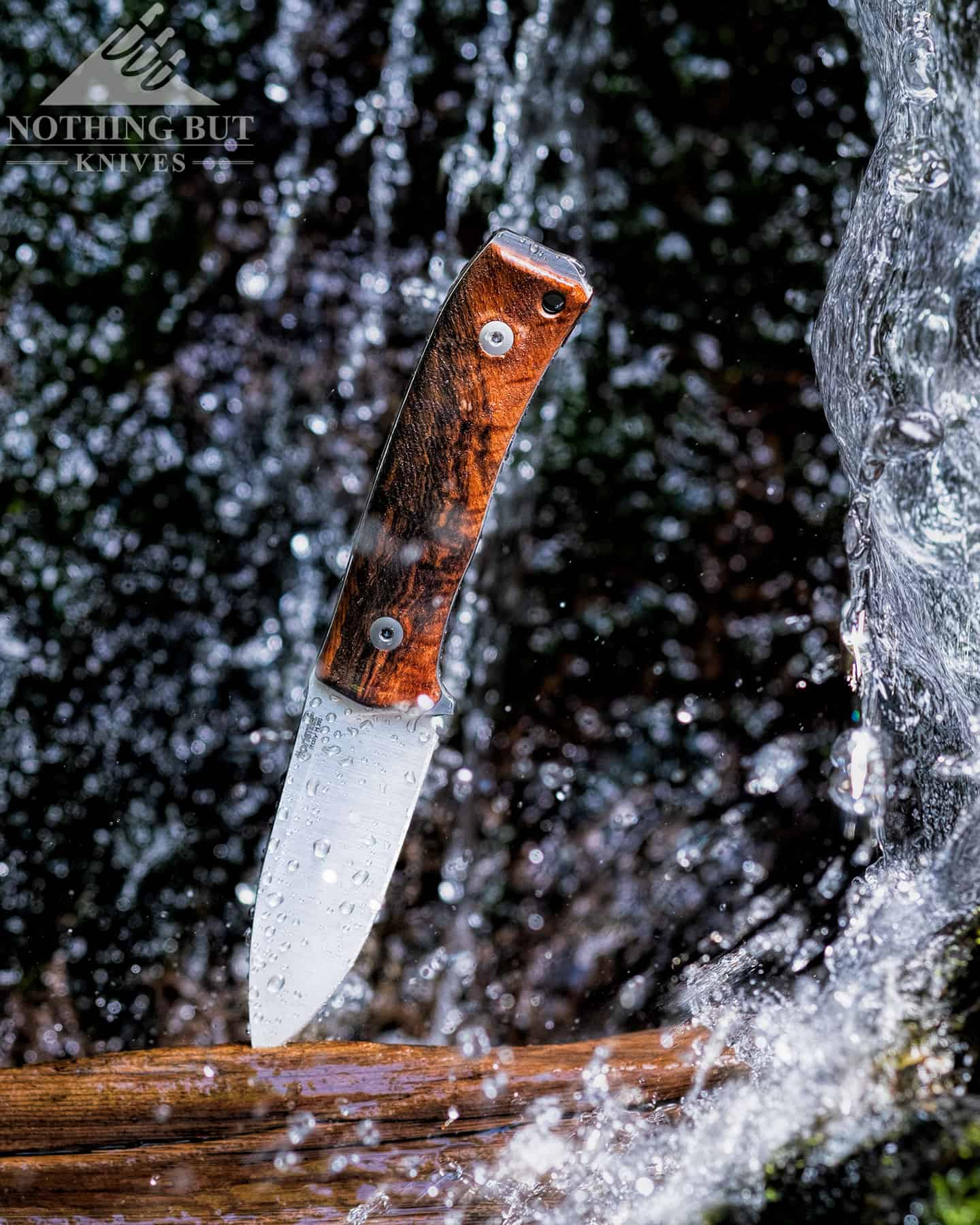
| Overall Length: | 8.0” |
| Blade Length: | 3.75” |
| Blade Steel: | Bohler M390 |
| Blade Style: | Drop point |
| Blade Grind: | High flat |
| Handle Material: | Micarta or G10 |
| Sheath: | Leather |
| Made in: | Italy |
| Designer: | Molletta |
I hate calling bushcraft knives classy, but this feels like the classy option to me. It’s also one of the most comfortable options, which is secretly my main requirement for a good bushcraft knife.
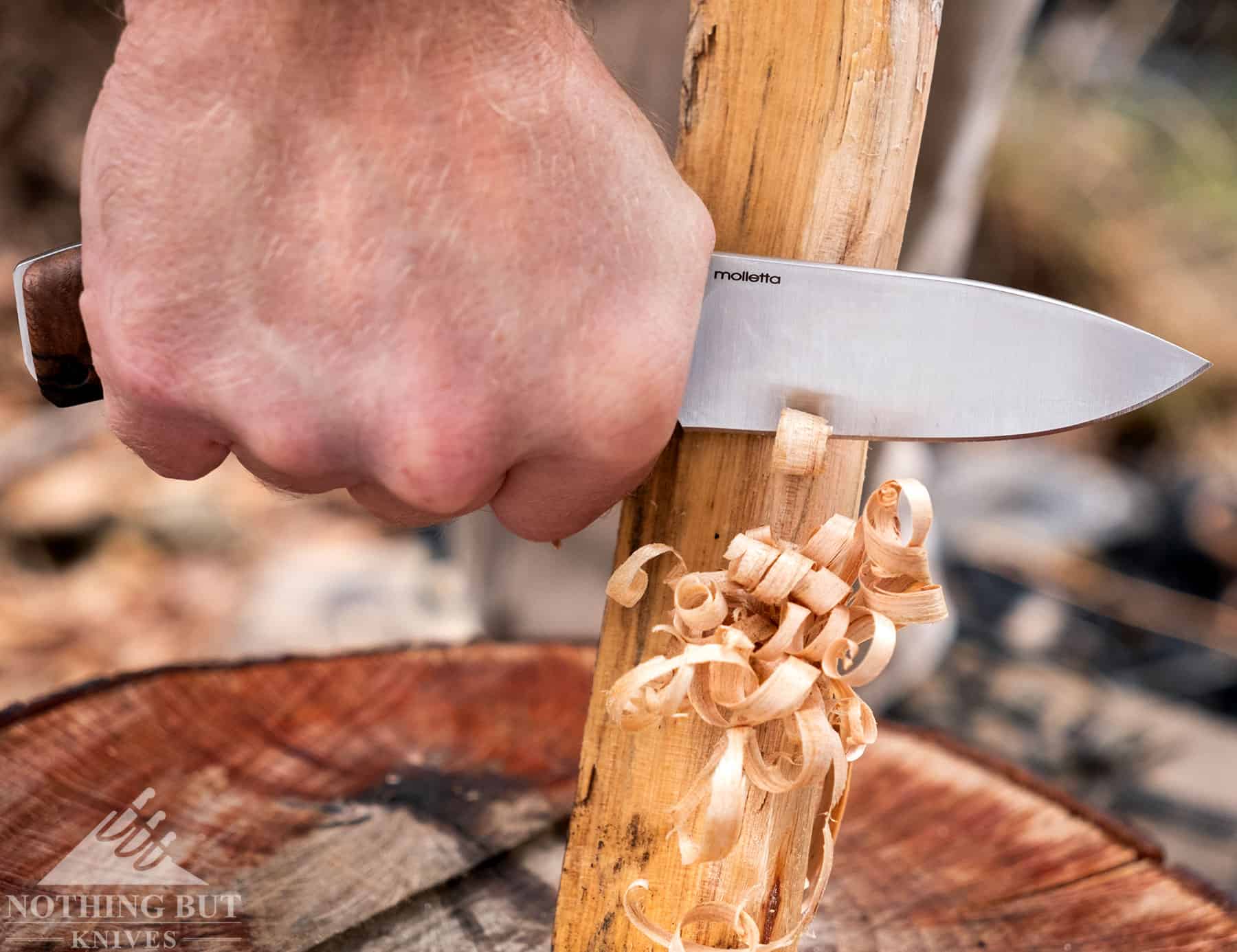
That oval-ish shape of the scales with a slight incline in the overall shape of the handle give the M4 a nice full-feeling grip. In fact, there are a lot of nice little contoured details in the handle that just make the thing melt into the hand.
That’s not to downplay the blade. That full flat grind is very slicey, which makes this a better cutter than carver, but it’s easy to control the angle you’re cutting, and the edge has an aggressive bite that starts showing results quickly. I’m also a fan of the M390 steel. It’s a very stable stainless steel that stands out in a genre of knife mostly dominated by either corrosion-prone, high-carbon steels or much softer, non-powder, stainless steels.
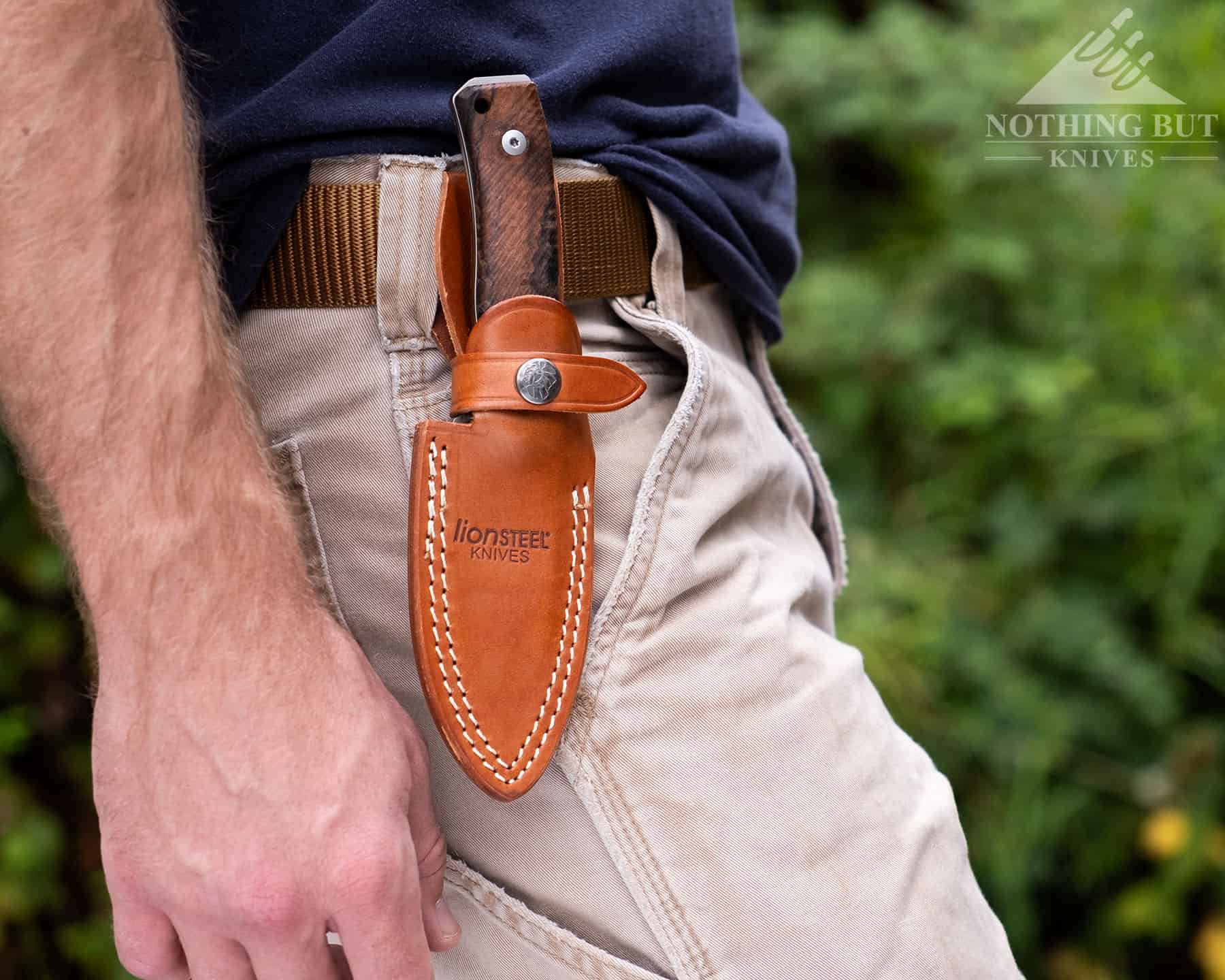
And don’t miss that sheath (before this little section gets too long winded). I know from first hand experience talking to the guys at LionSteel that they’re particular about their leather, and this double-stitched thing of beauty, simple as it may look, rides light and draws smooth as butter.
You can learn more about this impressive compact beast of a bushcraft knife by checking out our LionSteel M4 Review.
Fallkniven F1
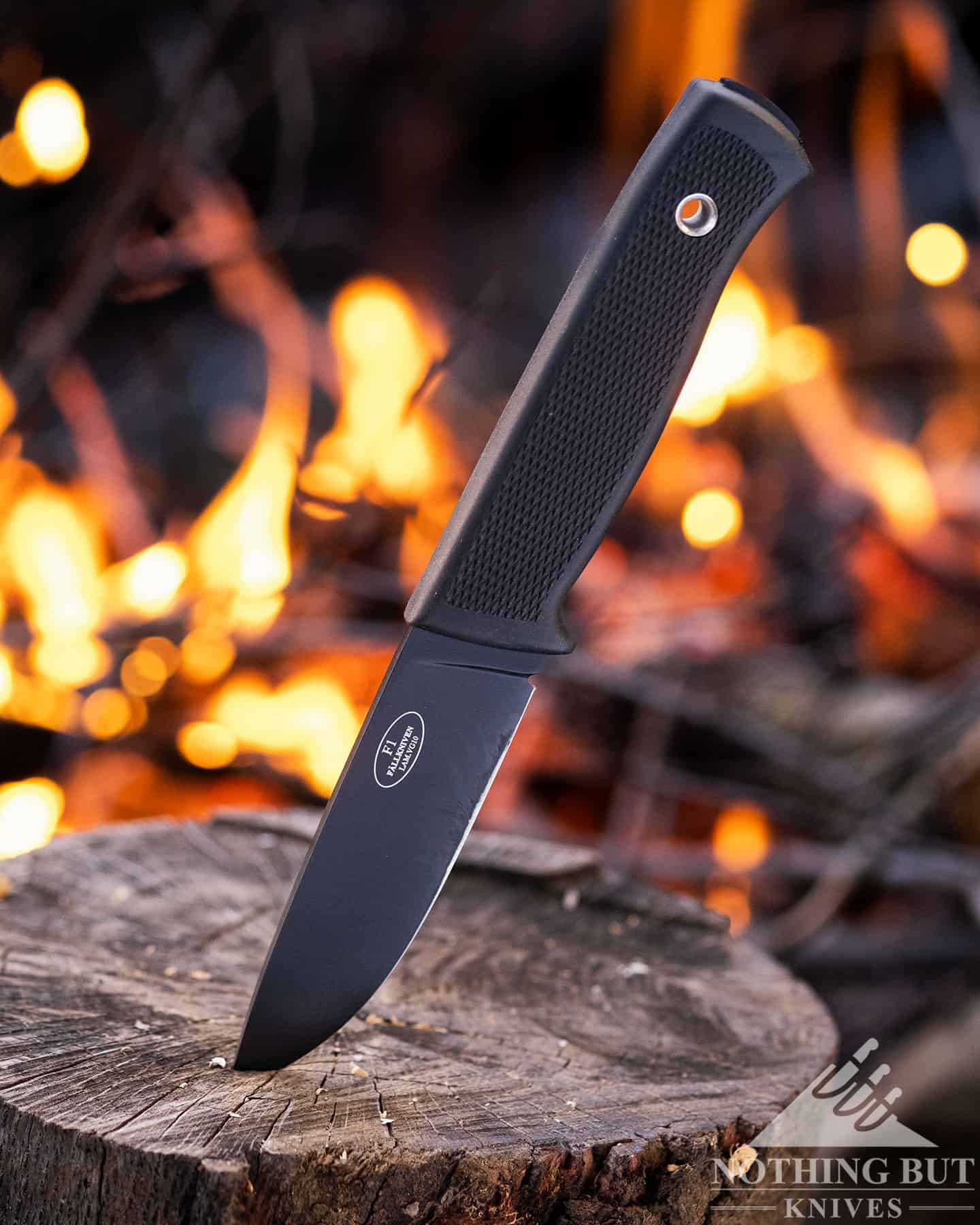
| Overall Length: | 8.25” |
| Blade Length: | 3.75” |
| Blade Steel: | VG-10 |
| Blade Style: | Drop point |
| Blade Grind: | Convex |
| Handle Material: | Thermorun |
| Sheath: | Leather |
| Made in: | Sweden |
This is the bushcraft staple. It’s lightweight with a neutral handle that works in every grip. The convex grind feels great for making feather sticks, it throws strong sparks off the spine with a ferro rod, and it’s a tough build (despite what some might think of VG-10 steel).
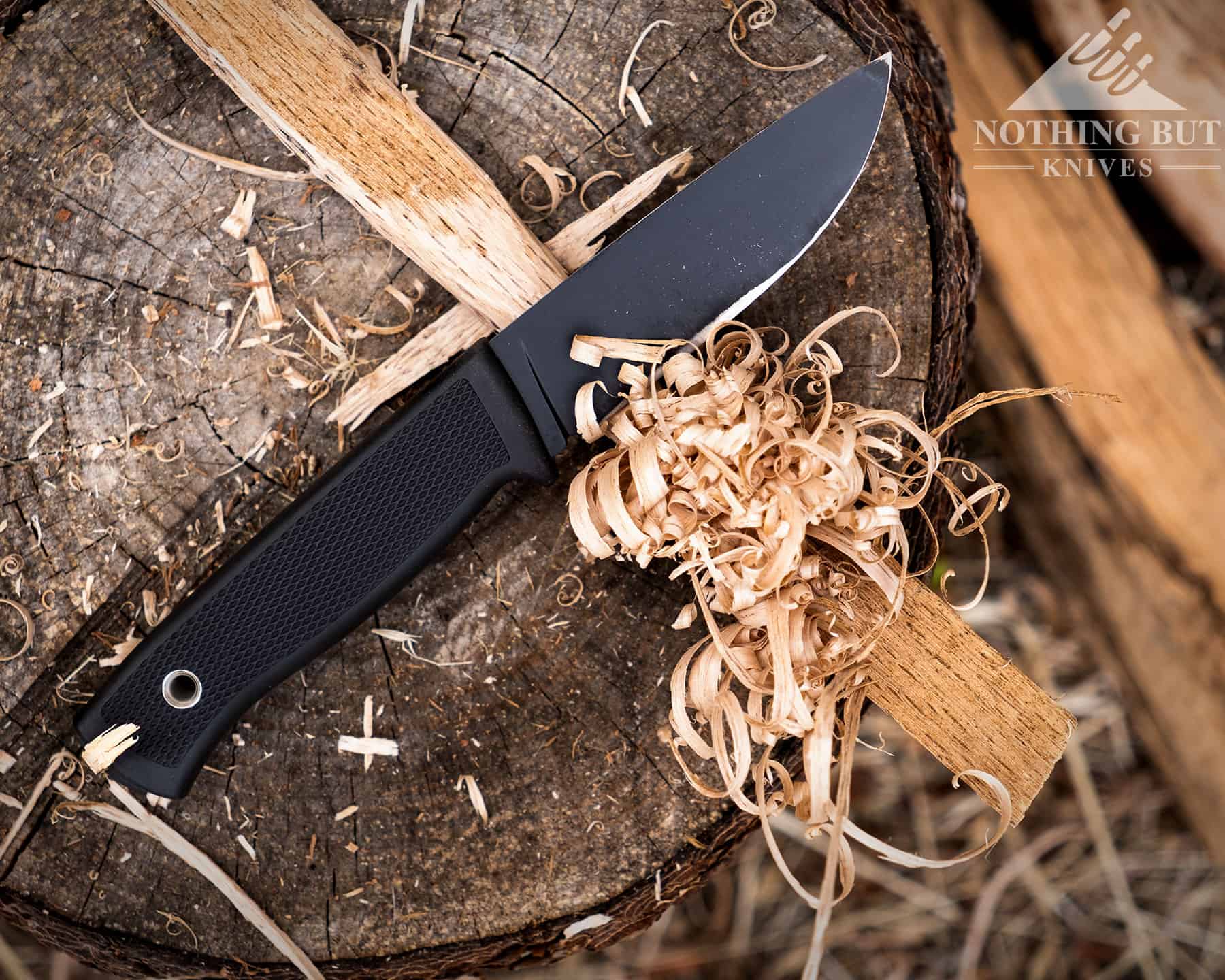
It’s not so good at chopping, but that’s not why we’re here. It’ll baton through partial logs fine so long as you don’t tackle anything too large. It starts splitting early, but not always early enough that you won’t need to hammer at the tip a few times. Otherwise, it’s a very versatile blade. It carves, it cuts, it’s nice for pretty much any kind of campsite cutting you need to do except for food prep, and it just doesn’t chip or roll all that easily.
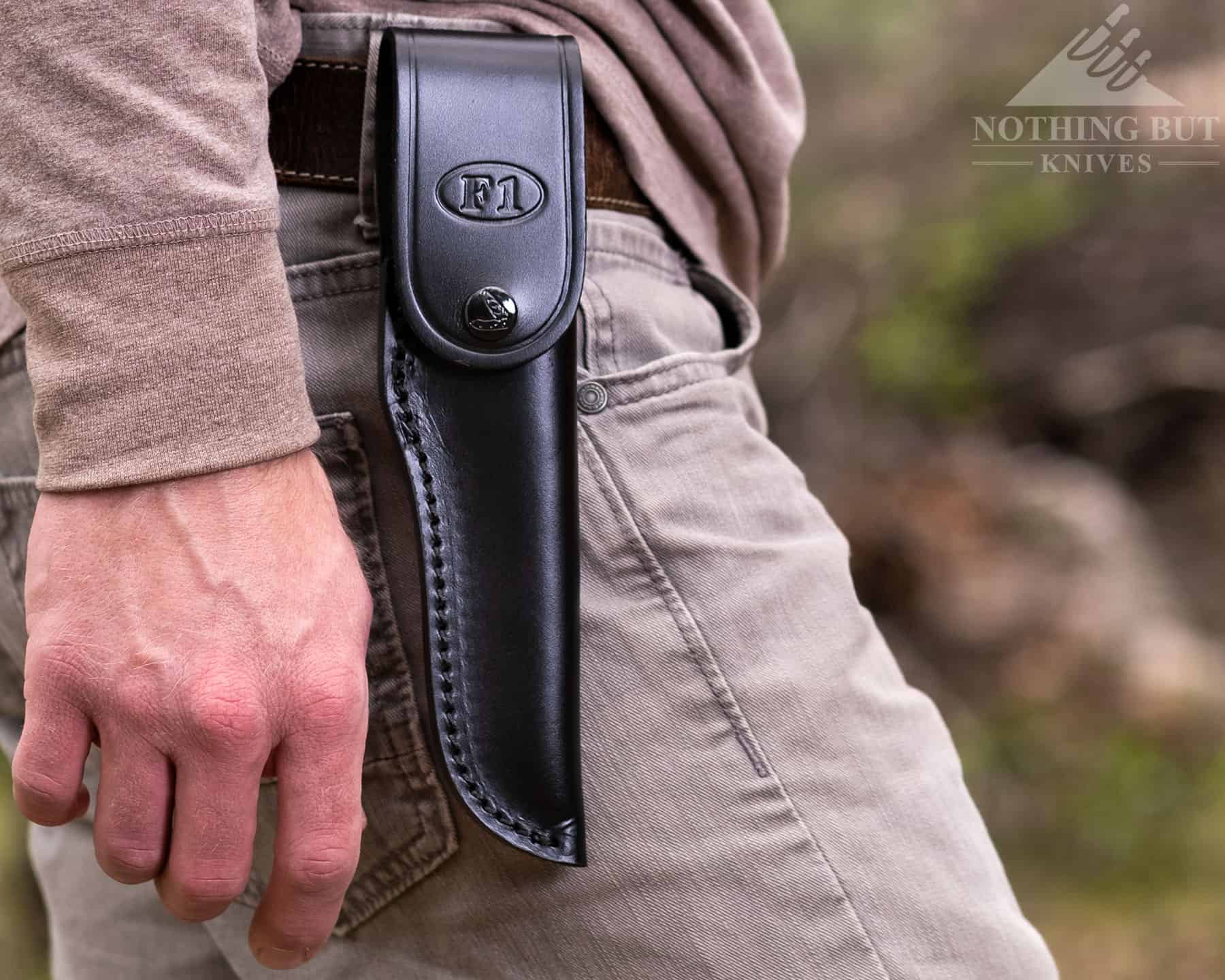
Sheath options are a little weird. The original leather sheath is a large, almost cumbersome design with an over-handle wrap. It looks nice, but it was made for pilots, and unless you’re at risk of moving from a mid-flight plane to the ground it feels like too much sheath for a mid-sized knife. The other option is a simple Zytel sheath without a loop for the belt similar to Morakniv sheath, but there are add ons.
You can read our full review of the Fallkniven F1 here.
TOPS Woodcrafter (Best Bushcraft Knife For Woodwork)
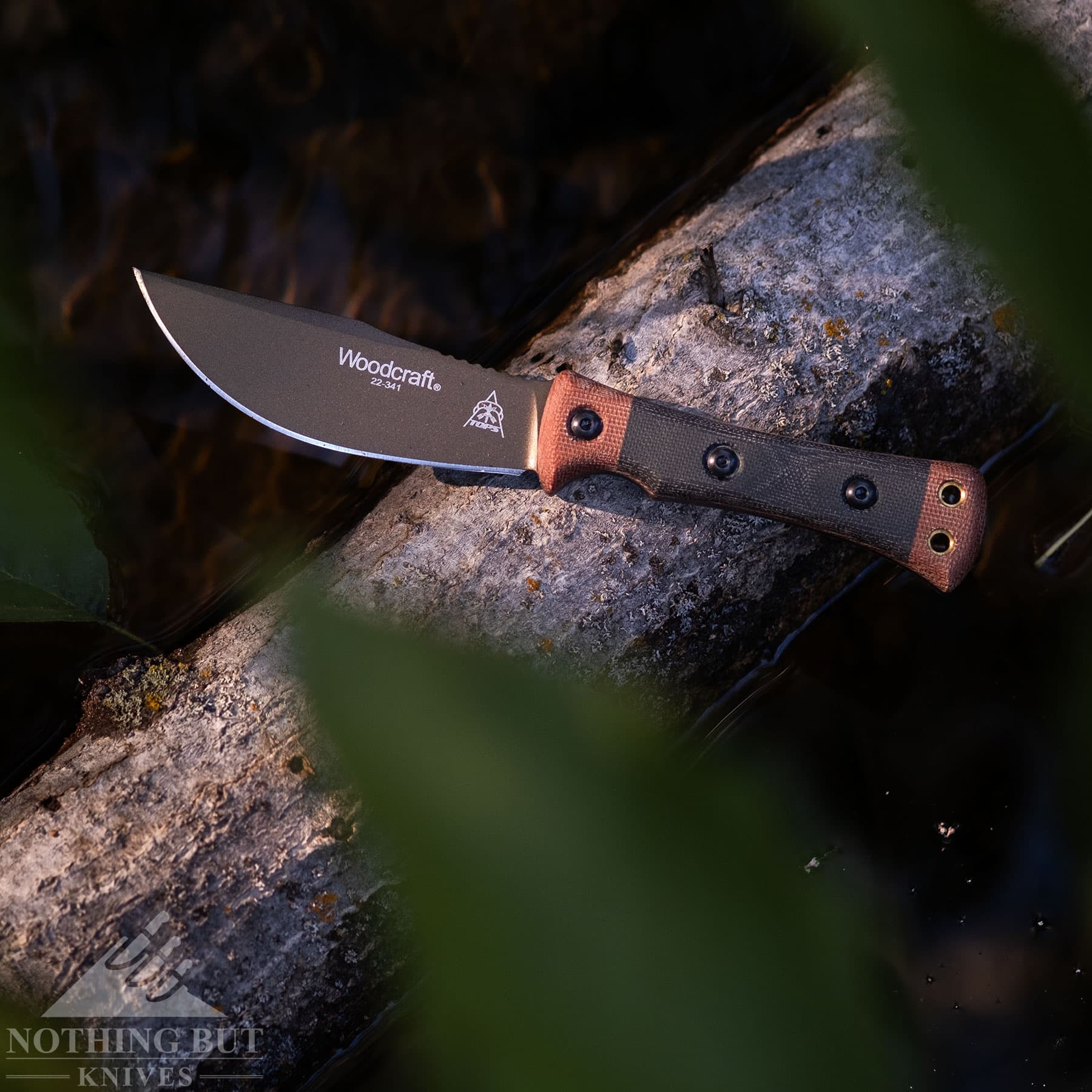
| Overall Length: | 8.75” |
| Blade Length: | 4.38” |
| Blade Steel: | 1095 |
| Blade Style: | Clip point |
| Blade Grind: | High flat |
| Handle Material: | Micarta |
| Sheath: | Leather |
| Made in: | USA |
This is a remake of a Marble’s Knives design from way back. The main difference is that the handle has Micarta scales instead of the stag bone or stacked leather of the original. They also reduced the pommel size significantly.
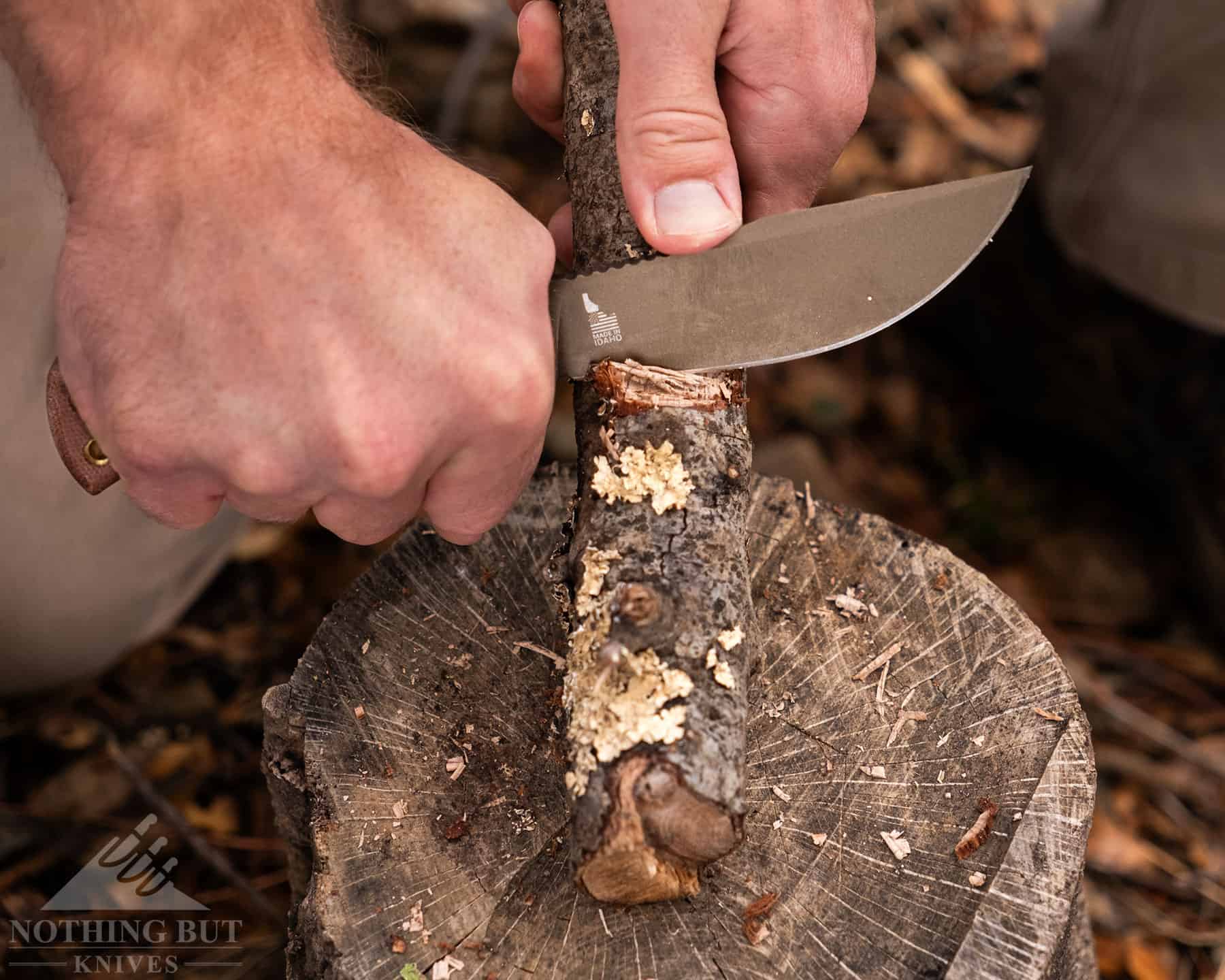
The handle is thin and boxy but still plenty comfortable thanks to the way they’ve rounded the corners. That shaping and the indent for the index finger put a lot of control for carving into your grip. The jimping on the spine creates great traction for the thumb too. It’s almost too aggressive, but you better bet nothing will slip while you’re working.
There’s a lot of belly to this blade, which is an excellent shape for shaving wood in a range of sizes. It lets you get thinner by slicing along the whole length of the belly, and still leaves enough of a flat edge for biting directly in wood to create notches.
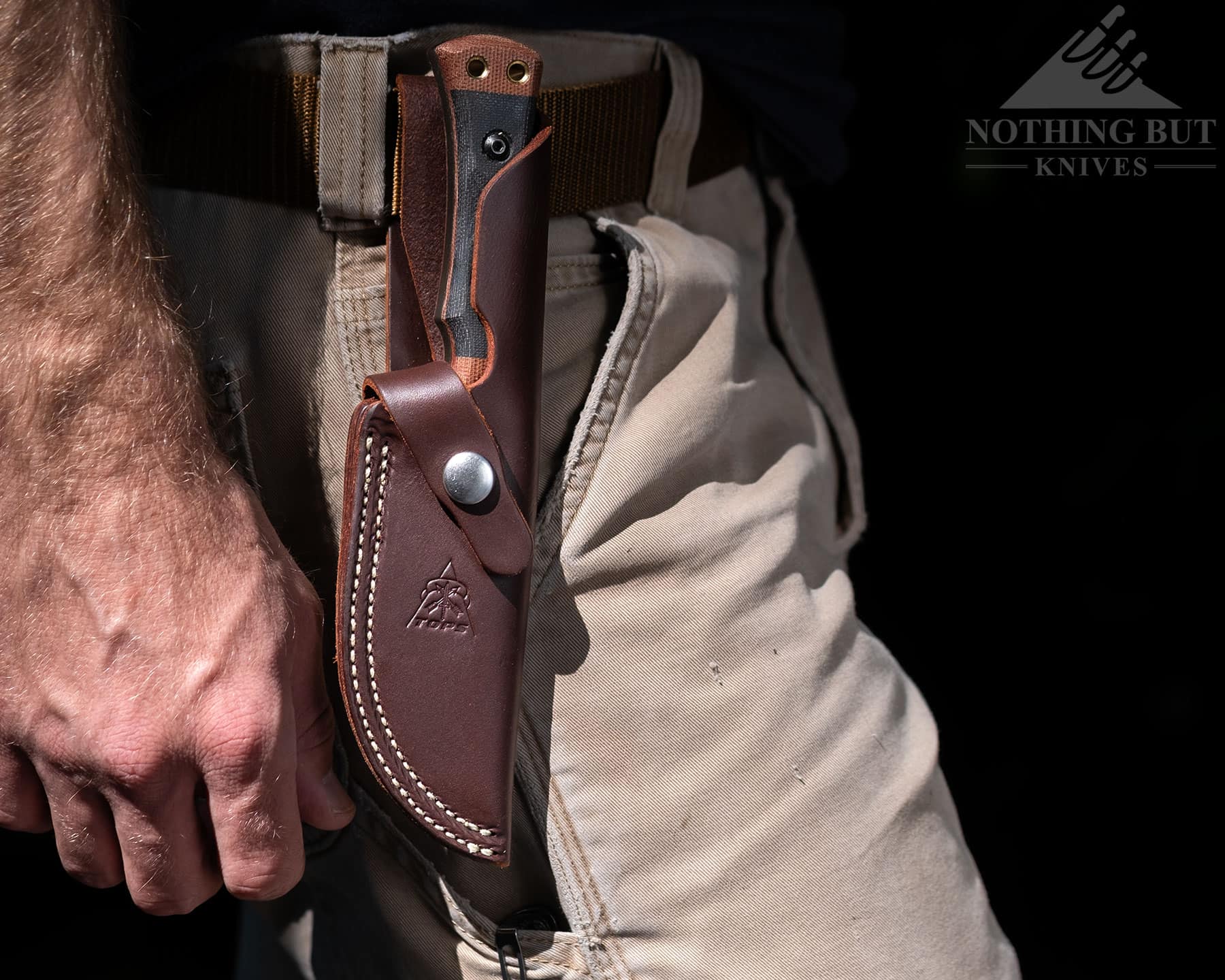
It rides nice and low in the leather sheath without bumping the hip while hiking too much. The retention strap can make sheathing the knife a two-handed pain, but it’s otherwise nice set up. Overall, it’s a satisfyingly functional remake of a classic design.
CRKT Bugsy
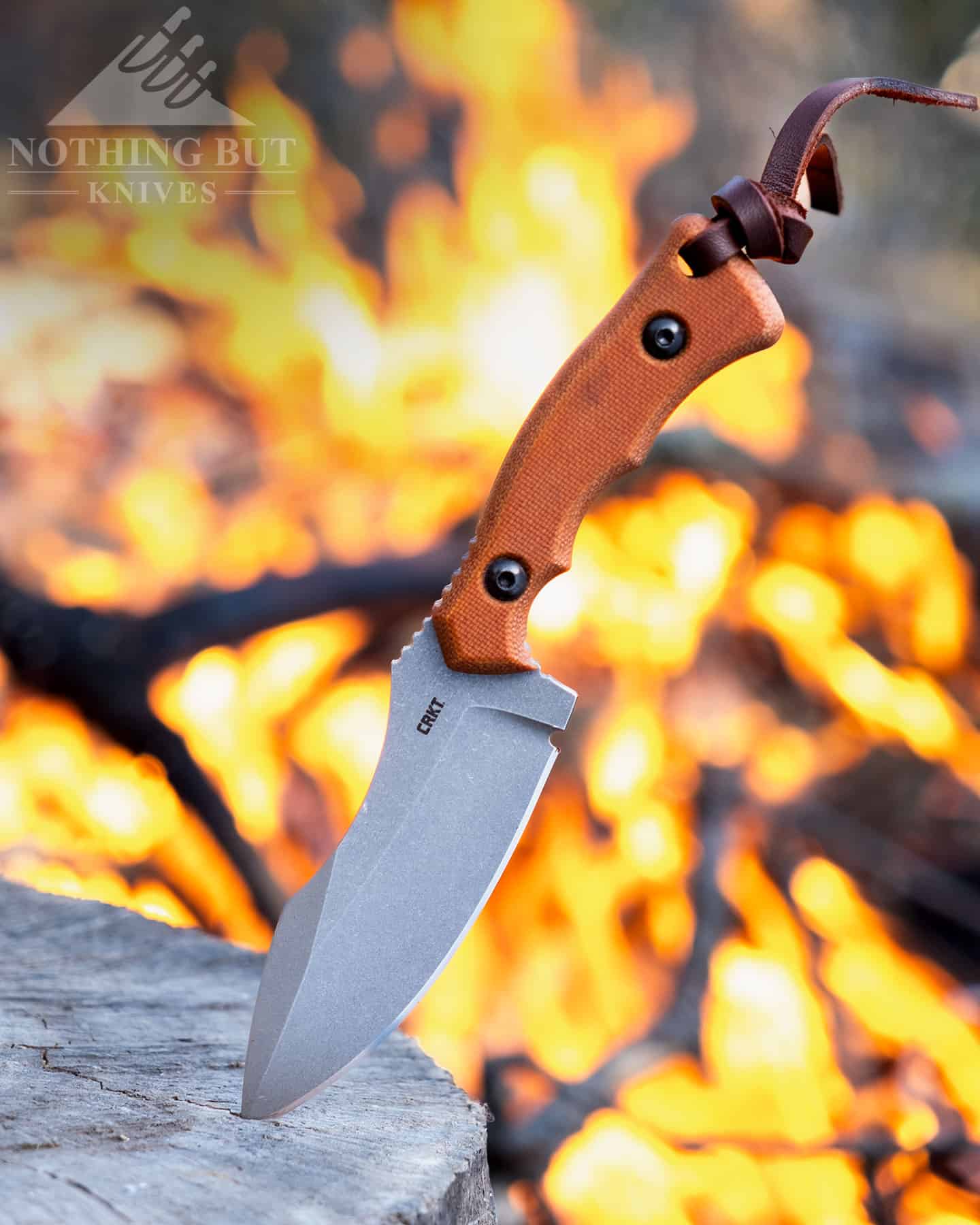
| Overall Length: | 7.44” |
| Blade Length: | 3.78” |
| Blade Steel: | 1095 |
| Blade Style: | Harpoon |
| Blade Grind: | Flat |
| Handle Material: | Micarta |
| Sheath: | Leather |
| Made in: | USA (TOPS) |
| Designer: | Kaila Cummings |
This has little-big knife energy thanks to the tall blade on an otherwise small-ish knife.
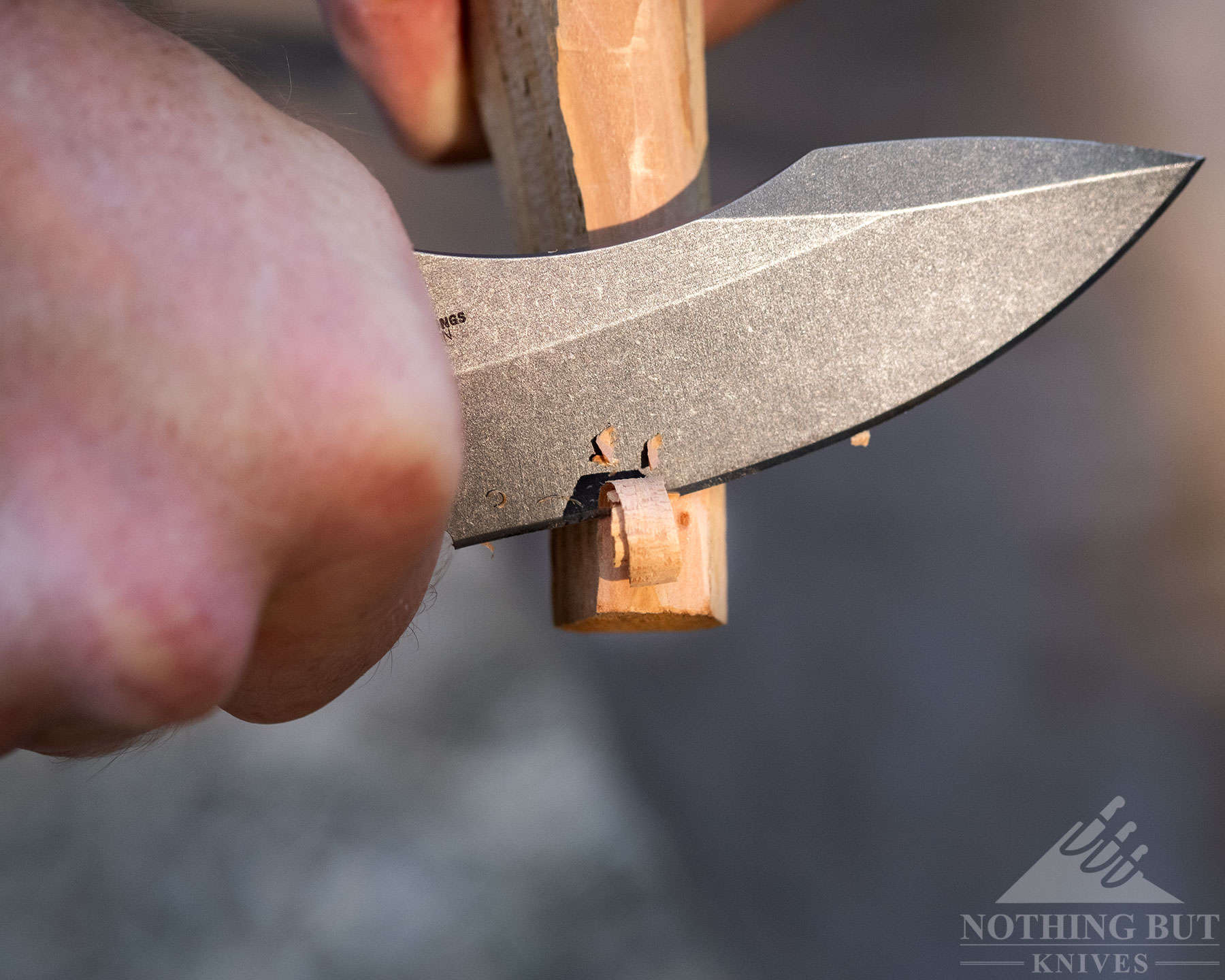
The handle is compact which is mostly great, but can get a little uncomfortable if you have wider (or fat) hands. But it has a hell of a secure grip. The way it curves inward makes it feel like the handle is grabbing you back and makes it really easy to generate momentum and find some extra leverage to push or pull through knots or thick rope.
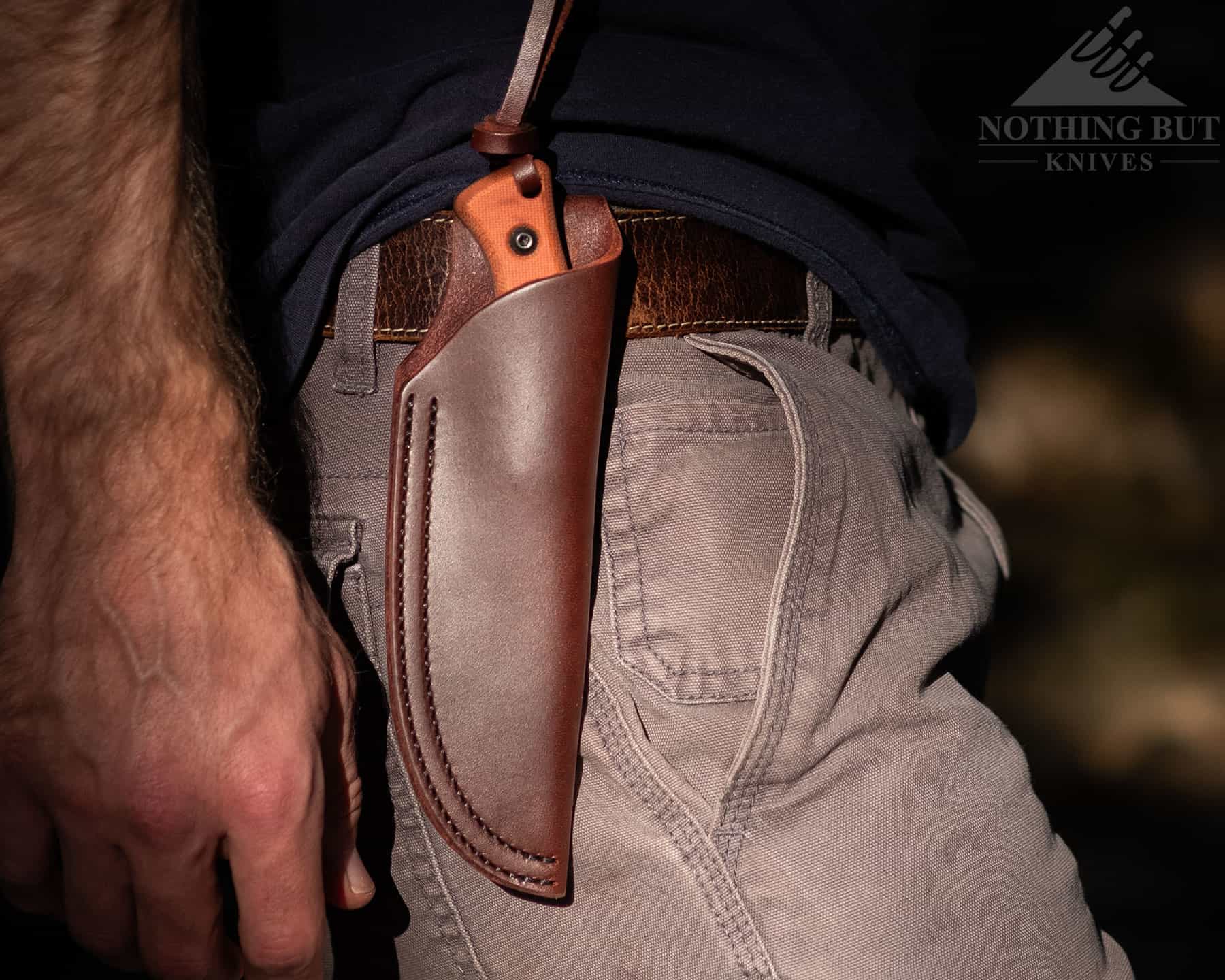
It’s available in two configurations. One is the plain edge with a leather sheath (which is what we tested), or you can get one with Veff serrations and a Kydex sheath. I know from other CRKT designs that those Veff serrations are great on rope, so that might be the better option for some circumstances, but having the full 3.7 inches of the cutting edge in a plain grind is much better for carving.
I like to think of this as the close-handled alternative to the TOPS Woodcarver. They both have similar blade styles with similar intentions, but the Bugsy is definitely the way to go if you want a shorter knife or a more secure grip.
You can check out our full review of the CRKT Bugsy here.
Best Fixed Bushcraft Knives Under $300
When you look at spending over $200 dollars on a knife it really starts to become a matter of just really loving a knife. Stuff here is high functioning, usually with really nice steel that’s been ground out by some highly skilled folks.
White River Knives (Best Bushcraft Knife For Starting Fires)
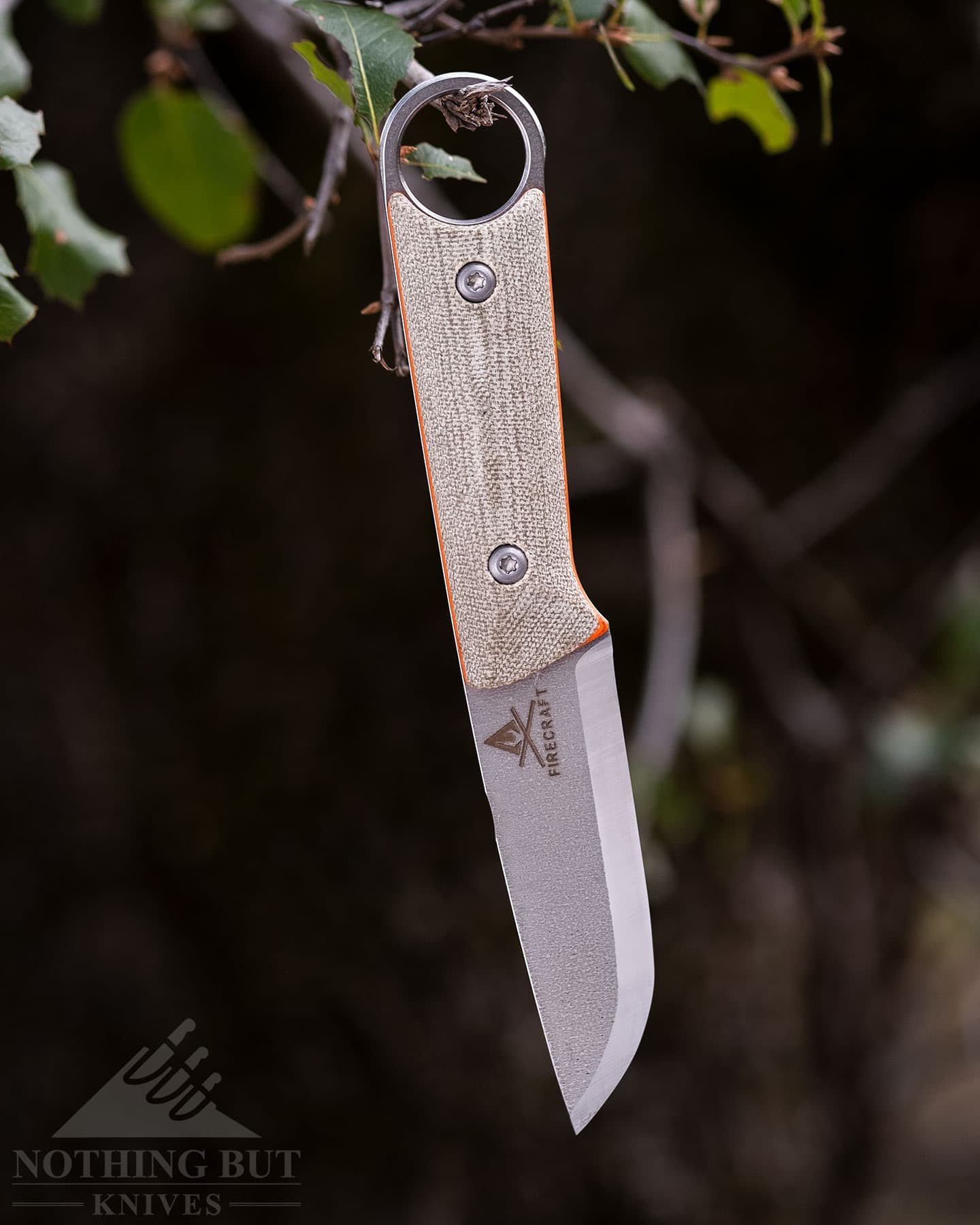
| Overall Length: | 8.0” |
| Blade Length: | 3.7” |
| Blade Steel: | CPM-S35VN |
| Blade Style: | Drop point |
| Blade Grind: | Scandi |
| Handle Material: | Micarta |
| Sheath: | Kydex, moddable |
| Made in: | USA |
| Designer: | Jason Tietz |
This shows up in our survival knives blog too because it’s such a robust little thing with an enormous amount of utility for the amount of space it takes up, the scandi grind has an aggressive edge that works fast, and the finger ring gives it some bonuses for being able to quickly draw the knife and get a little more grip security in harsh conditions.
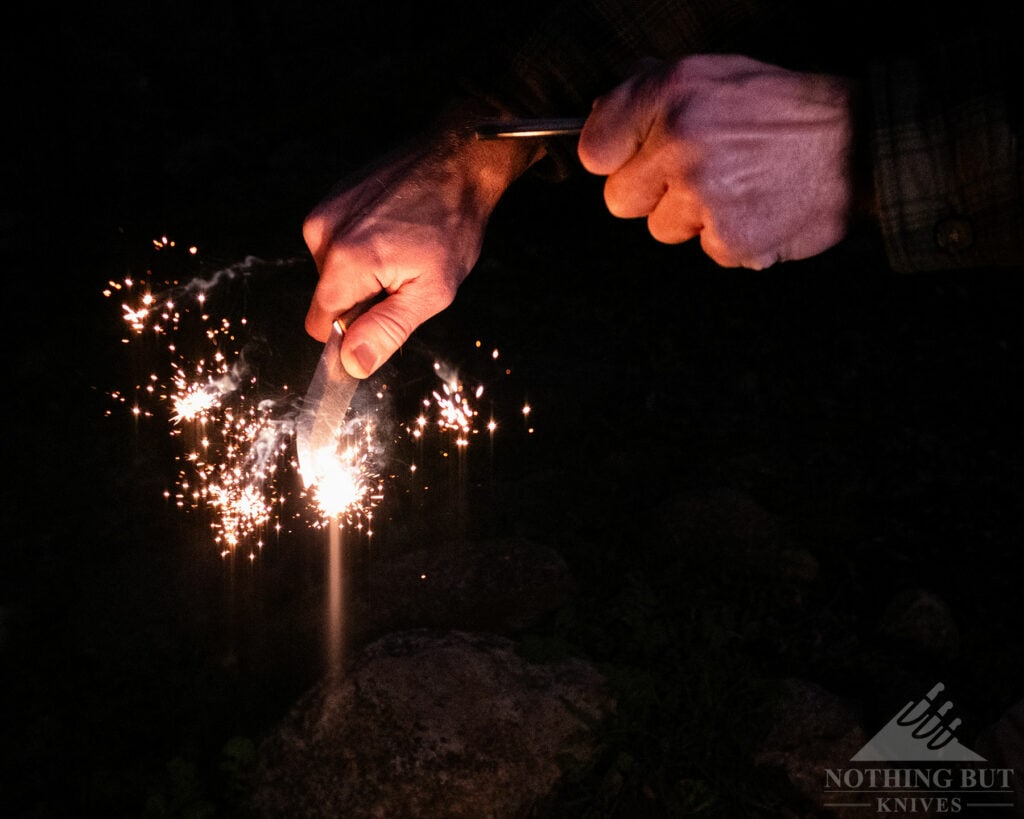
But the way this thing can carve up wood, make notches, curl out a feather stick, and just be an all around champ at the camp site make it a no-brainer for dedicated bushcraft tasks. The handle scales fill out the palm nicely and leaves a lot of room for shifting your grip despite the somewhat smaller size of the whole thing, and there’s scalloping at the top of the handle so it feels pretty good in a pinch grip.
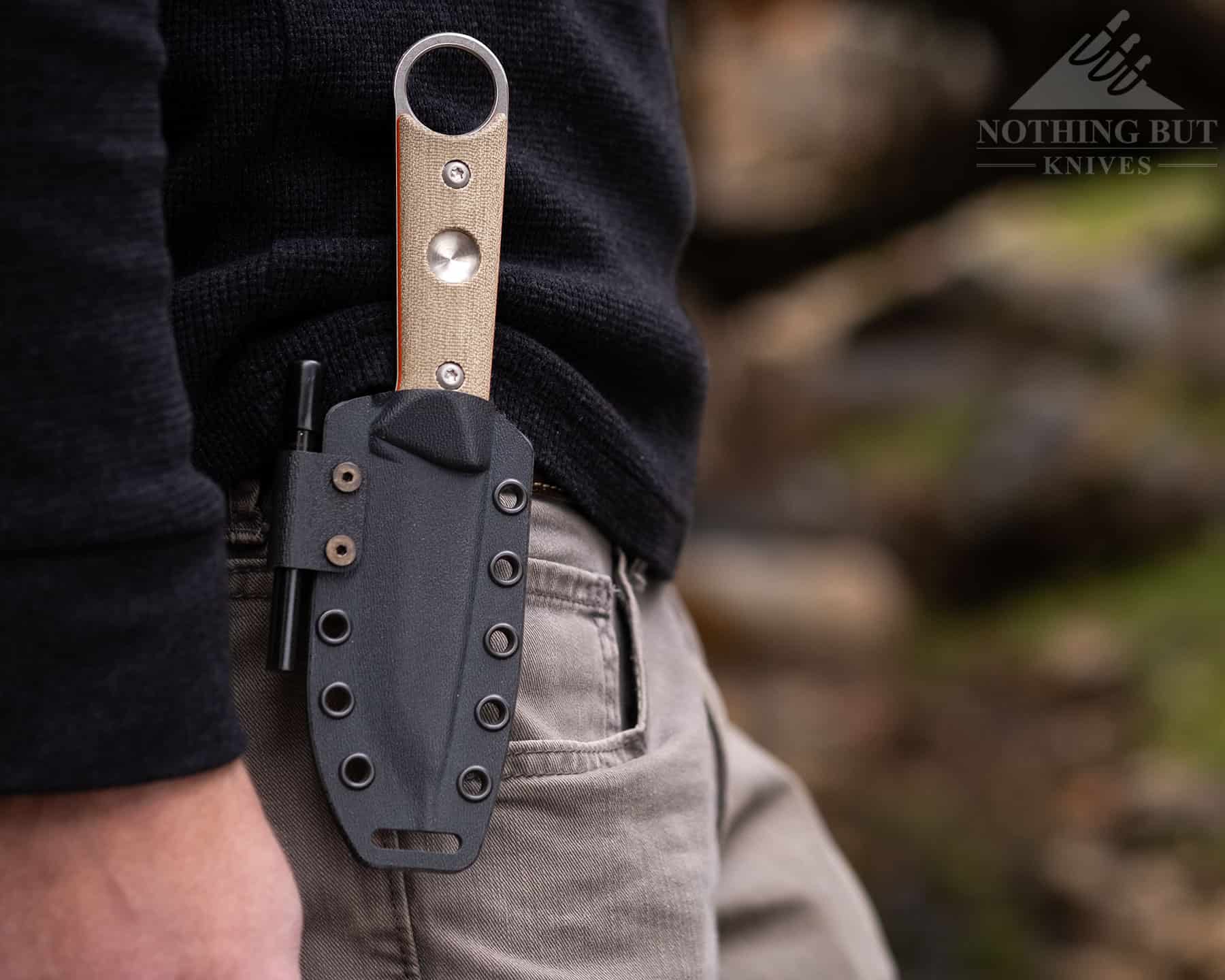
The sheath can be pretty easily converted for left or right hand carry in vertical and horizontal positions, and it comes with a ferro rod already set into the side, so this is a camp-ready package.
Read our full review of the White River Firecraft Puuko here.
Nordsmith Pilgrim LT
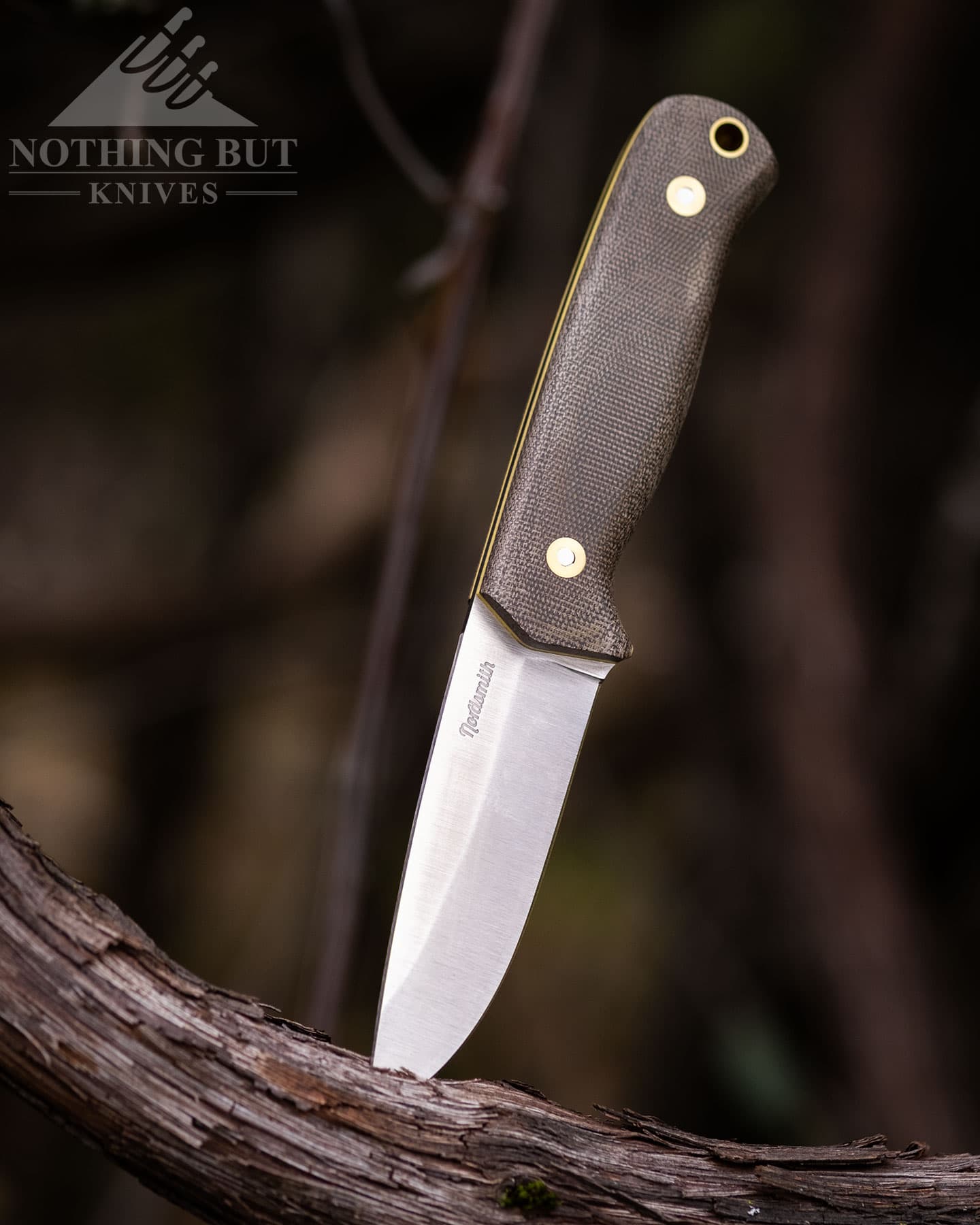
| Overall Length: | 8.675” |
| Blade Length: | 3.8125” (3.75” sharpened edge) |
| Blade Steel: | AEB-L |
| Blade Style: | Drop point |
| Blade Grind: | High flat |
| Handle Material: | Micarta |
| Sheath: | Leather |
| Made in: | USA (LT WRight) |
| Designer: | David C. Anderson |
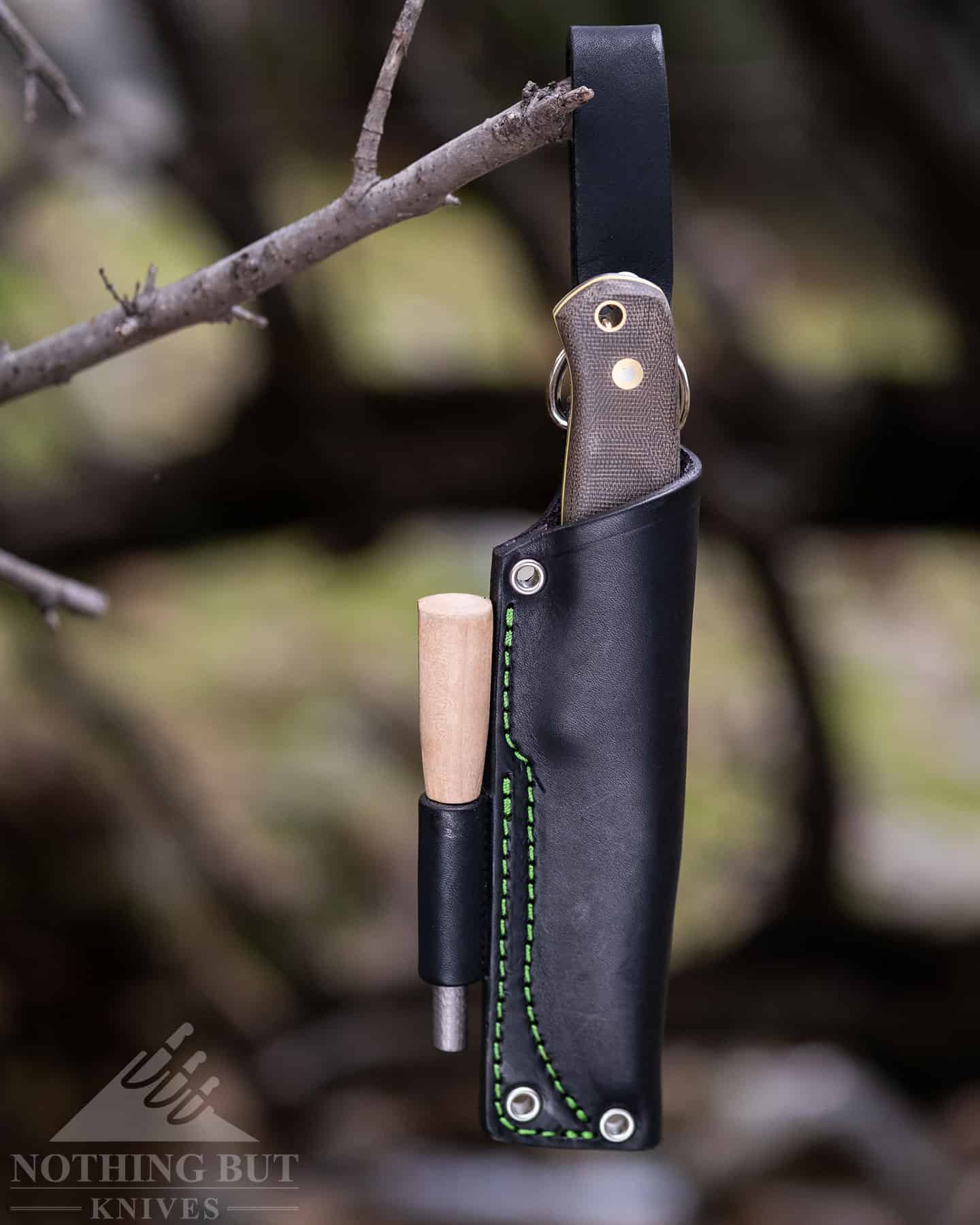
This is the mid-sized option from the mind and larger-than-average-sized hands of David C. Anderson. It’s more or less standard in terms of camp-knife design, but it has an excellent handle for wide hands (no, not just big). It has a boxy shape with rounded corners that make it easier to control the angle of the edge when you’re carving. Actually, this feels like a little like the Joker Bushcraft, just with a slightly wider handle.
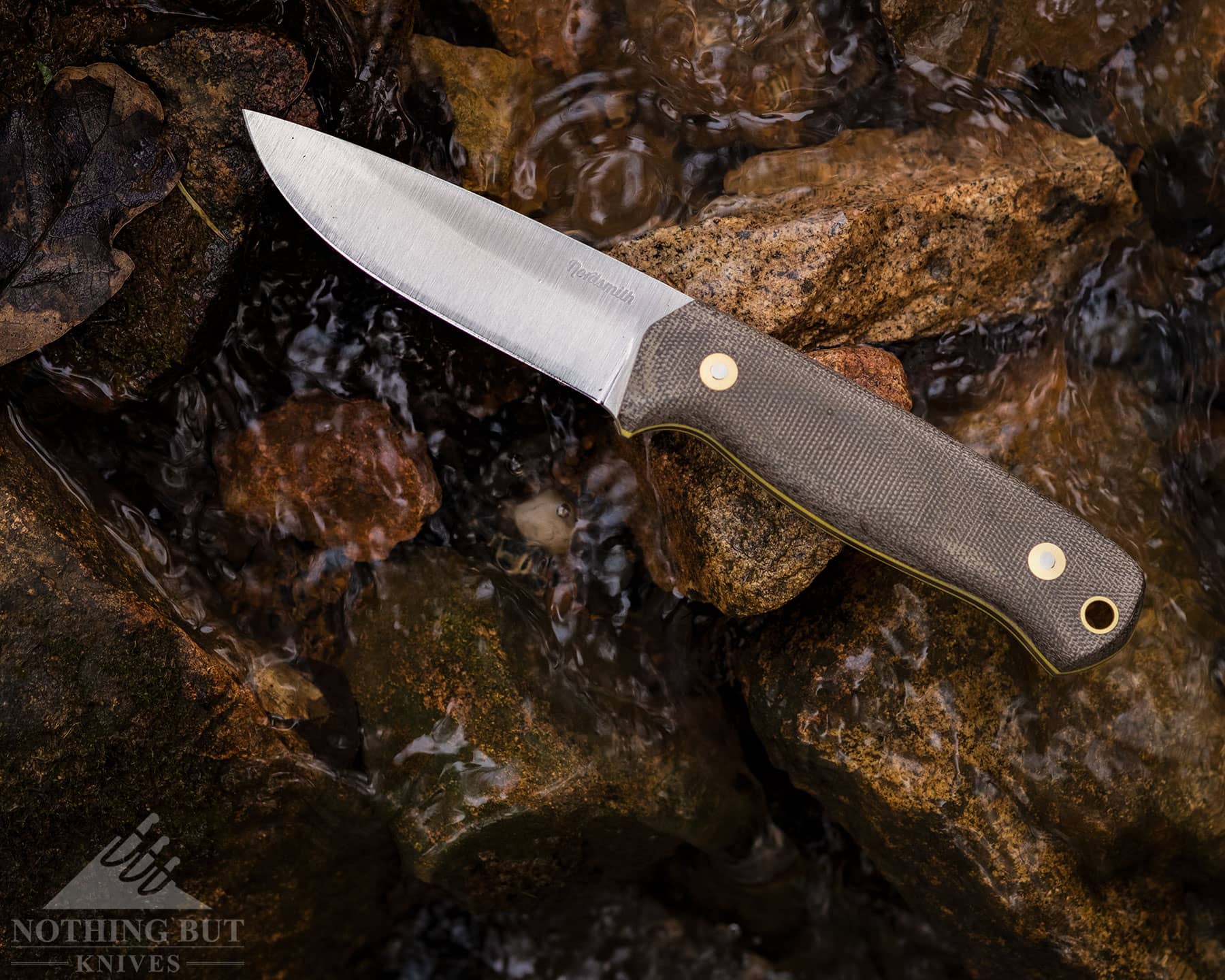
The handle also has just a bit of a forward hook at the pommel, which goes a long way in keeping your hand in place when you’re chopping, and for getting a little extra leverage on tougher cuts. Otherwise, it’s one of those things that’s had a lot of careful thought put into finalizing it that you don’t see so much as feel, but you better believe the people at LT Wright fine tuned the hell out of the angles on this thing before it left the shop.
Best Bushcraft Knives Under $400
This is getting into rich territory, which is why it’s pretty sparse here. We’re hoping to add to it in the future, but for now, here’s what we’ve actually tested.
Reiff F4 Scandi (Best Premium Bushcraft Knife)
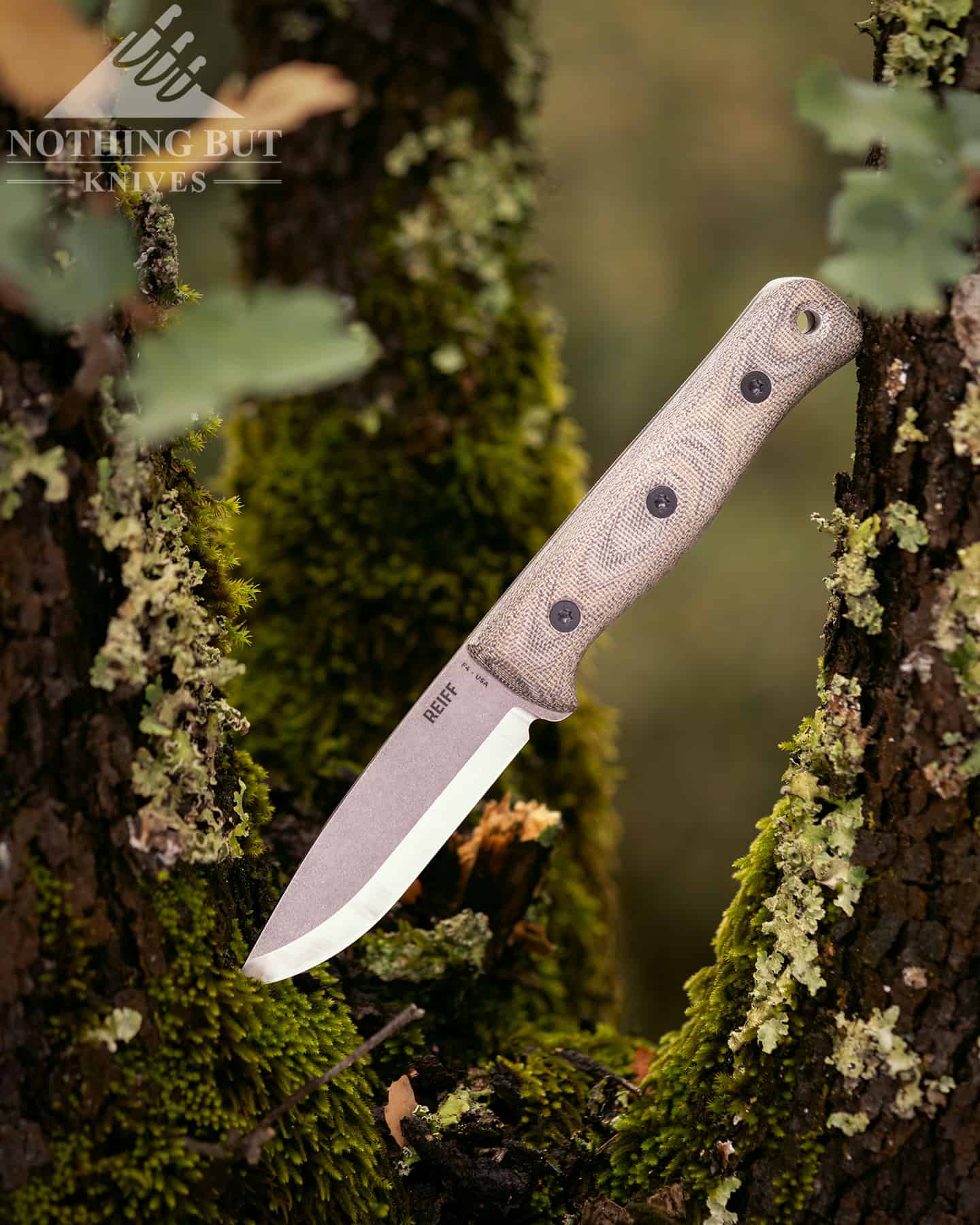
| Overall Length: | 9.0” |
| Blade Length: | 4.0” |
| Blade Steel: | CPM-3V |
| Blade Style: | Drop point |
| Blade Grind: | True scandi |
| Handle Material: | G10 |
| Sheath: | Leather |
| Made in: | USA |
| Designer: | The Reiff Brothers |
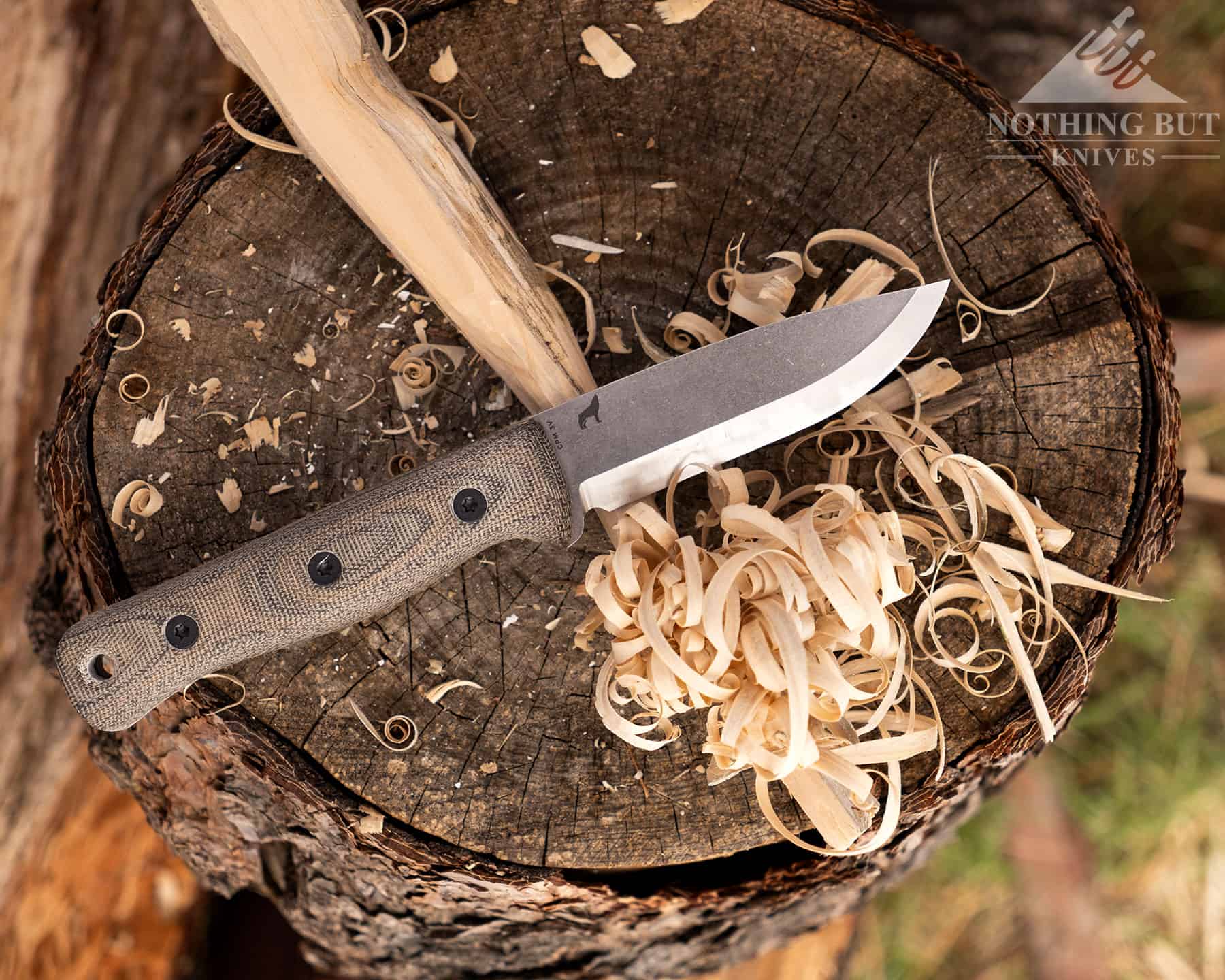
This is easily one of the most comfortable knives on this list. Reiff shapes all their handles so the top half is wider with a nice slope halfway down that fits along the palm of the hand nicely. The result is that it feels incredibly easy to control the angle of the blade while carving.
And this particular version of the F4 has a scandi grind with a zero edge (meaning no secondary bevel) so all that control from the handle is a lot more efficient at carving, chopping, and batoning wood.
That handle shape is really optimized for carving over chopping, though. The descending shape of the pommel takes away some grip security when you’re really swinging. The grippy nature of the Micarta helps make up for that, but the fact remains that this is a carver, cutter, and batoner over a chopper.
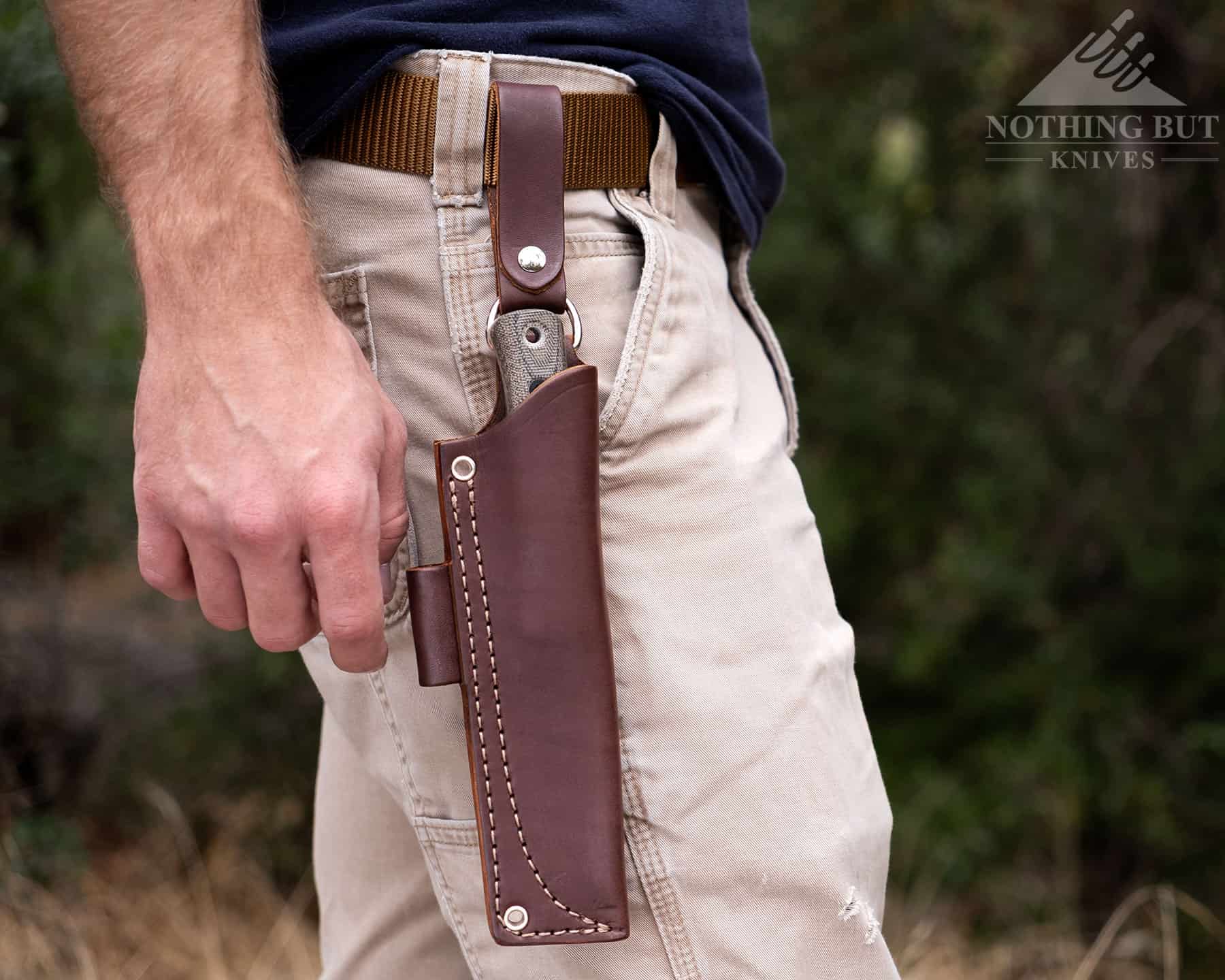
The sheath is pretty straight forward. It’s drop-leg carry, but there’s another loop against the main sheath if you want to carry it on your hip. It has a loop for a ferro rod, and the leather is pretty nice.
You can read our full review of the Reiff F4 here.
Folding Bushcraft Knives
It’s a small category, but a pocket knife designed for bushcraft can be a pretty special thing at the campsite. Any knife can whittle, but some pocket knives really excel at carving and comfort, and generally being more robust than your average folder. Here we mostly looked for folding knives with scandi grinds.
Best Folding Bushcraft KNives Under $50
There are not many bushcraft style folding knives in this price range, but we will continue to watch for new releases that might be a good fit as folding bushcraft knives become more popular.
Cold Steel Finn Wolf
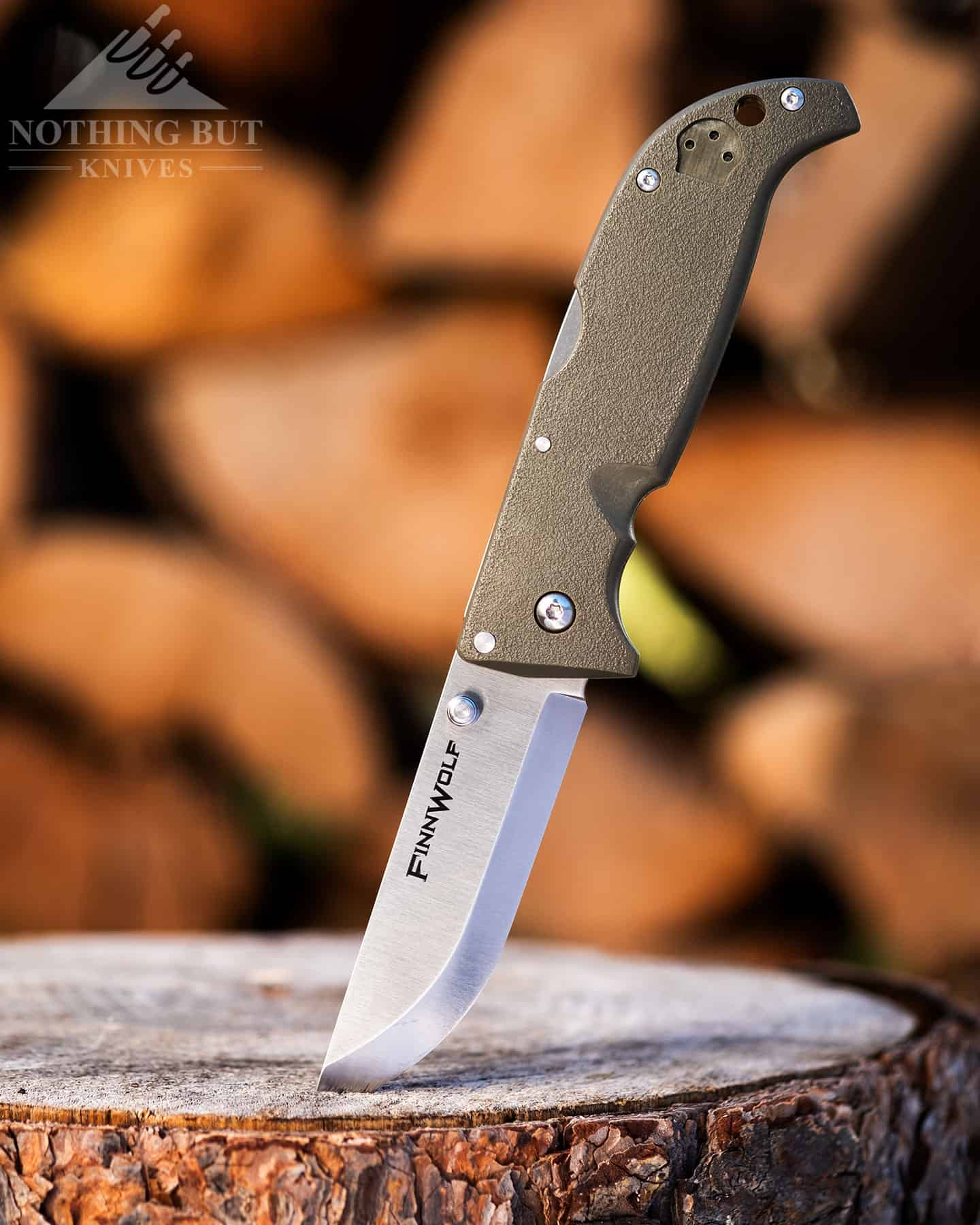
| Overall Length: | 7.875” |
| Blade Length: | 3.5” |
| Blade Steel: | AUS-8A |
| Blade Style: | Standard |
| Blade Grind: | Scandi |
| Handle Material: | Griv-Ex |
| Lock: | Backlock |
| Carry System: | Tip-up pocket clip, reversible |
| Made in: | Taiwan |
| Designer: | Andrew Demko |
The Finn Wolf is a sleeper classic at this point. It’s an Andrew Demko design from the early wonder years of Cold Steel, and has remained one of the best budget hard-use knives on the market.
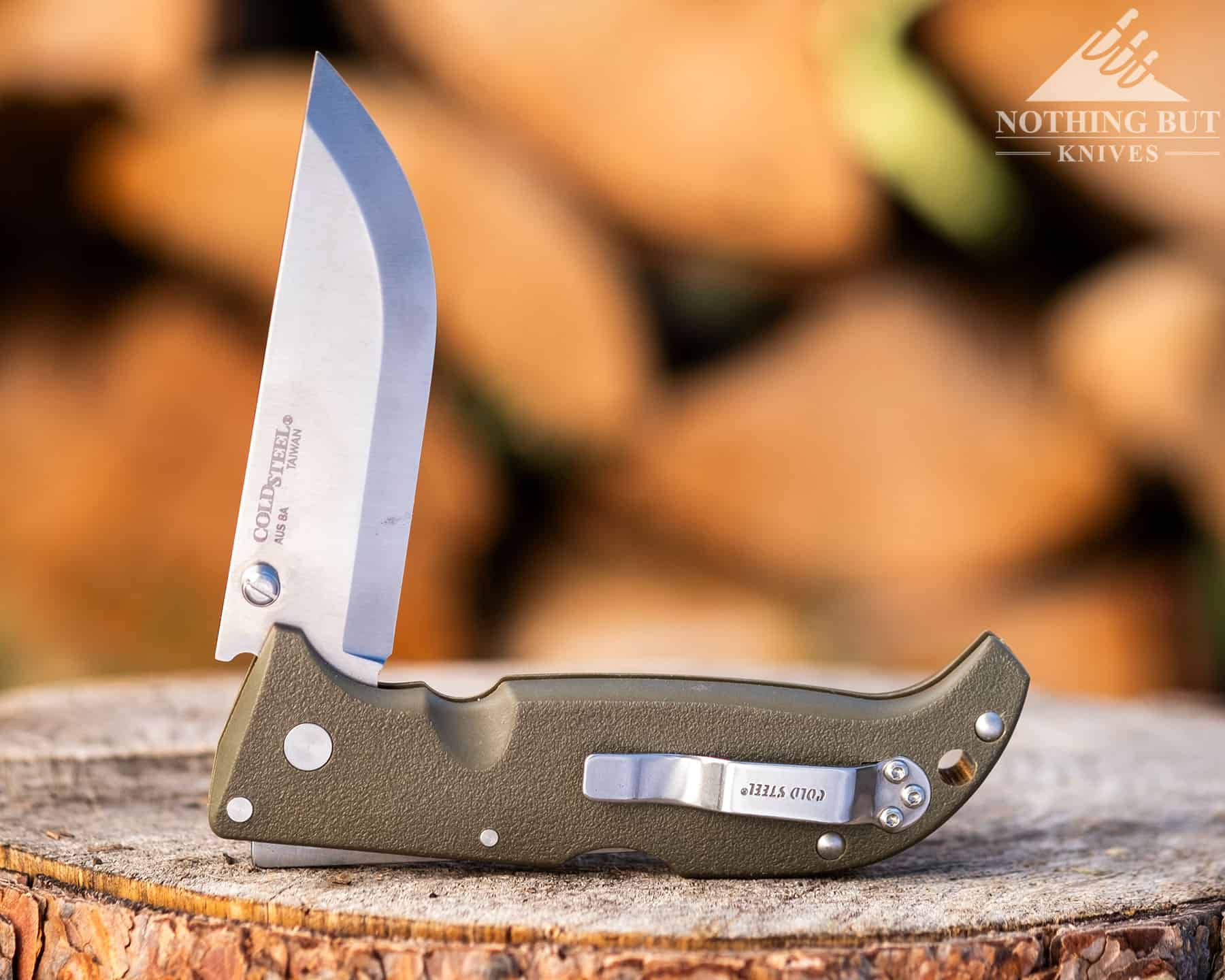
It also happens to have a nice scandi grind and a grippy, weather-proof handle. It might be one of the least comfortable knives on this list by virtue of it being one of the few with a thin, synthetic handle, but it has secure ergos with a solid backlock, and the shape helps index the edge so you’ll usually have a good sense of what direction you’re cutting.
The pocket clip is reversible, and there’s a thumb stud opener on both sides of the blade, so this is a truly ambidextrous blade. It might not be the prettiest thing you can get, but it’s the best deal you’re likely to find anywhere in terms of dollars-per-mile.
Best Folding Bushcraft KNife Under $100
Chances are a pocket bushcraft knife is often going to be a backup to a fixed blade, so this price range makes sense from a value standpoint.
Real Steel Pathfinder
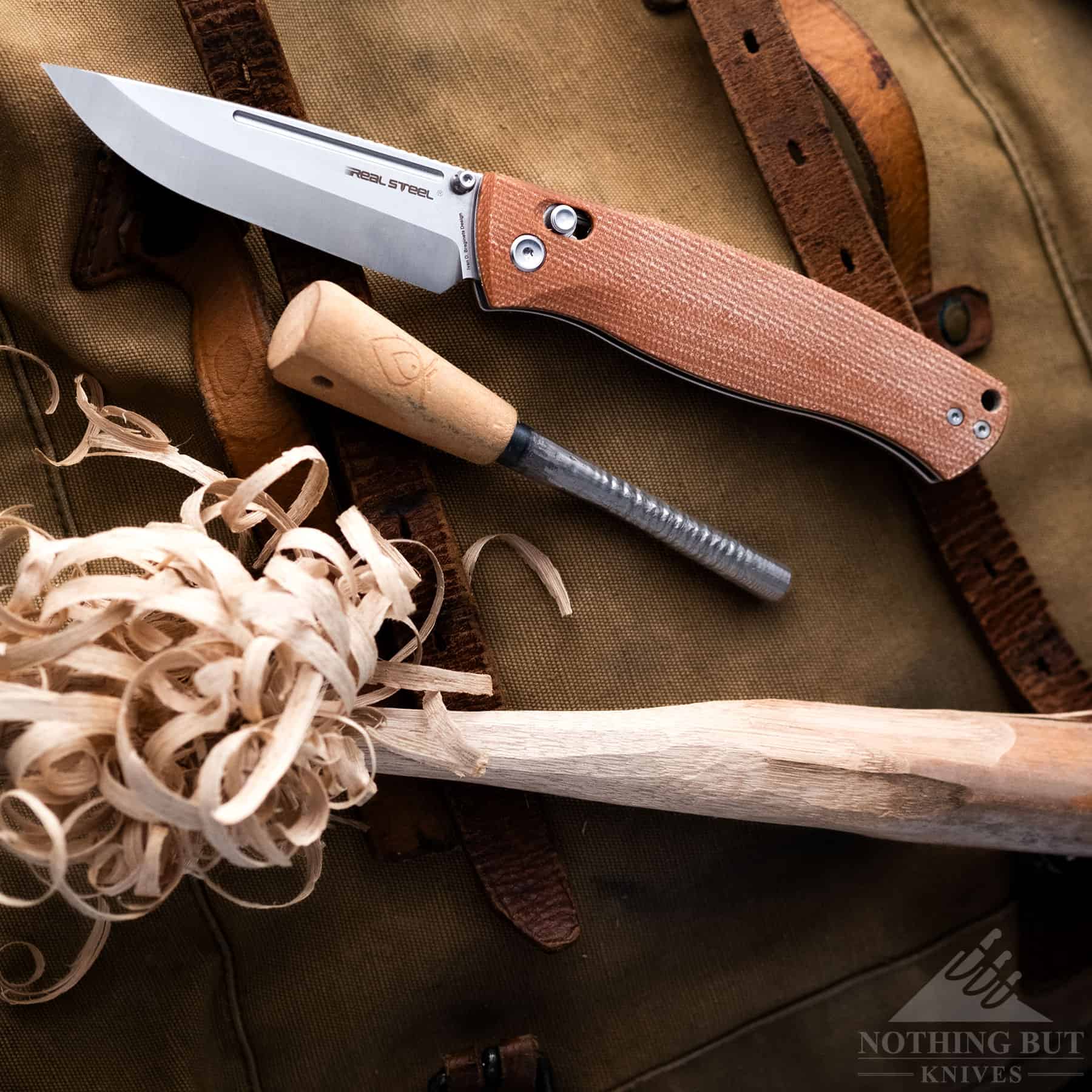
| Overall Length: | 8.76” |
| Blade Length: | 3.83” |
| Blade Steel: | Sandvik 14C28N |
| Blade Style: | Drop point |
| Blade Grind: | Scandi |
| Handle Material: | Micarta |
| Lock: | Crossbar |
| Carry System: | Tip-up clip |
| Made in: | China |
| Designer: | Ivan Braginets |
The Pathfinder benefits enormously from having a long neutral handle and a fairly thin scandi grind. The edge is on the slicier side of this kind of edge geometry, which makes it feel a little more EDC than other folders you might see on this list. It can still carve out shapes and feathers of a chunk of wood just fine, but it might not offer quite as much control in that use case as something like the Pinhoti or the Finn Wolf.
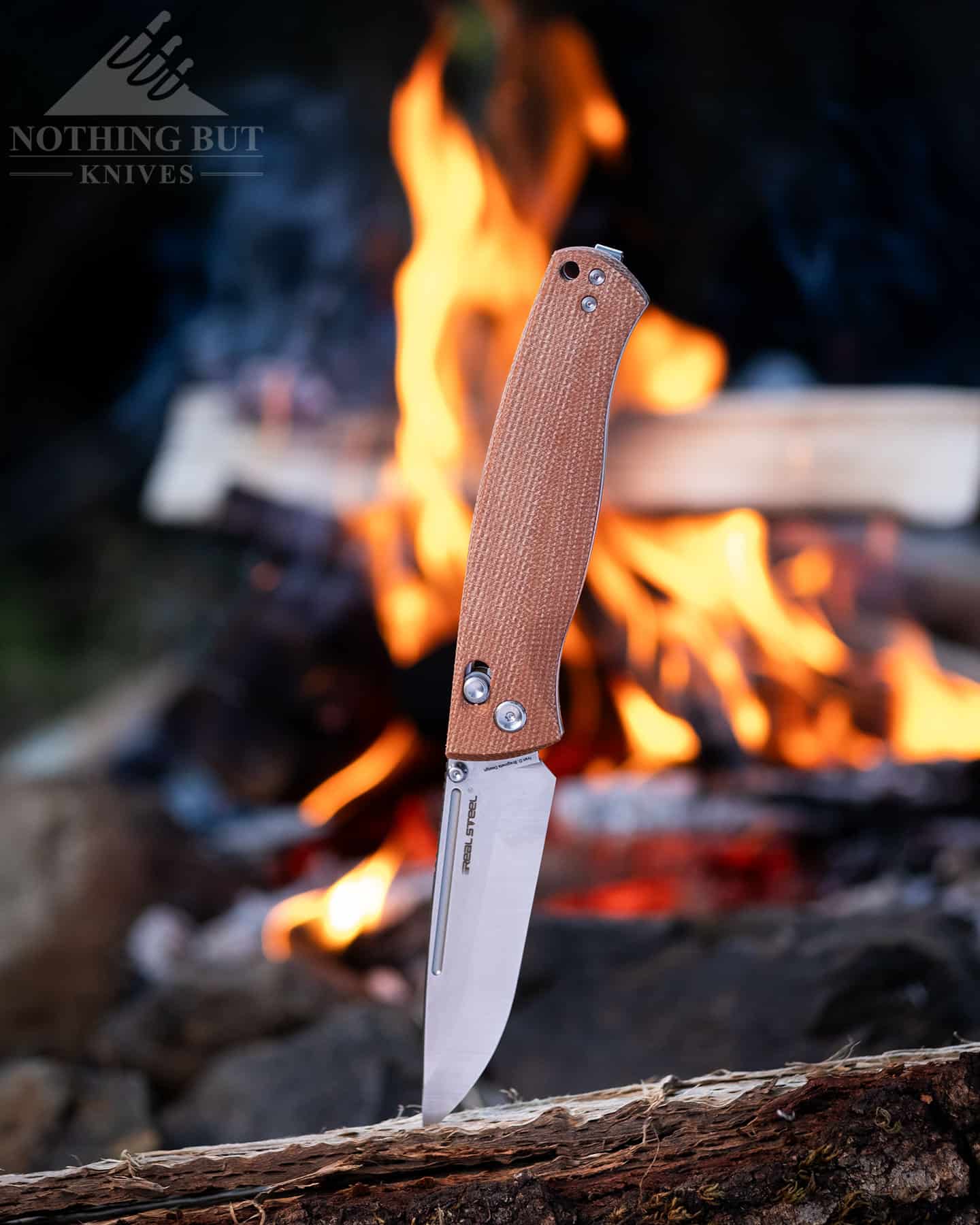
But it’s still a very clean design that works in a lot of situations. It’s easy to maneuver the knife into different grips, the handle has a good grip, the crossbar lock has a reassuring stiffness to it while still allowing for a snappy action.
It’s also pretty comfortable in the pocket for how large it is. It sits pretty securely into the corner of the pocket, and there’s no odd shaping to poke at anything else in there. It’s worth noting this is the folding version of a fixed blade by Real Steel and the same designer. We haven’t tried that one out yet, but our experience with the folding Pathfinder suggests it’s pretty dang good.
Best Folding Bushcraft KNife Under $200
This price range may be a bit steep for most folks in search of a bushcraft pocket knife, but we will test them out as knife companies release them.
Esee Pinhoti
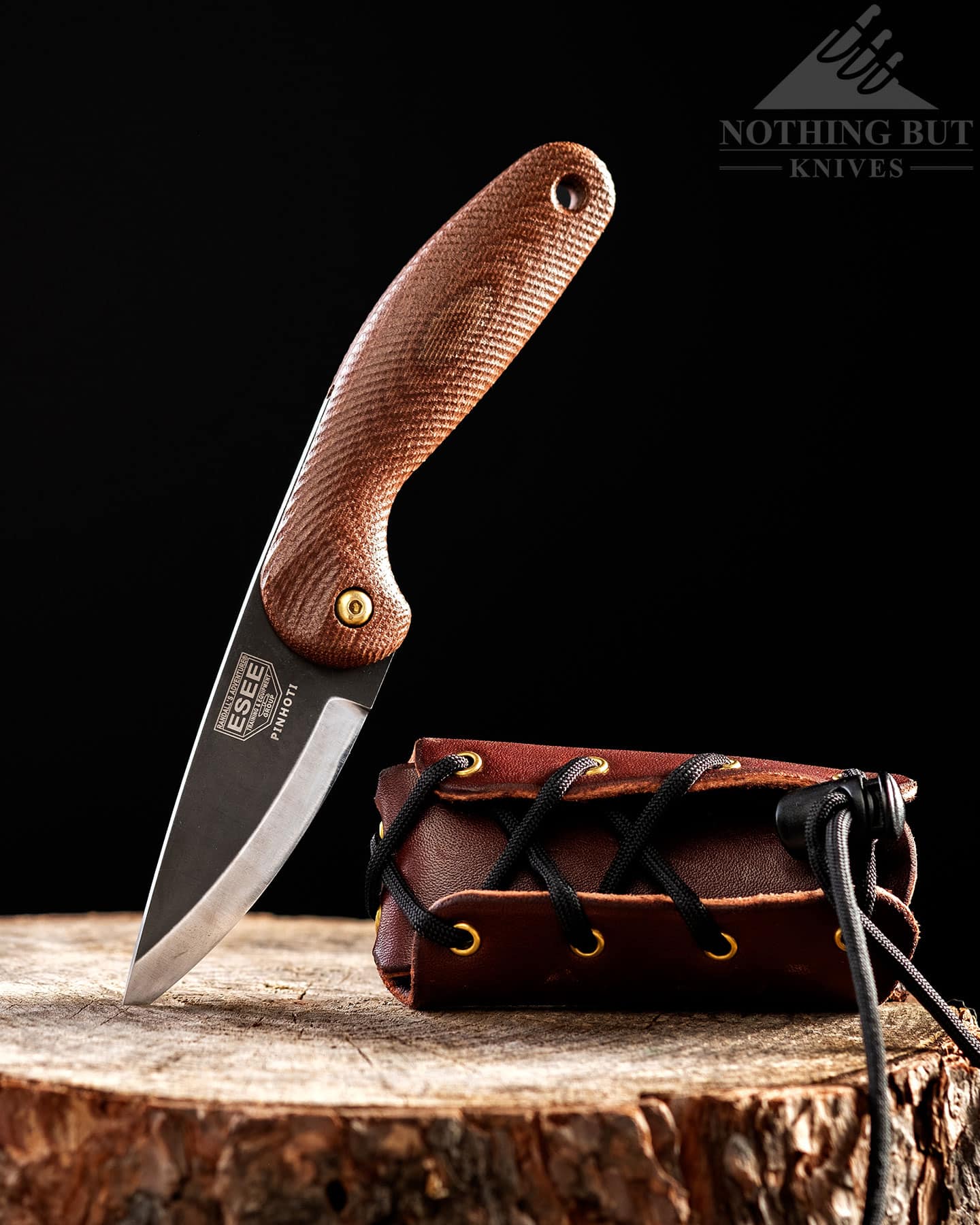
| Overall Length: | 8.25” |
| Blade Length: | 3.25” |
| Blade Steel: | 1095 |
| Blade Style: | Drop point |
| Blade Grind: | Scandi |
| Handle Material: | Micarta |
| Lock: | Friction |
| Sheath: | Leather |
| Made in: | USA |
| Designer: | Shane Adams |
The Pinhoti is still one of our favorite knives for starting fires. The extended tang that makes it work as a friction folder has hard ninety-degree angles that practically explode on a ferro rod. This was a very carefully thought out design, though, so pretty much every aspect of it feels optimized.
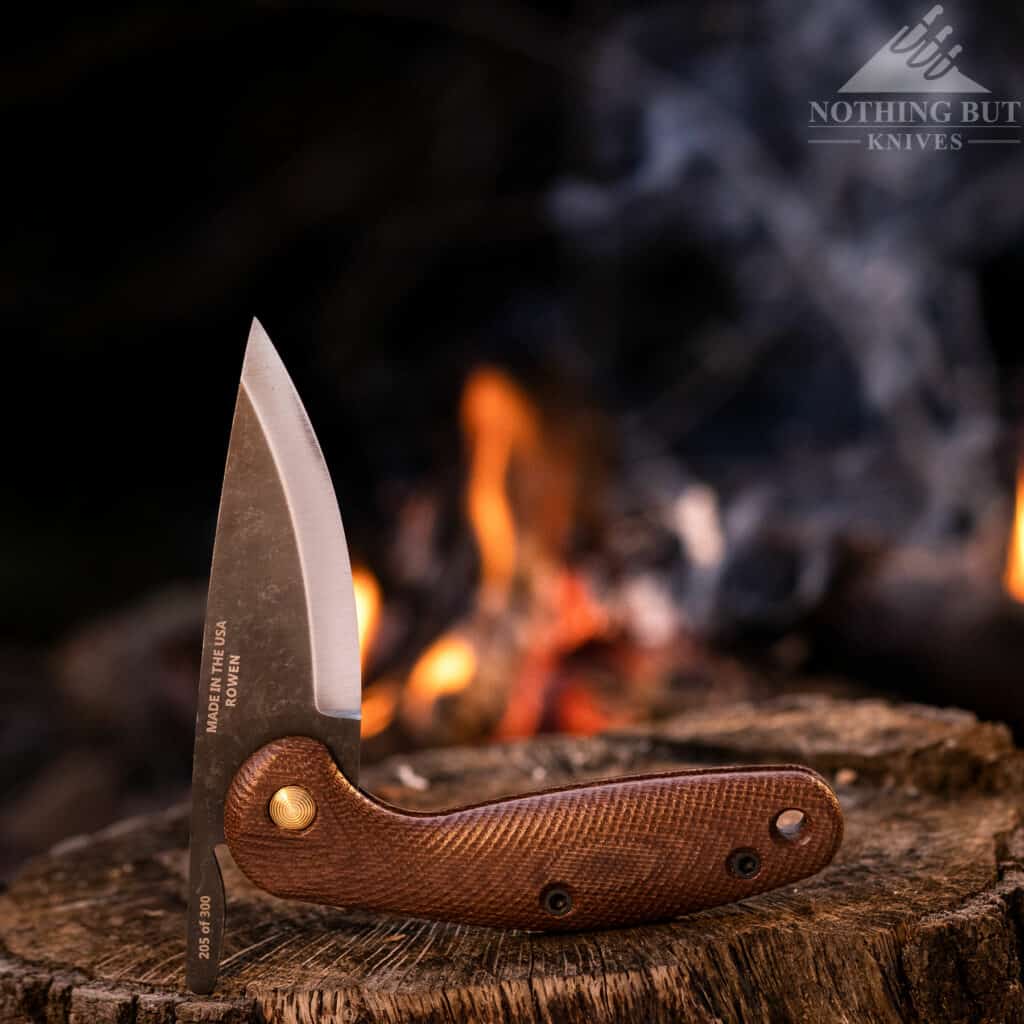
The scandi grind has a hard bite that melts through wood when you’re carving or making feathers, and the designer, Shane Adams, was especially concerned that the knife feels good in a standard and a reverse chest lever grip. The leather sheath can have its own functions, if you play with it. There’s leather cordage that could handle some light tying, or you could store a small survival kit where the cord is laced into the sheath.
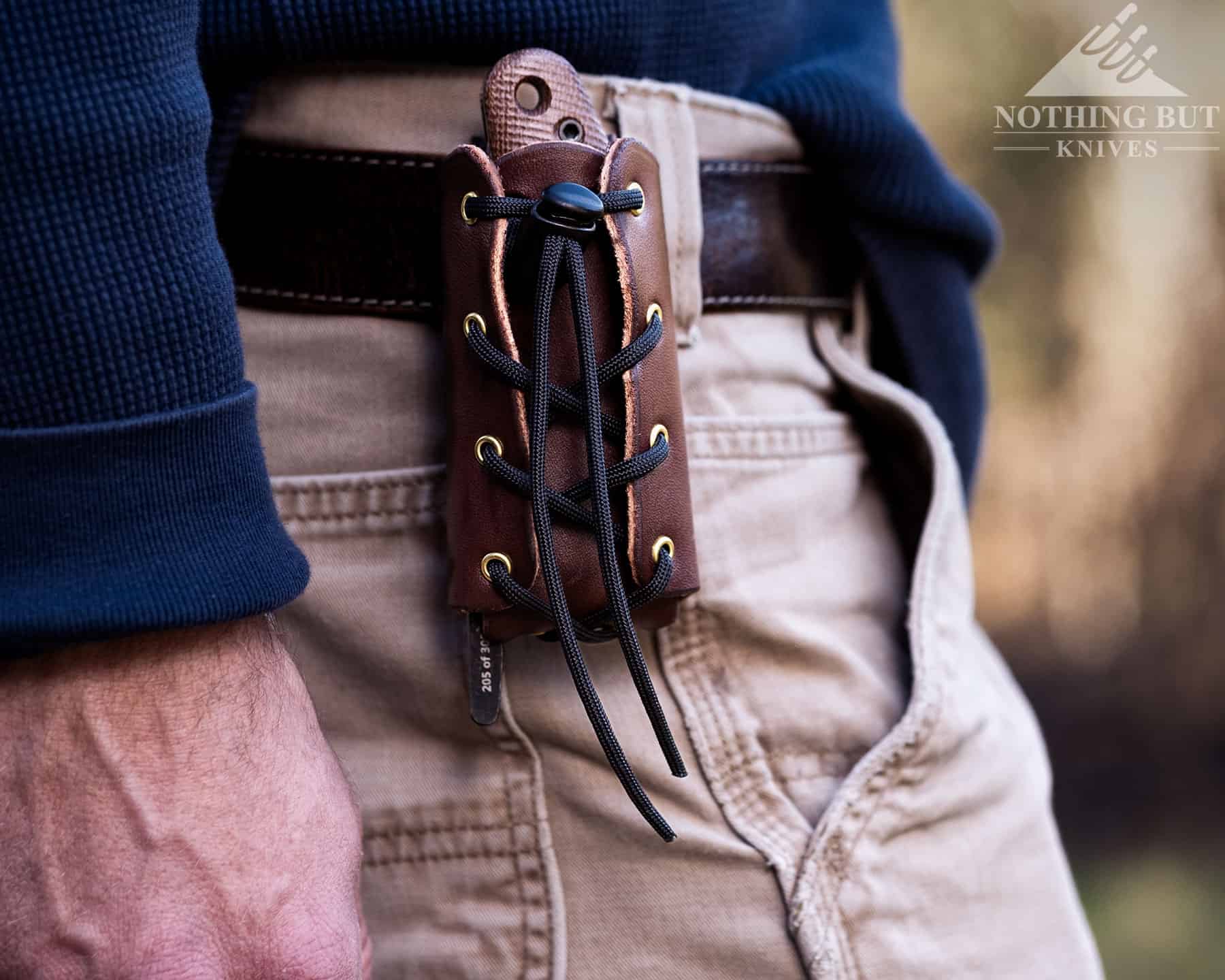
The ergos can take a little getting used to. It’s a friction folder, so the blade will move around as you carve and cut, but the shape of the handle usually keeps your hand safe, and once we got the nuance of it down we found some pretty unique ways of holding the knife that worked really well. You can read the full review of the ESEE Pinhoti here.
How We Test
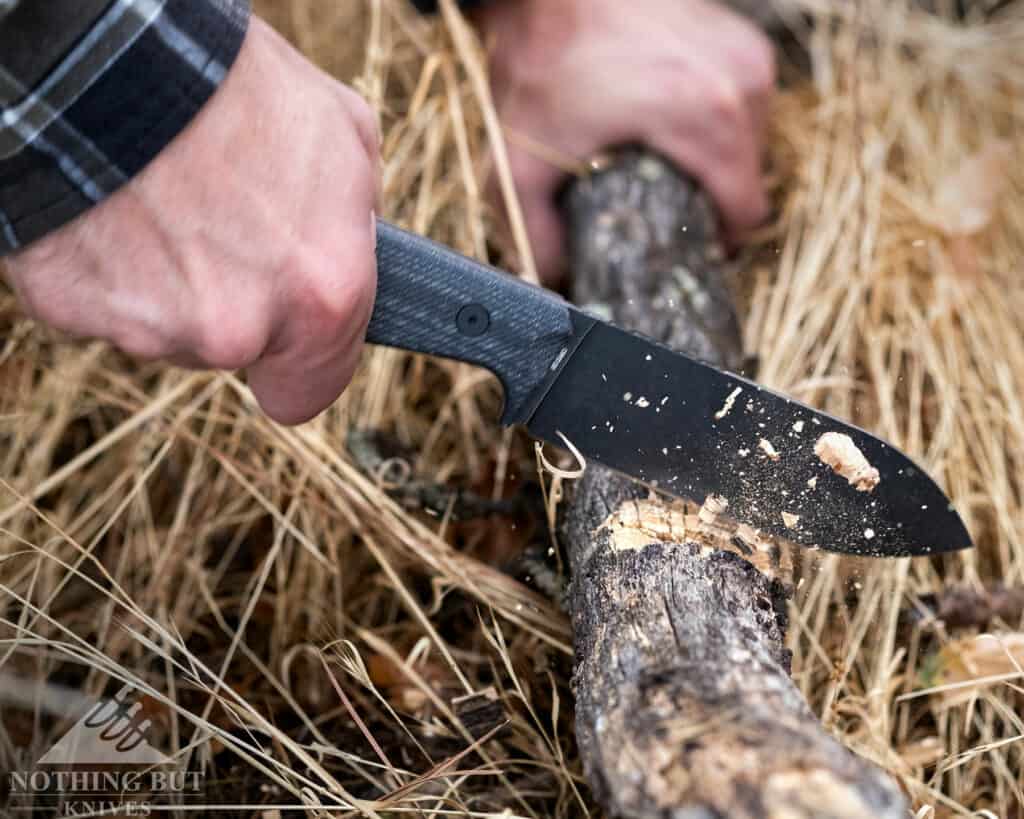
Mostly we did a lot of carving, hiking, and cooking. We have this problem where we aren’t particularly good at carving out tools or making traps, but we’ve played with enough knives to know when one can carve out a little smoother than another, and we’ve managed to cook several meals over a campfire without poisoning ourselves.
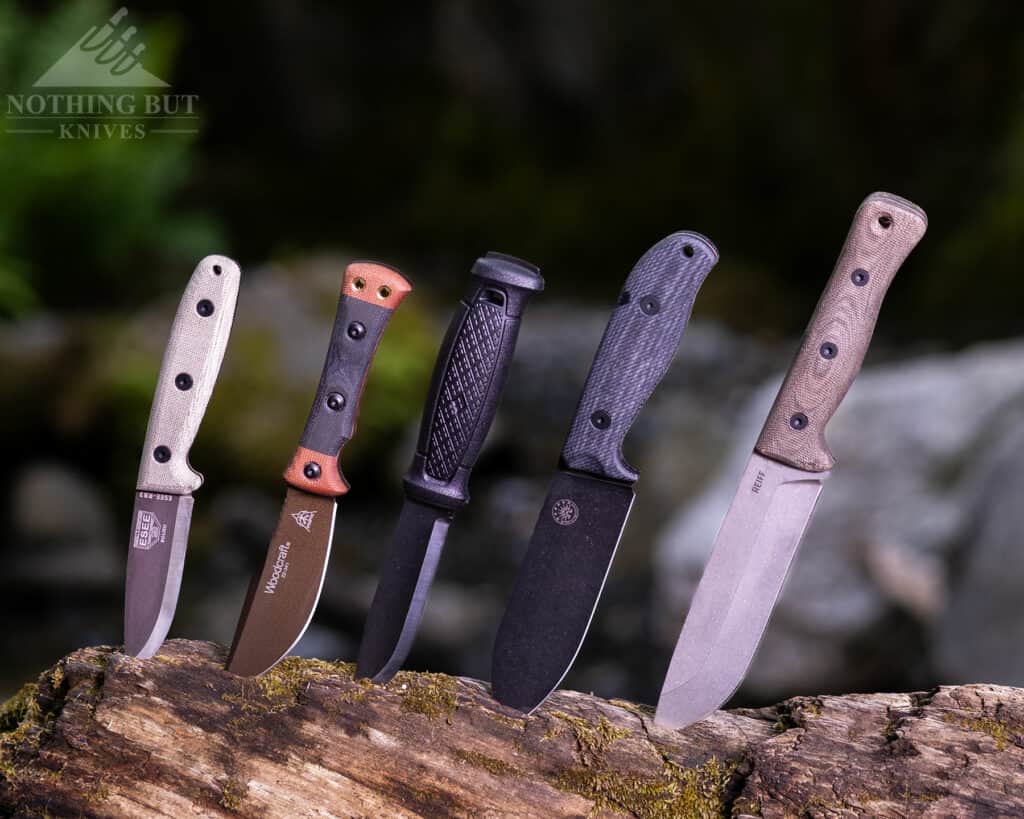
Horace Kephart, who was probably the godfather of camping for leisure, said in his book Camping and Woodcraft “a camper has use for a common-sense sheath knife, sometimes for dressing game, but oftener for such homely work as cutting sticks, slicing bacon, and frying ‘spuds’.”
Obviously, there are other uses covered under “bushcraft” these days, but that quote pretty much covers the philosophy we had in mind while testing.
What is a Bushcraft Knife
The key word here is “craft”. A bushcraft knife is all about making things in, and out of, the wilderness. Most of the time designs prioritize wood since that’s generally what survivalists and serial campers make shelter, traps, and tools with, but bushcraft includes anything from foraging for food to making cordage.
So a bushcraft knife should be able to work easily with wood, bark, twine, various fruits and vegetables, vines, and whatever else around you is soft enough to be pared down into a different, more useful shape.
Which leads to a really important caveat to the bushcraft definition: a good bushcraft knife is going to be different in different environments. Mostly it comes down to whether you’re going to be wearing gloves most of the time you’re using the knife, but it’s also worth questioning whether you want to deal with a rust-prone high carbon steel in a wet jungle environment.
What tasks should you expect a bushcraft knife to perform well
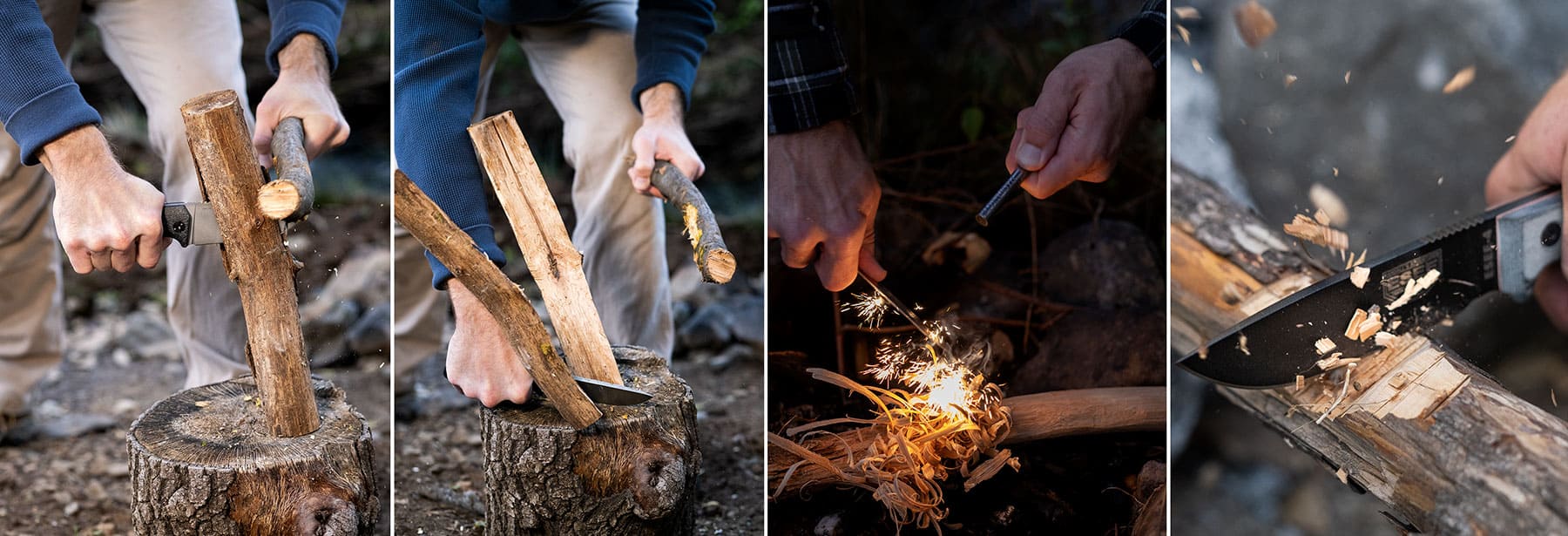
There are 5 C’s of bushcraft you need to think about when thinking about what you’re going to do with this knife: cutting, combustion, cover, containers, and cordage. A knife either benefits or benefits from all those elements.
- Cutting should be obvious: Does the thing cut?
- Combustion: can it make fuel and light that fuel for a fire?
- Cover: Maybe you brought a tent and just want a windbreak, or maybe you’re going barebones and need to make a lean-to. Either way, a good bushcraft knife is pivotal in carving out stakes and shaping pieces for a structure.
- Cordage: Strictly speaking this isn’t knife related, but having rope or knowing how to make or obtain rope is pivotal in the wild. In some places you can cut cordage down in the form of vines, and in some places you have to do some tedious weaving and tying. The knife can come up a lot in harvesting materials for this kind of thing, though.
What type of knife is best for bushcraft?
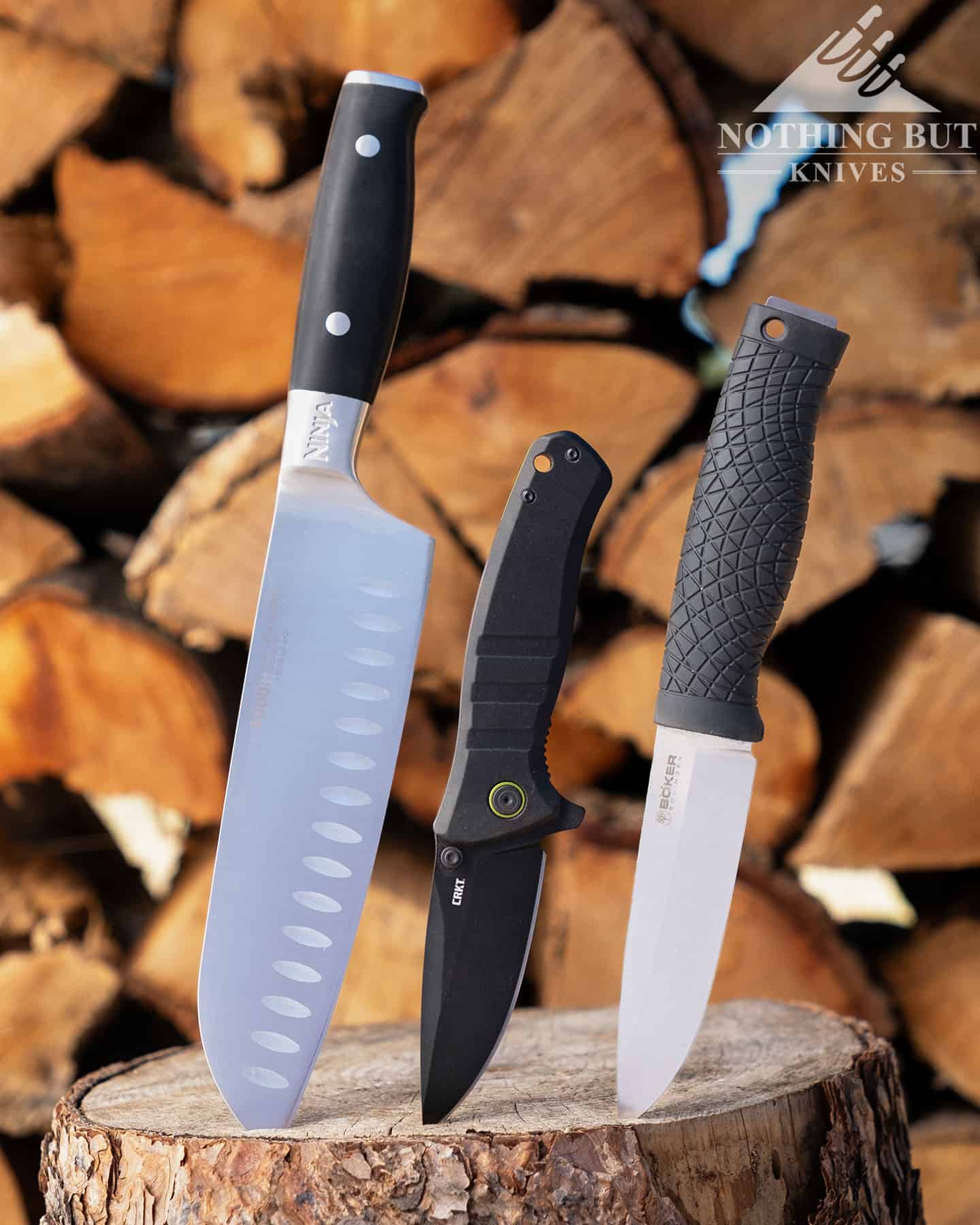
Bushcraft knives aren’t complicated. They really just need two key elements: a wide, comfortable handle, and a tough blade with a bit of a bite.
There are considerations within those elements, though: The shape of both the handle and the blade should be fairly neutral, and the blade grind should either be scandi or flat. There are dozens of variations on scandi and flat grinds, but trying to get into the weeds on all of them would end up being its own article, so just know that it’s not as simple as “convex is good for wood stuff”.
Here’s a quick general guide on which edge grinds tend to be best for which range of tasks:
- Convex grind: feathersticking, batoning
- Scandi: carving and batoning
- Flat: cutting
- Generally the thicker a spine is the better it will be at batoning (but not always) and the thinner a knife is, the better it will be at cutting and carving (not always).
It’s also worth knowing that when we talk about a convex grind in particular, we’re talking about the geometry of the cutting edge, while the flat, saber, and scandi grinds are talking about the primary grind of the whole blade, but, again, this is getting into its own field of weeds. There’s actually a few great articles on edge geometry written by the people at AG Russel if you want to get into it.
If you are looking for somthing that is more survival knife and less bushcraft check out are Top Survival Knife Beatdown article.
What About the Handle
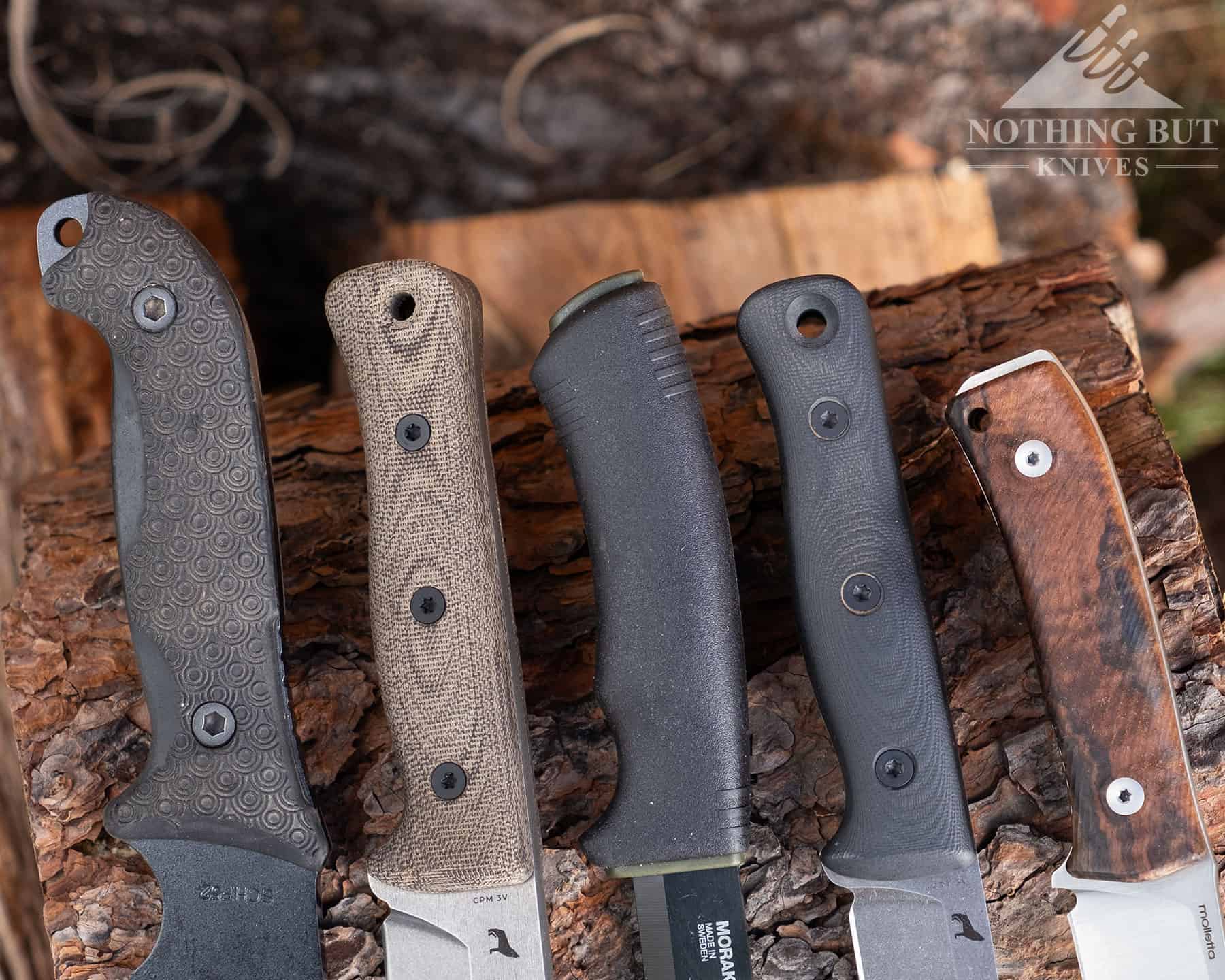
This is probably the most important aspect for a bushcraft knife, and it’s also the hardest one to give general recommendations on because all hands are different.
A couple things to keep in mind as you look, though:
- Hidden tang is better for cold weather conditions (contact with cold steel in sub-zero temperatures is not a pleasant experience)
- Usually a neutral shape is better because the more heavily contoured a handle is the higher the chances of it having a hotspot, and it tends to complicate different grips like the chest lever.
- A wide pommel makes it a lot easier and safer to chop with a knife
- A wide handle makes it easier to control your angle while carving (just not so wide that it feels awkward)
- You don’t usually need a finger guard on a bushcraft knife
What is the Best Bushcraft Knife Length?
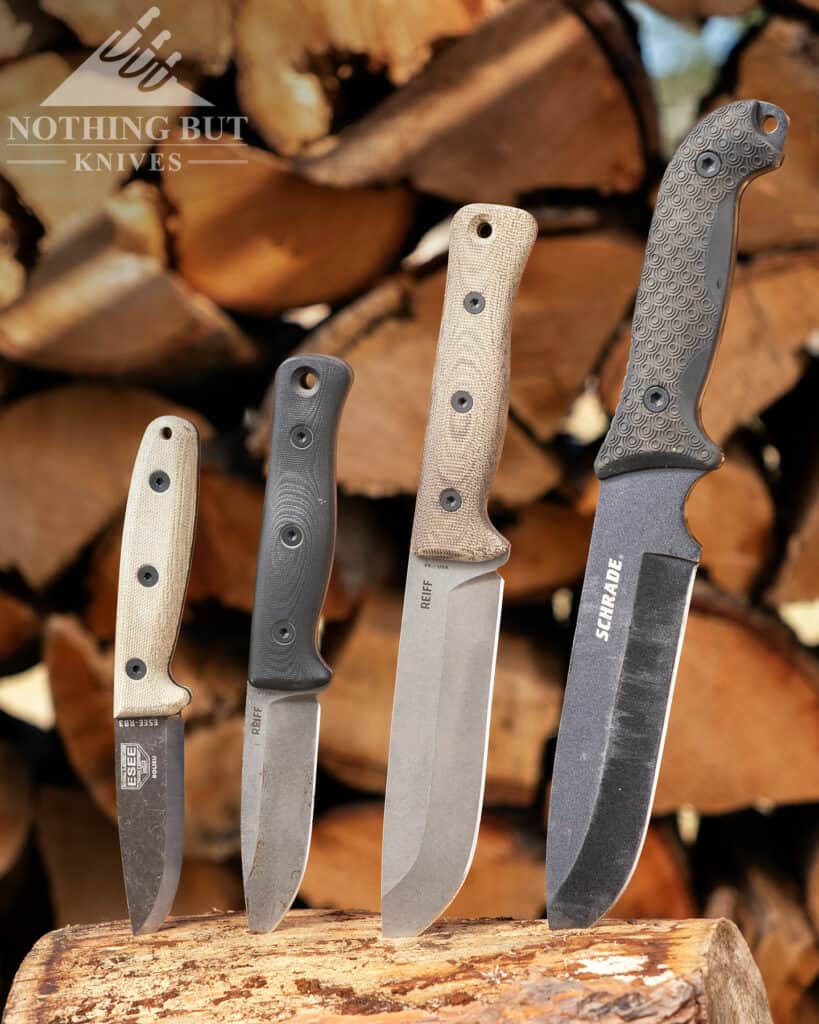
A knife with a three to five inch blade is probably the sweet spot for it to be easy enough to do detailed carving for traps, shelter, and tools, but big enough to handle larger scale wood processing like chopping and batoning. There is no “best” length for bushcraft exactly, though. There are better lengths for certain tasks. It’s more about finding the right size and fit for the kind of environment and camping you plan on doing.
If you’re driving out into the woods with your own tent, then the only bushcrafting you might need to do is processing wood for a fire, and at that point you might be better off with a hatchet.
If you’re going on a long through hike with nothing but a lightweight pack on your back and a good knife, then you’ll want something that can chop and carve at your hip but isn’t too heavy.
Here’s a quick guideline:
- 3 inches and under is for whittling,
- 3 to 5 inches is for carving,
- Over 5 inches is for chopping and batoning.
Feel free to comment with whatever coy euphamism crossed your mind while reading that.
